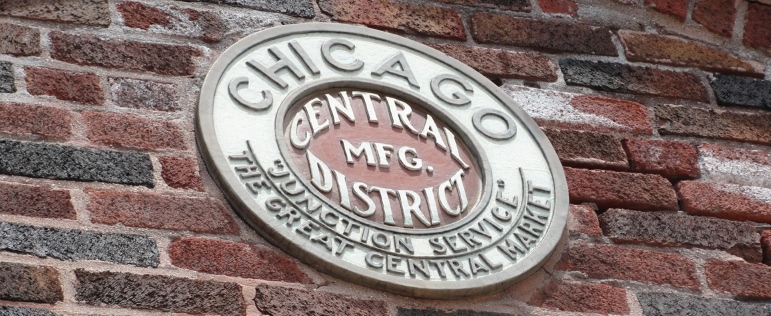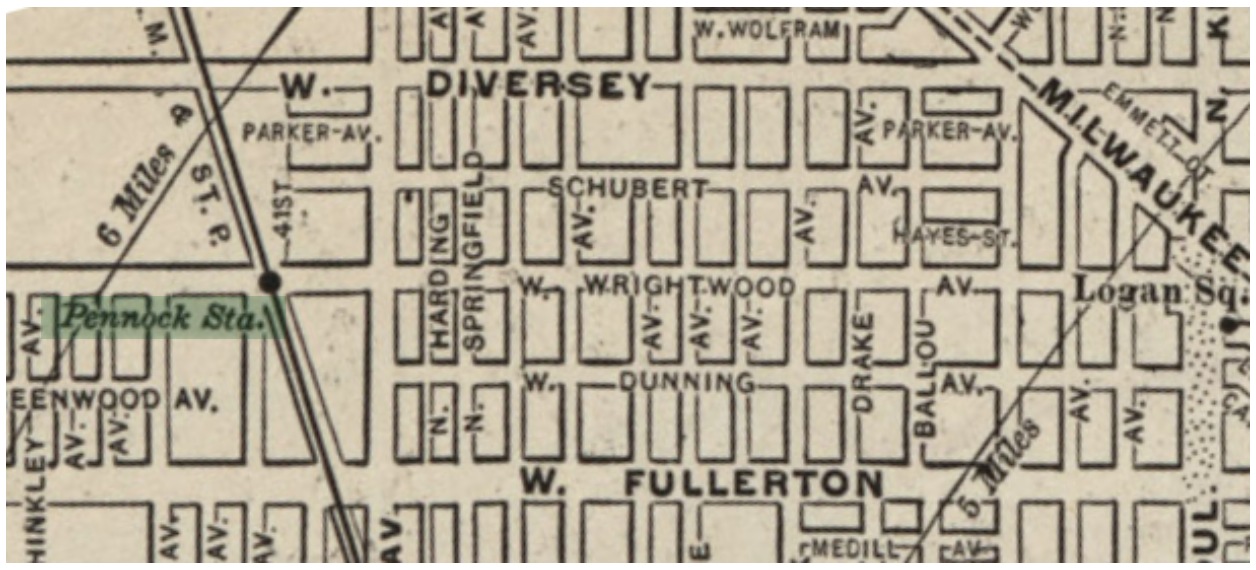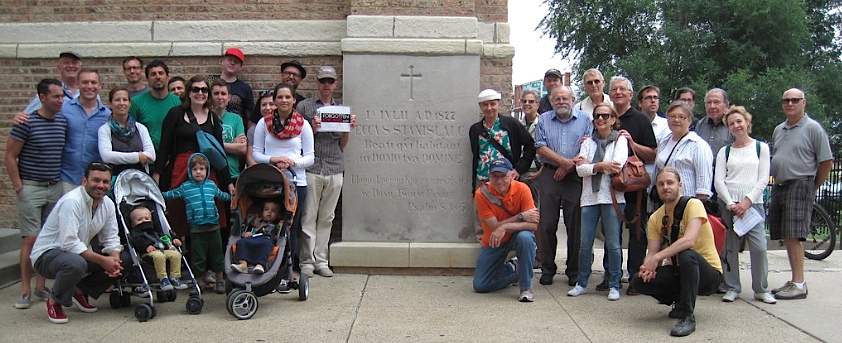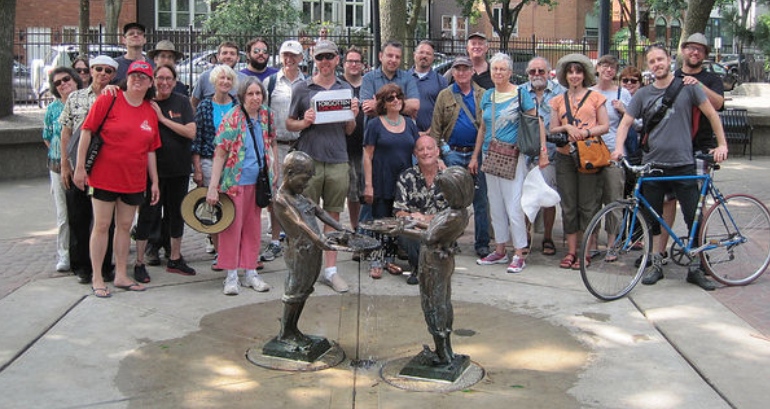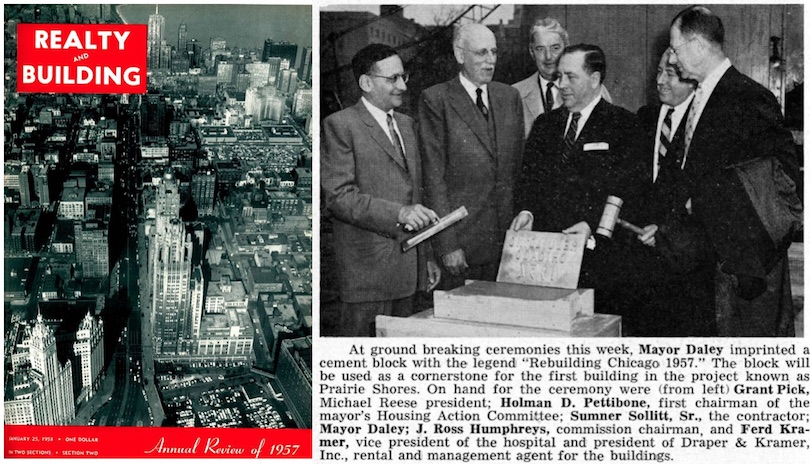
Realty and Building
In events, research and articles, Forgotten Chicago is continually striving to discover and share more about the unknown and forgotten history, culture, neighborhoods, and the built environment of our region. To add to our exclusive articles and programs, Forgotten Chicago has gone through more than 800,000 pages of non-digitized and non-indexed periodicals, planning documents and reference works from the 1880s to the 1990s, assembling a vast archive of 45GB of data and more than 30,000 articles, images and ephemera on the Chicago area.
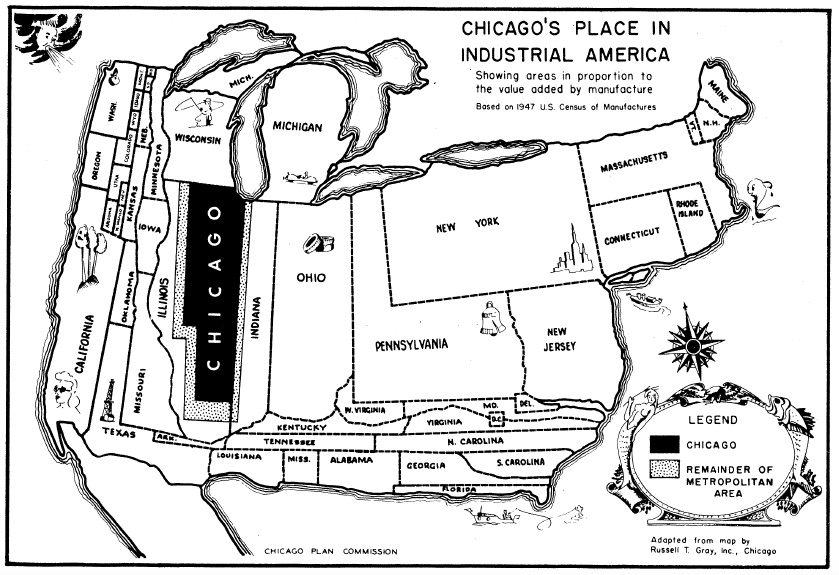
Chicago Plan Commission Annual Report 1952

A Half Century of Chicago Building
Forgotten Chicago’s proprietary database includes local and national architecture and business magazines, non-digitized university and library collections in Illinois, Indiana, and Wisconsin, telephone directories, trade journals, business directories, and much more. Most of these images have never been reviewed or scanned by any other organization, with thousands of articles and images unknown and unseen in decades, including nearly all of the historic images in this article.
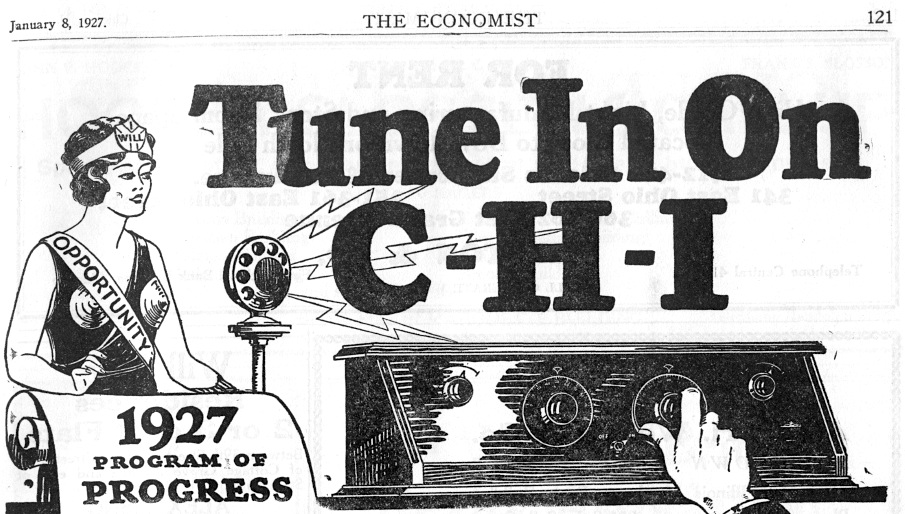
Our proprietary research database includes more than 6,500 articles and images from the Chicago real estate and building magazine The Economist / Realty and Building from 1925 to 1994, an invaluable and non-digitized research tool that ceased publication in 2003. We have taken a particular interest in researching and finding remnants of Chicago’s enormous and little-studied real estate bubble in the 1920s.
The Economist was an enormous promoter of real estate speculation, and would publish no fewer than 3,500 pages annually in the second half of the 1920s. Seen above is a portion of an ad for the Bert H. Laudermilk Realty Association encouraging wildly speculative investing at the height of Chicago’s real estate bubble in 1927; Chicago’s almost comical overbuilding in the 1920s is detailed in a popular 2014 Forgotten Chicago article.
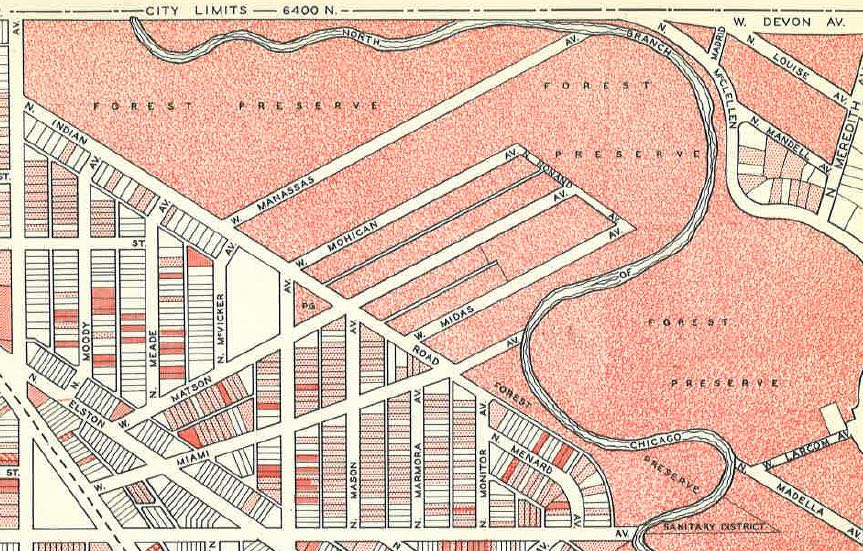
Master Plan of Residential Land Use of Chicago, 1943
The area around what is now the Edgebrook Golf Course on the Far Northwest Side was notoriously plagued with vacant lots and ghost streets and alleys for decades following the 1929 stock market crash. An exhaustively researched report published by the Chicago Plan Commission in 1943 details phantom developments such as this, along with every neighborhood in the city. Today, streets such as Midas, Mohican and Nonand have all vanished, and residential lots shown in white undeveloped until after World War II. Forgotten Chicago explored the curious neighborhood in the upper right corner of this map in another popular 2009 article.
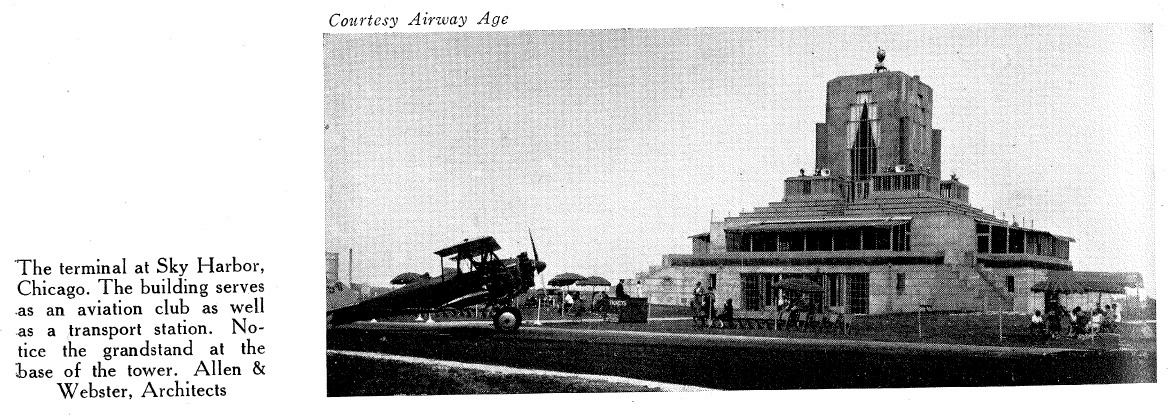
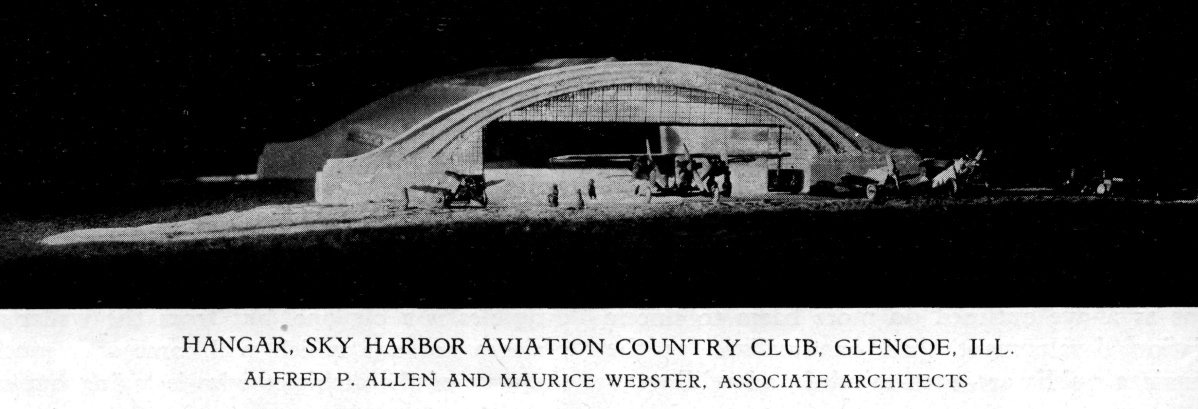
Top: Architectural Forum Bottom: American Architect
Forgotten Chicago’s database contains a largely unknown and little-seen record of Chicago history, development and architecture; seen above is the former Sky Harbor Airport in the north suburbs. While the distinctive Art Deco terminal was demolished more than 75 years ago, Sky Harbor’s hanger remains standing today, and was visited during a 2013 Forgotten Chicago tour.

Architectural Record
In 2014, Forgotten Chicago discovered a previously unknown mid-1950s Chicago-area project by Henry Dreyfuss that remains extant as of this writing. Henry Dreyfuss (1904-1972) was a leading American industrial designer of the twentieth century, responsible for the design of everything from tens of millions of telephones built by the Western Electric subsidiary of AT&T in Cicero, Illinois to the iconic Honeywell home thermostat and 1930s trains for the New York Central Railroad.
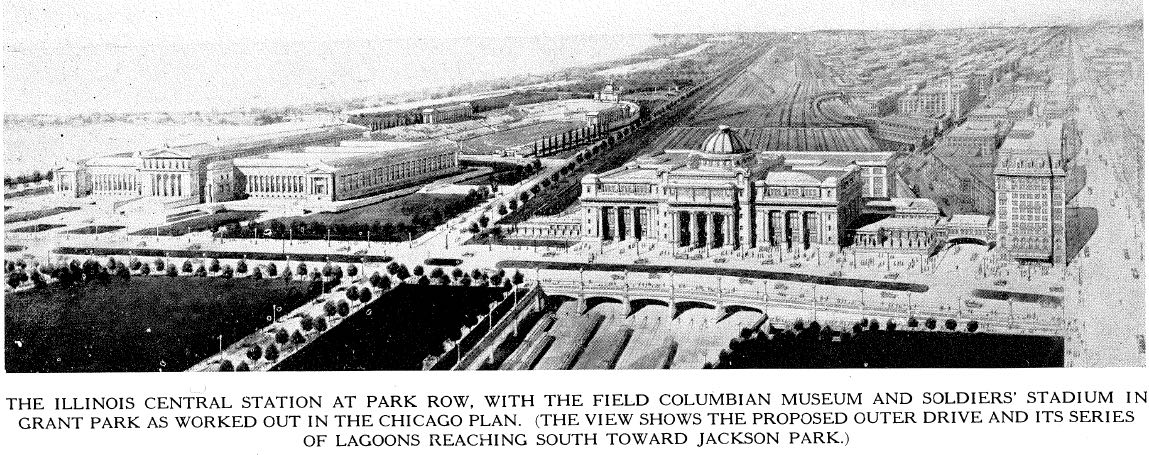
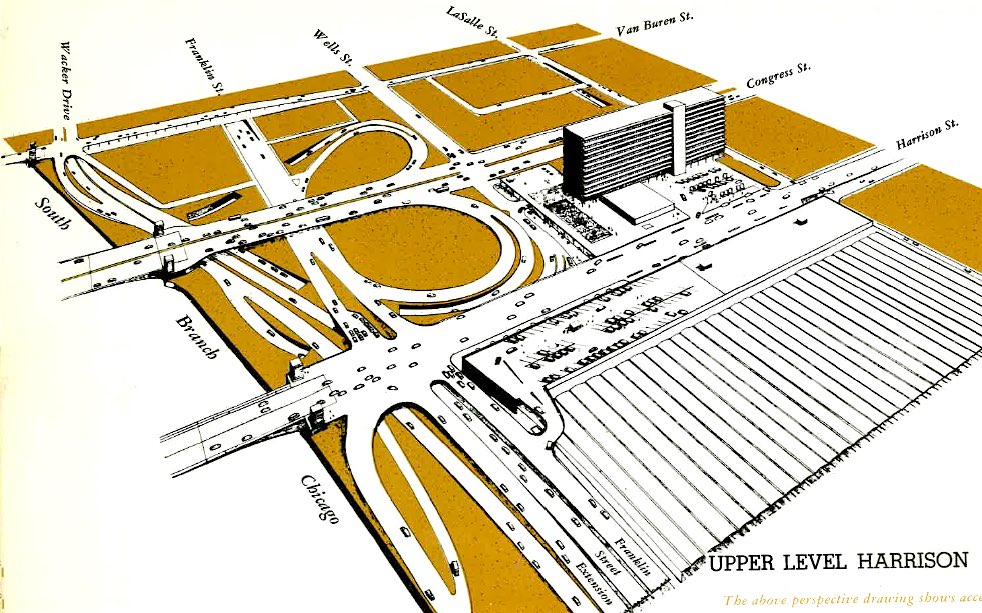

Top: Western Architect, 1926 Bottom: Chicago Plan Commission, South Side Consolidated Railroad Passenger Terminal for Chicago, 1953
Forgotten Chicago research has also discovered previously unknown & extant Chicago area works by Bertrand Goldberg, Tallmadge & Watson, Paul Schweikher, Monroe Bowman, Minoru Yamasaki and other internationally recognized architects. Forgotten Chicago uses our research extensively in our events and presenations.
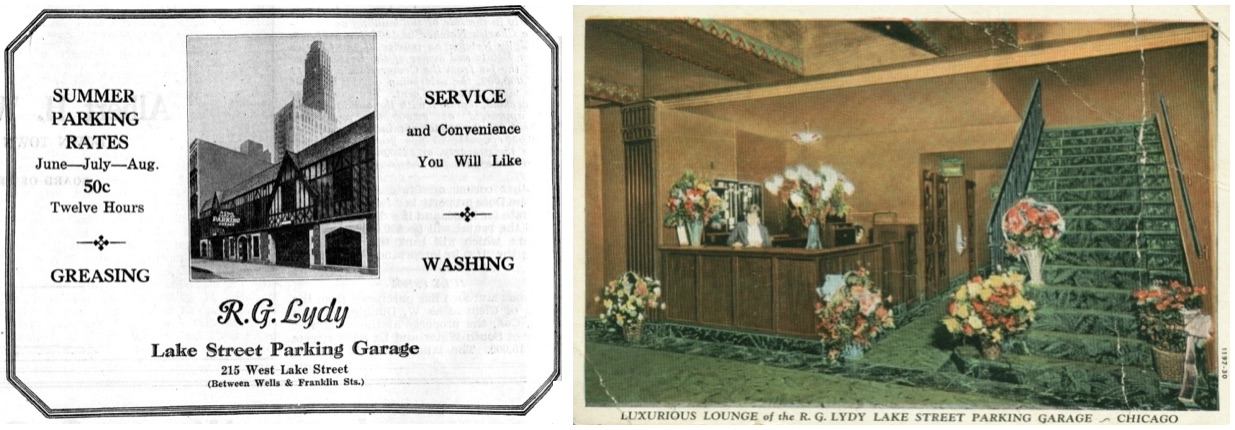
Top Left: The Economist, 1929 Top Right: Chicago History in Postcards
Parking garages have long been of interest to Forgotten Chicago in research, presentations and tours. Chicago’s municipal parking garage program, the largest such program in the world at the time, was in operation starting in 1955 until being privatized staring in 1979, as examined in a 2008 Forgotten Chicago article.
One of Chicago’s many deluxe privately funded garages was built by Richard G. Lydy on West Lake Street in 1929 as seen above top, and included a carpeted lounge. Visited during several of Forgotten Chicago’s Downtown Confidential tours, this structure was demolished in early 2016.
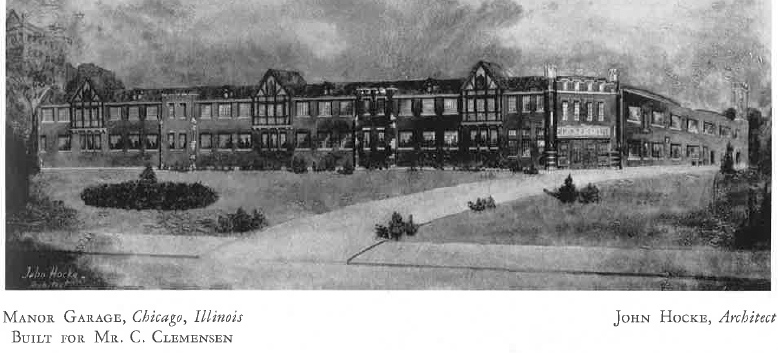
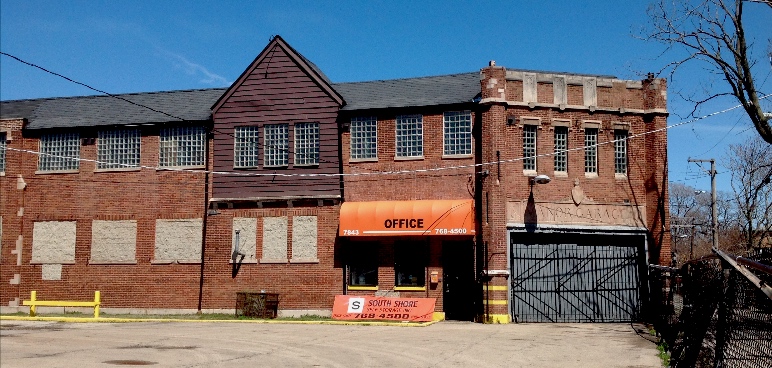
Top: The Western Architect, 1929 Bottom: Patrick Steffes, April 2016
Another private garage was built by 1928 for a Mr. C. Clemensen in the booming South Shore community, as seen above top in the 1920s, and again above bottom some 90 years later. Designed to resemble an idyllic apartment building in a park-like setting, this structure remains intact, although altered as of this writing, with Manor Garage still clearly visible and carved in limestone above.
Thank you to everyone who have joined us during presentations and during tours over the years. Forgotten Chicago is looking forward to sharing more unknown stories of the development and history of our region in the years ahead!
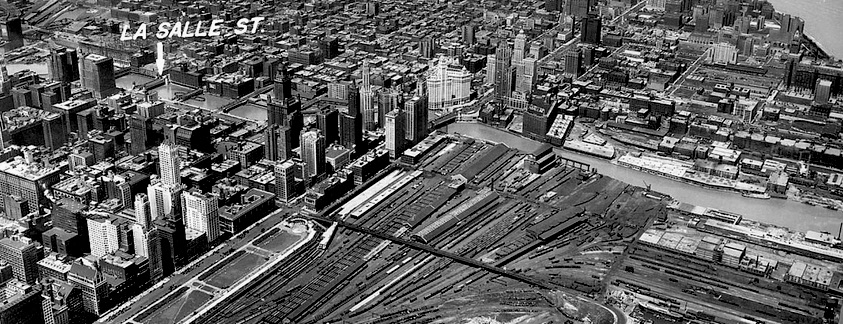
City of Chicago, no date
The countless forgotten remnants of Chicago’s Near North Side were a special focus of Forgotten Chicago in 2016 in a series of new and exclusive tours, never before offered by any organization. Utilizing Forgotten Chicago’s propriety research database of more than 25,000 Chicagoland articles and images, mostly non-digitized and unseen in decades, we took an in-depth look during three tours of the Near North Side at what remains from decades of planning and development, along with new projects, in these ever-evolving neighborhoods.
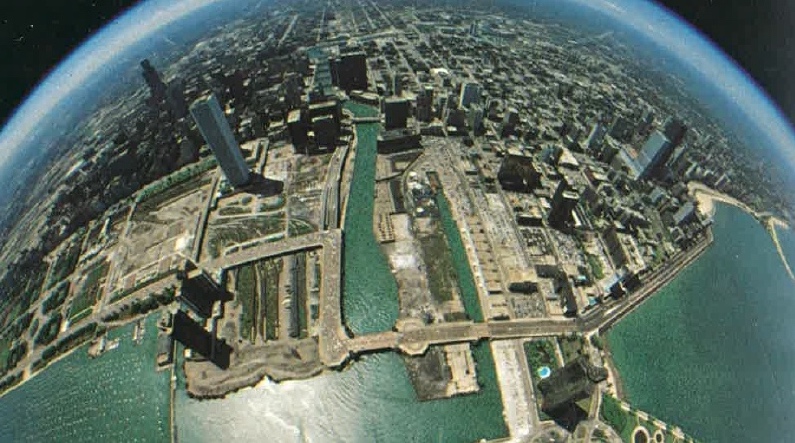
Inland Architect, 1980
A bleak post-industrial landscape less than forty years ago as seen above, the area on and around the Chicago River and Lake Michigan shorelines are still home to a surprising number of curious and overlooked remnants today. Without question one of the most desirable building sites in North America, developments near where Lake Michigan and the Chicago River meet has been subject to many development twists and turns for nearly 95 years. The stunning location of this neighborhood is currently home to significant and remarkable new developments, as discussed below.
See below for recaps on these three previously conducted Forgotten Near North Tours.
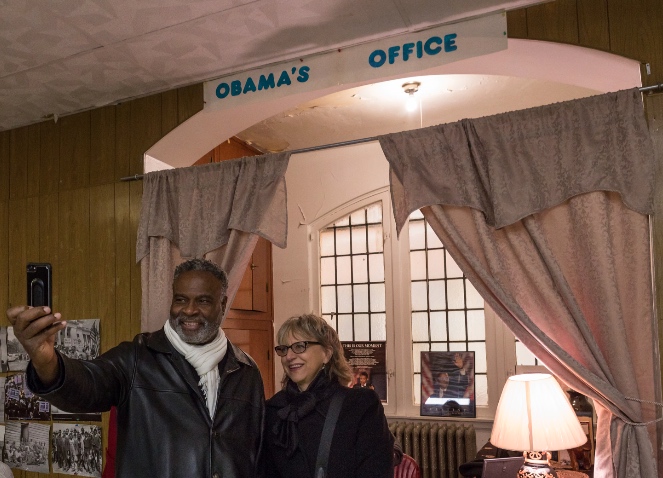
Matthew Kaplan
On Sunday, December 4, 2016, Forgotten Chicago and Pullman-area native Tom Shepherd presented an encore of our exclusive tour of sites crucial to the rise of Barack Obama in Chicago in the years before his first election to the White House in 2008. This exclusive tour was a rare opportunity to visit sites related to Obama’s years in Chicago and to hear from those who worked with Obama during his early career in Chicago, including staff and clergy of the Reformation Lutheran Church on East 113th Street. A young Barack Obama worked out of the church’s basement between 1985 and 1988, which was visited above.
Obama notably worked as a community organizer in the Pullman community, a portion of which was named a National Monument in February 2015. Pullman was established beginning in 1879 and would be known around the world as a “model” industrial town; its notorious labor troubles would become equally well known. Our tour discussed Pullman’s unique built environment, labor and industrial history spanning three centuries, and the role Obama played as a community organizer in this fascinating community.
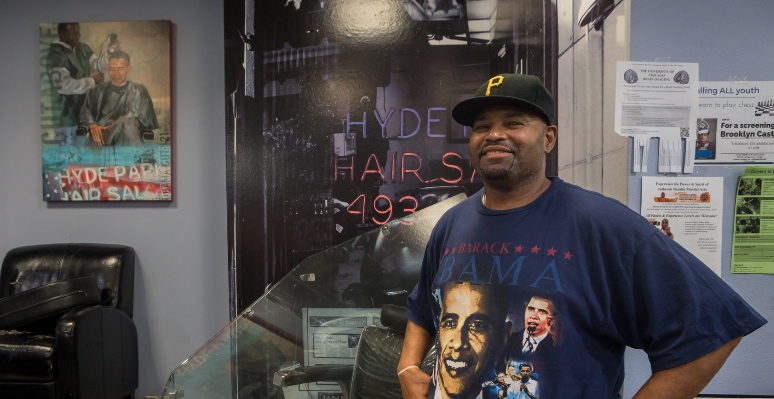
Matthew Kaplan
No tour of Barack Obama’s history and career in Chicago would be complete without a visit to Hyde Park, where Obama taught at the University of Chicago from 1992 to 2004 and from where he won his first election in 1996. This tour drove past some of the sites critical to Obama’s later Chicago career; many other notable Hyde Park landmarks were also seen and discussed. This tour also included a cafeteria lunch at Valois, one of the President’s favorite restaurants, as well as a visit to his long-time barber shop, seen above.
When Obama moved to Chicago from New York City, his political career notably did not begin in Hyde Park; he would start his work as a community activist on the Far South Side, including organizing in Altgeld Gardens, a Chicago Housing Authority community near the Calumet River built just after World War II. Offering first-person insights to Obama’s early career was Cheryl Johnson, Director of People for Community Recovery; Cheryl recalls the many times Obama spent at the Johnson home with Cheryl’s mother, the late Hazel Johnson to discuss environmental issues, jobs, poverty, housing, and other issues in Altgeld Gardens.
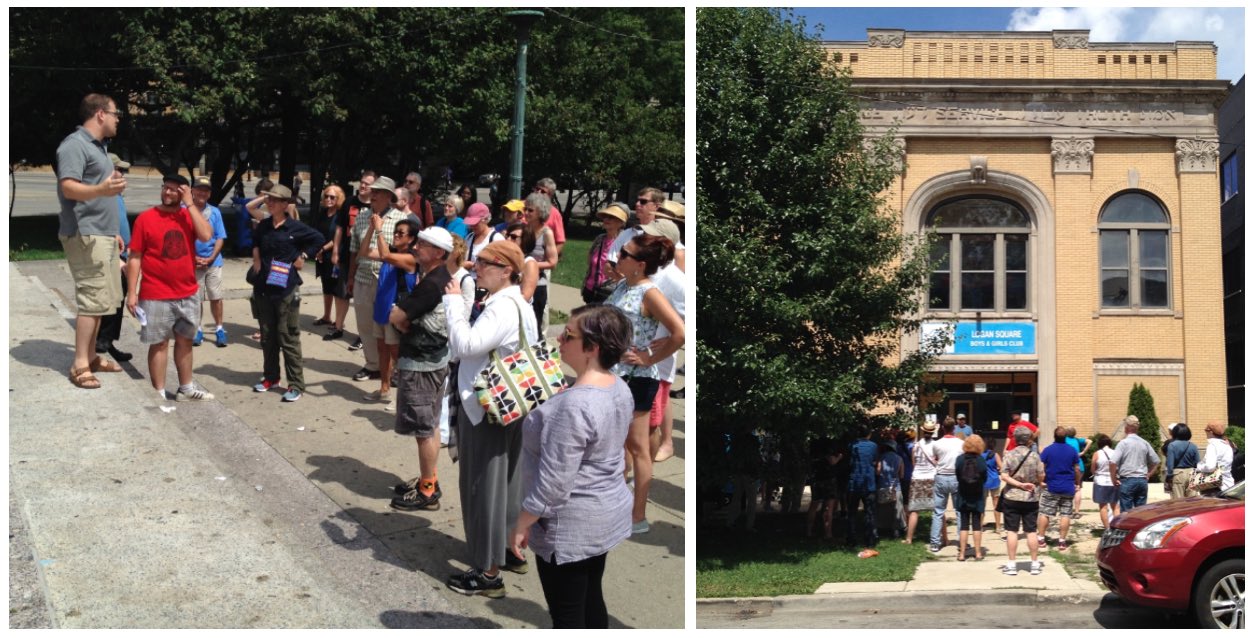
Patrick Steffes
A sold-out group joined Forgotten Chicago for our first walking tour of Logan Square on Sunday, August 14, 2016, Joining us above far left was Andy Schneider, President of Logan Square Preservation, who gave us a unique perspective on this neighborhood’s remarkable built environment and rich ethnic history. One of the thirty sites visited included a former synagogue above right that has been converted to a Boys & Girls Club.
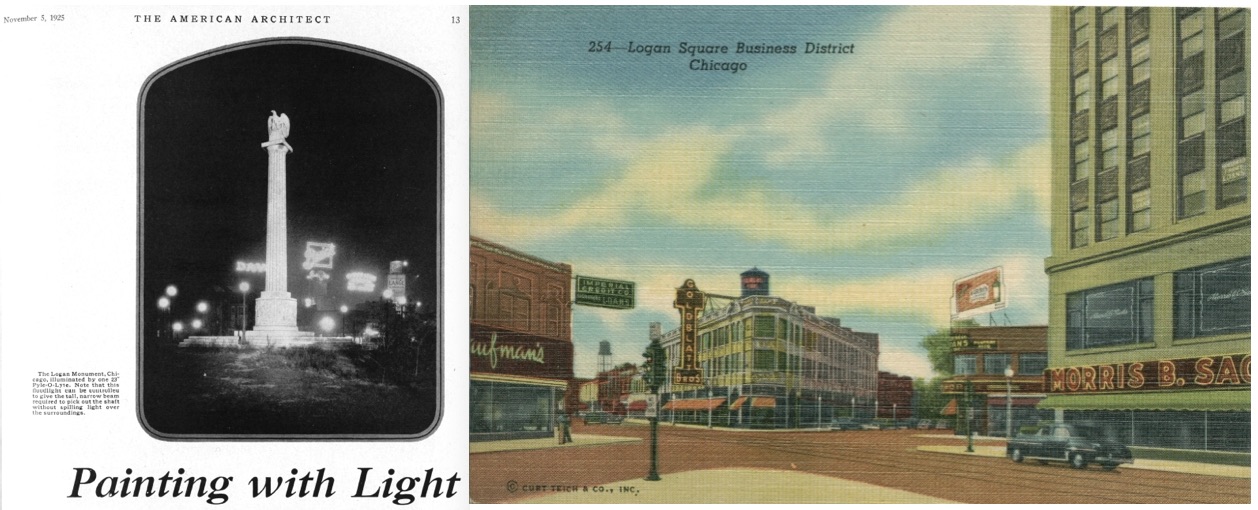
Left: American Architect, 1925 Right: Chuckman Collection
Also discussed was Logan Square’s vibrant commercial district, former movie palaces, long-vanished retailers and the transformation that occurred before and after the Milwaukee Avenue subway extension opened in 1970. We also discussed the factories that employed hundreds, taverns that served as de facto social clubs for workers, and the housing stock that served many waves of new immigrants, including those from Poland, Belarus, Norway and Latin America. Many thanks to those who joined us as we explored Logan Square during perhaps its most dramatic transformation yet.
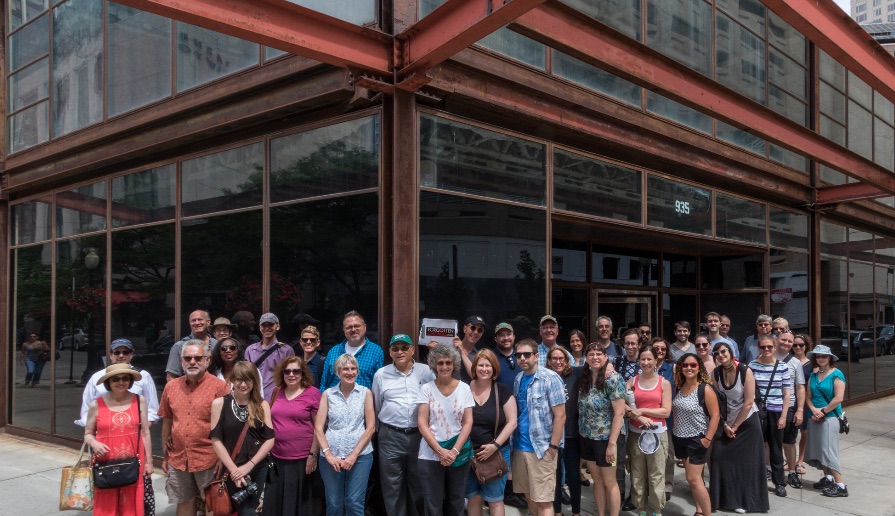
Matthew Kaplan
Bertrand Goldberg’s built, unbuilt, demolished, and threatened work on and near North Rush Street was the focus of an exclusive Forgotten Chicago tour on August 7, 2016, offered for the first time since 2012. A sold-out group joined us on a beautiful summer day as we explored this section of the Gold Coast, home to the largest group of built and proposed work by Goldberg in the world. Special attention was paid to Walton Gardens, an innovative and culturally significant retail and recording studio project at Walton & Rush that was nearly completely intact from 1956 until major alterations began on this project in 2016. We were honored to have Goldberg’s son Geoff join us on this tour, offering fascinating insights into his father’s remarkable career.
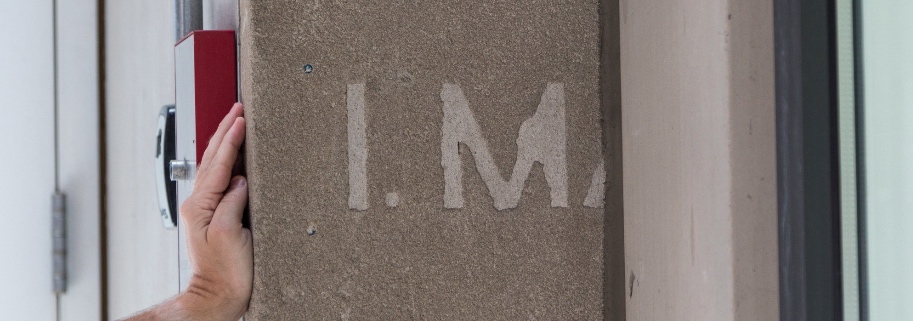
Matthew Kaplan
Integral to Goldberg’s early life and career in Chicago is the block bounded by Pearson, Michigan, Chestnut and Rush, detailed in a three-part series of Forgotten Chicago articles seen here, here, and here. We took a look at one long-vanished remnant of this block facing the Old Water Tower, the labelscar of I. Magnin & Company, a luxury retailer that vanished from Pearson and Michigan in 1992 but whose former presence can still be clearly seen nearly 25 years later.
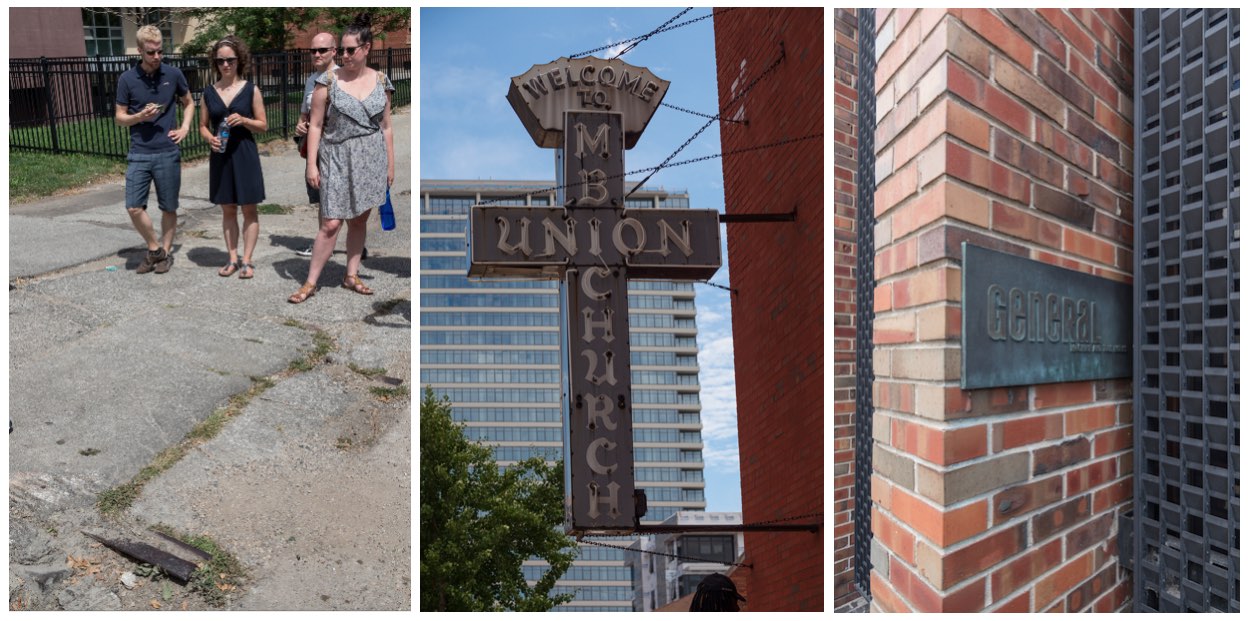
Left and Right: Matthew Kaplan Center: JaNae Contag
As with every Forgotten Chicago tour, we examined curious urban relics and remnants, all hiding in plain site and nearly all forgotten. This tour headed west to examine the area under and around the elevated tracks north of Chicago Avenue, including the long vacated North Sedgwick Street and its streetcar tracks, abandoned since 1947 but still visible today as seen above left. We took a look at the large number of churches along North Orleans Street, including the neon sign for the Union Missionary Baptist Church above center, and the remarkably intact General Machine & Tool Company, a project by I. Moses & Associates that won an Honorable Mention Award from the American Institute of Architects in 1967, another overlooked remnant in 2016 of the many former past lives of the Near North Side.
Many thanks to those who joined us on our final in a series of Forgotten Near North tours!
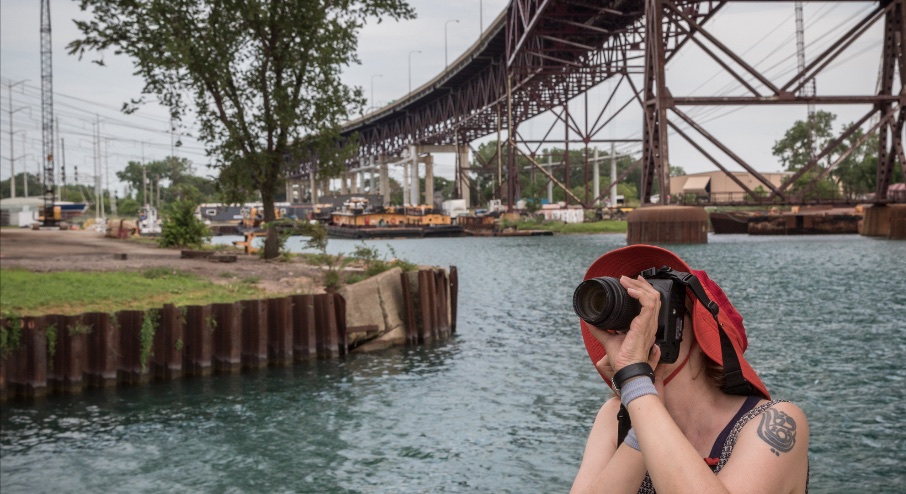
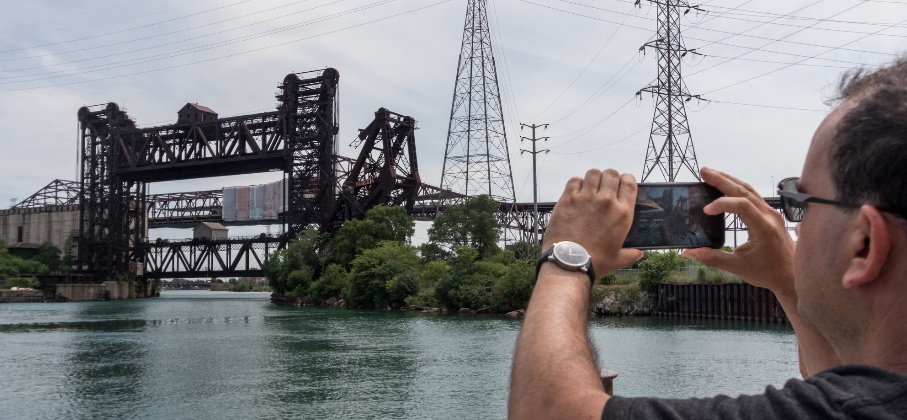
Matthew Kaplan
A sold-out group joined Forgotten Chicago on Sunday, July 17, 2016 for our exclusive Calumet River Boat Tour, offered for the first time since 2012, and a rare chance to see up close Chicago’s mighty (and often overlooked) industrial and infrastructure history. This tour included an exclusive opportunity to photograph some of the last remnants of Chicago’s once-vast steel industry. Leaving from just east of Soldier Field, a chartered boat took the group down Lake Michigan to the Calumet River inlet near the former site of the U.S. Steel South Works, explored in a 2008 FC article.
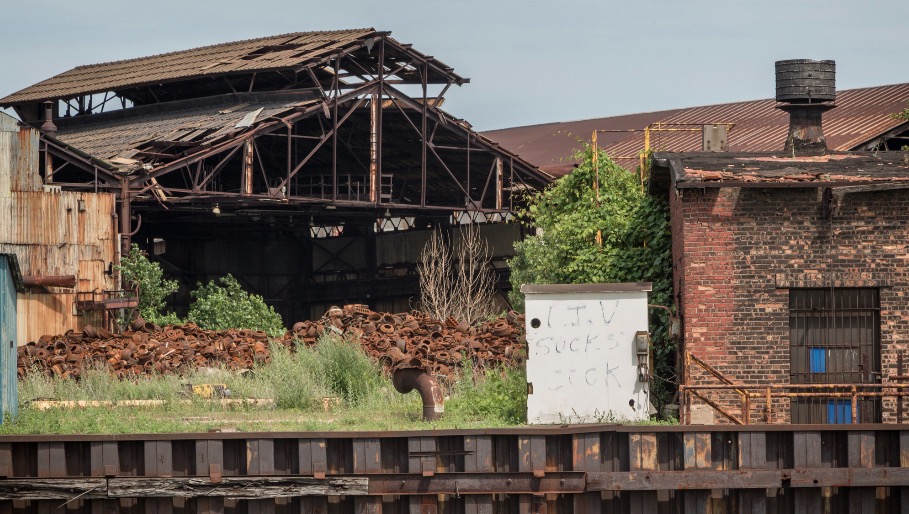
Matthew Kaplan
Heading down the Calumet River we discussed the historic sites where roaring blast furnaces once stood, as well as the last few steel mill structures still standing, some of which are currently under demolition. Our deluxe charter boat passed under a number of bridges, including the Chicago Skyway, railroad lift bridges, and bascule structures. The tour also viewed active industry, including massive grain elevators and bulk material handlers. Once we got to 130th Street, the boat turned around and head back the way we came, discussing more fascinating locations along the Calumet River and Lake Michigan.
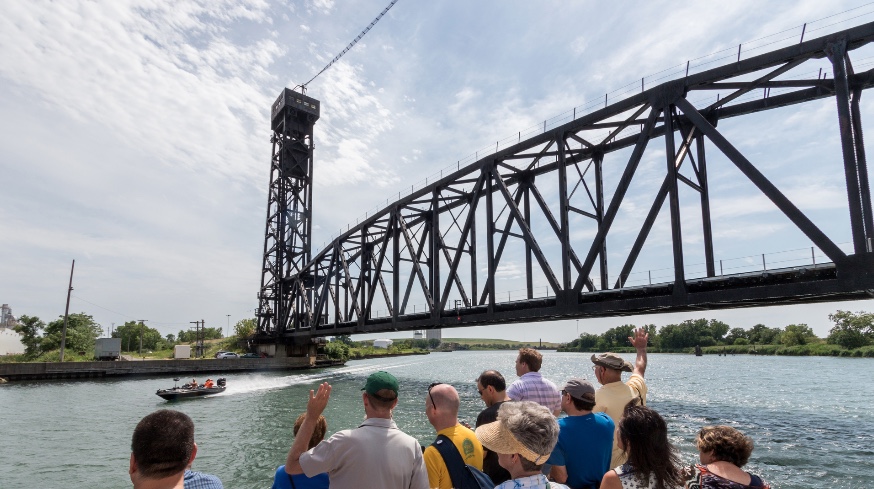
Matthew Kaplan
Included in the tour was unlimited beer and wine and an extensive lunch buffet, perhaps the perfect way to spend a glorius Sunday July afternoon. May thanks to those who joined us as we explored Lake Michigan and the Calumet River!
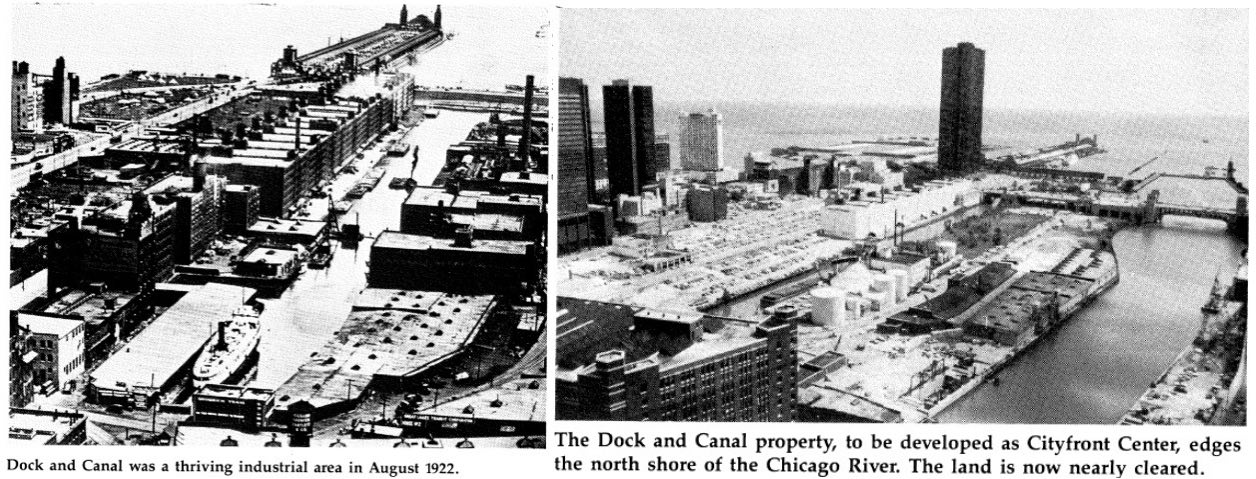
Inland Architect, 1985
A gorgeous summer afternoon was the backdrop on Sunday, July 10, 2016 for Forgotten Chicago’s first-ever tour in and around the fascinating area to the north and east of the Chicago River and Michigan Avenue, known for 140 years as the Dock & Canal Trust. This sold-out group enjoyed curious and mostly overlooked sites in the second of three exclusive Forgotten Near North series of events, never before offered by any other organization, and included what remains of the area’s long history of manufacturing, warehousing, and shipping.

Matthew Kaplan
Covering more than 175 years and featuring evidence of Chicago’s development and growth from 1839 to 2017, our Dock & Canal Trust tour examined everything from early heavy industry to the largest and highest-profile abandoned vertical shopping mall in the U.S. (photo below right) Curious and often-overlooked remnants abound in this area, such as the 1937 Jubilee Plaque commemorating Chicago’s first wheat cargo shipment, above left and Vito Acconci’s forlorn Floor Clock II, a planned (and failed) centerpiece of this enormous redevelopment near the Chicago River that began more than 50 years ago and is not yet complete today.
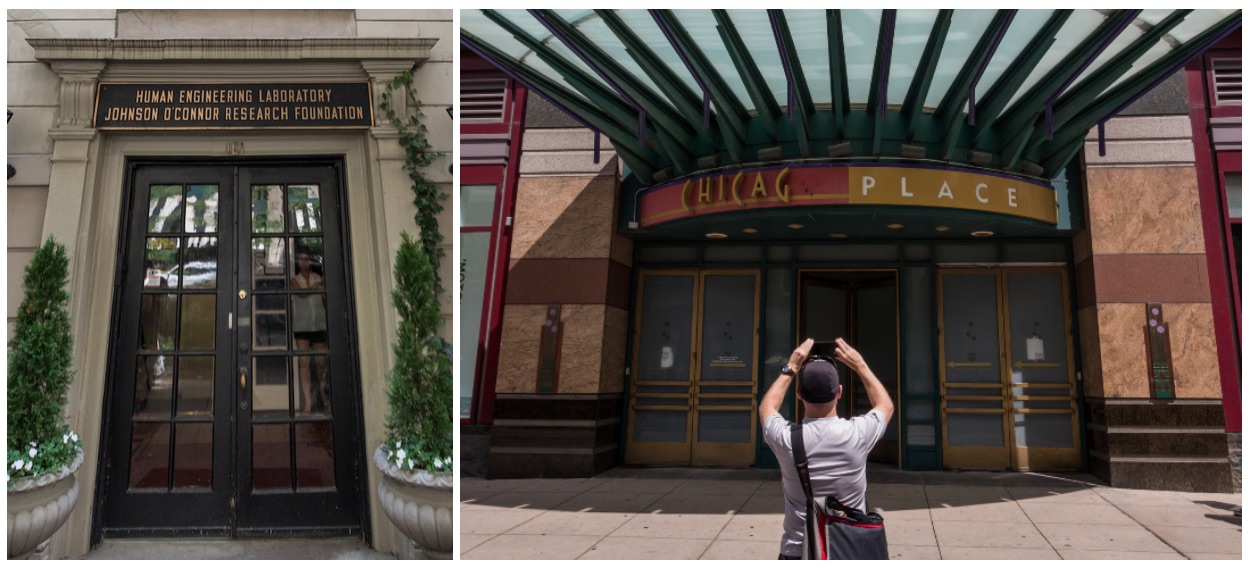
Matthew Kaplan
Befitting an urban setting whose fortunes have risen and fallen drastically since the first half of the nineteenth century, we also looked at the many other uses seen in and around this former Dock & Canal area such as advertising agencies, association headquarters, an extant former Cadillac dealership, and the curious “Human Engineering Laboratory” seen above left.
We also examined the area’s unusual number of failed retail centers including the former North Pier festival marketplace, and Chicag(o) Place Mall, an eight-story vertical mall nearly completely abandoned since early 2009 above right. Finally, we discussed the distinctive interior of Chicago Place, planned by the firm headed by Deborah Sussman (1931-2014), the design genius behind the visual identity of the 1984 Olympic Games in Los Angeles.
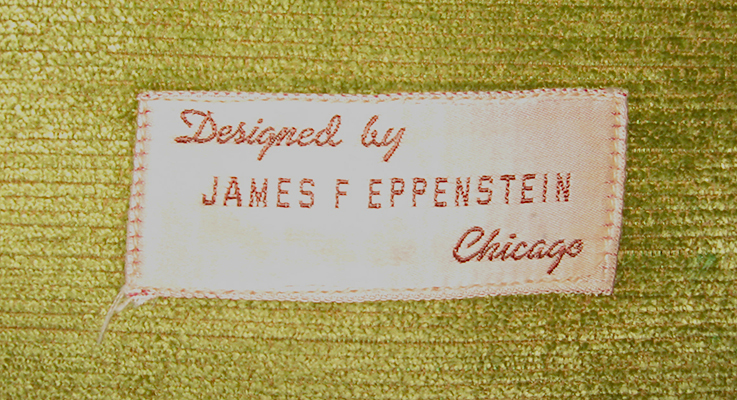
Courtesy of the Eppenstein family
On Sunday, June 12, 2016, a group of 35 guests enjoyed the first Forgotten Chicago presentation on the remarkable career of James Eppenstein, a nearly completely forgotten modernist architect and designer whose 20-year career of at least 75 buildings and interiors was rediscovered in recent years by Patrick Steffes of Forgotten Chicago. Eppenstein’s career was subject of three popular FC articles starting in 2013 as seen here, here, and here.
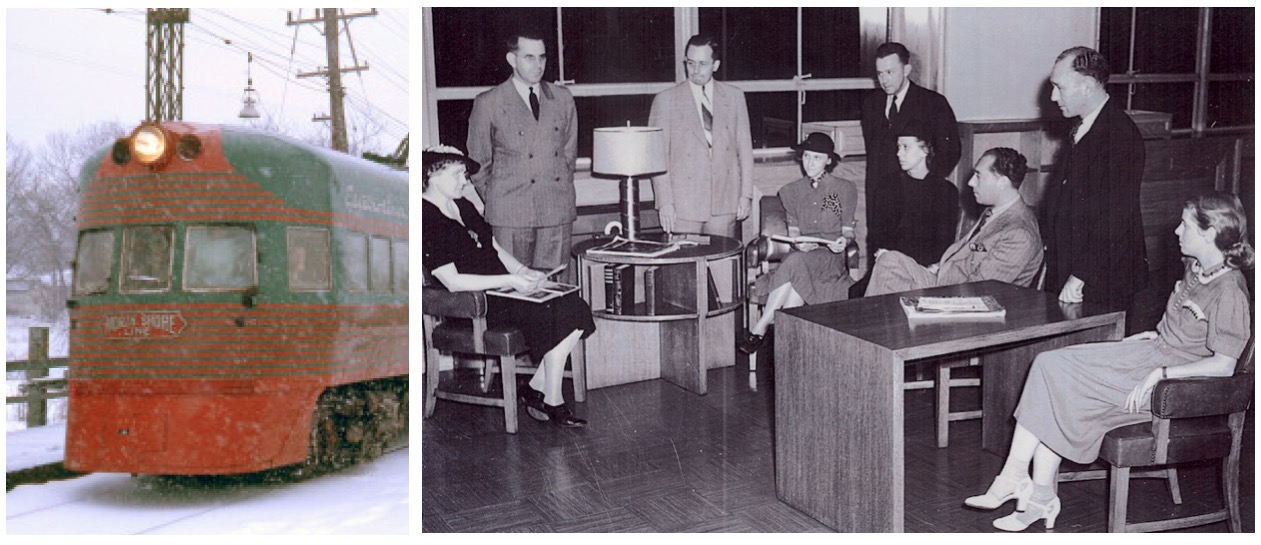

Top Left: Railroads, Chicago-Style Blog Top Right: Courtesy of Rich Renner Bottom: Forgotten Chicago
Born to a wealthy industrialist family in Elgin at the end of the nineteenth century, Eppenstein would design a nationally publicized series of residential and commercial buildings and interiors for an impressive array of clients. This all-new presentation was Forgotten Chicago’s first program in Elgin, a city rich in industrial heritage and history. Besides designing the exterior and interior of the fabled Electrolier train that ran from Chicago to Milwaukee from 1941 to 1963, Eppenstein also designed furniture for Elgin Township High School, in his distinctive style as seen at right.
Many thanks to those who joined us in Elgin for the first Forgotten Chicago event in Kane County!

Matthew Kaplan
A sold-out group joined Forgotten Chicago on Sunday, June 5, 2016 for what may have been the first-ever comprehensive tour of the enormous redevelopment site to the southwest of where the Chicago River and Lake Michigan meet, Illinois Center and the New Eastside. Easily one of the most high-profile urban redevelopment projects in North America, planning for this site began nearly 100 years ago, with parcels of empty land still remaining in 2016. The tour included a visit to all three levels of East Randolph Street, including its curious “Tennis Stadium” sign as seen above left, as well as decades-old remnants of the site’s former use as an enormous Illinois Central rail yard from before the Civil War until the 1990s, above right.
Besides the sites former industrial and transportation uses, we also discussed a partially intact 1880s building on busy North Michigan Avenue that was purportedly built as a luxury residence and ultimately converted to a showroom for Italian office machine company Olivetti in 1956.
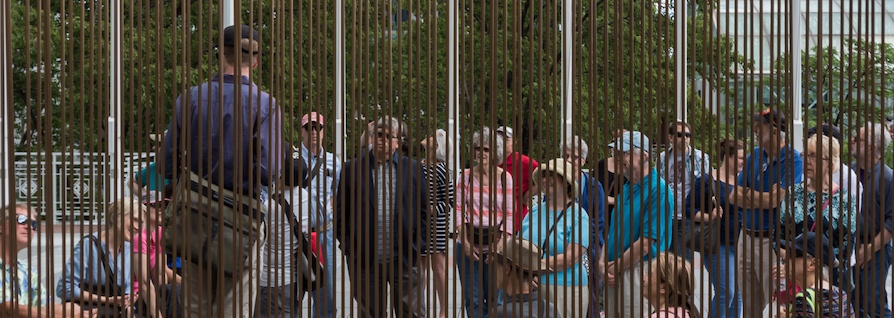

Matthew Kaplan
Visiting 25 sites, this tour also examined the site’s few public artworks. We discussed the unfortunate saga of artist Harry Bertroia’s iconic Sonambient sculptures above top that stood intact as the artist intended in front of what is now the Aon Building for just 20 years until being removed, placed into storage, and being partially broken up and sold at auction in 2013 for hundreds of thousands of dollars.
Finally, this tour included a visit to the Vista Tower Sales Gallery above bottom, a remarkable new development by Studio Gang that will transform Illinois Center and the New Eastside with its unique structure and stunning views, as simulated in spectacular fashion, as seen above.
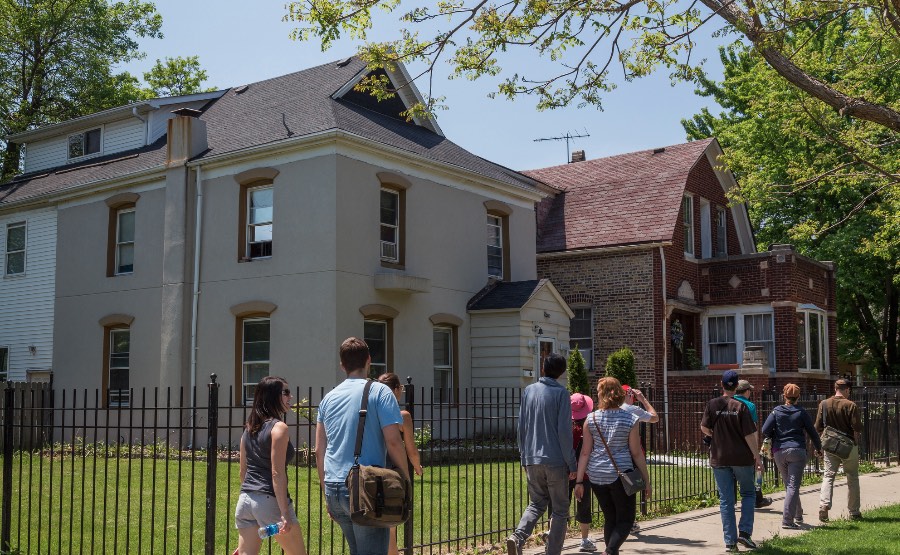
Matthew Kaplan
A sold-out group joined Forgotten Chicago’s on Sunday, May 22, 2016 as we offered our exclusive exploration of the utterly forgotten Pennock industrial village, a manufacturing corridor west of Logan Square, as well as the area around Kosciuszko Park. Offered for the first time since 2013, we closely examined the large number of industrial facilities located surprisingly close to residential areas, along with many other overlooked sites in this neighborhood. Pennock was a failed industrial suburb from the 1880s by the same colorful promoter that founded Homer, Alaska – Homer Pennock. The Pennock development still includes unique worker housing on double lots, as seen above center.
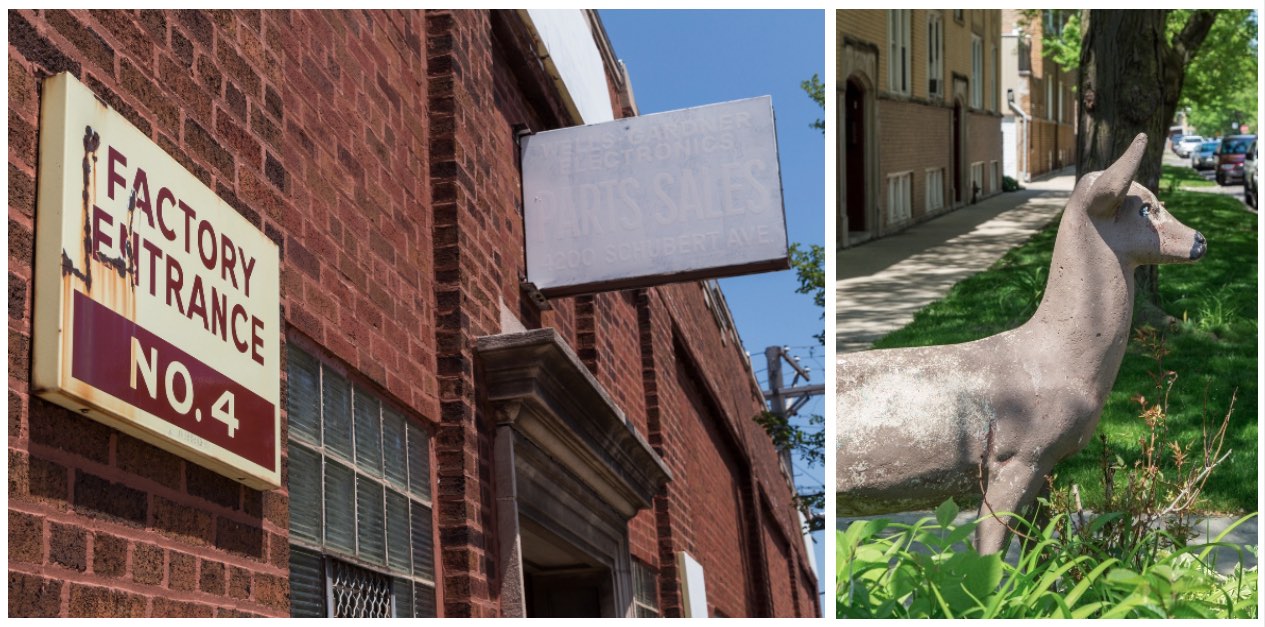
Matthew Kaplan
Pennock’s rich industrial history was also seen in the former Wells-Gardner factory above left; this once-substantial company made television sets and monitors and cabinets for Pac-Man video games; Wells-Gardner’s Parts & Sales sign can still be barely seen above center. Other relics abound in and around Pennock, and no visit would be complete without a visit to the site of the former Olson Rug Park and Waterfall, a Northwest Side landmark that opened in 1935 and closed in 1978.
This well-loved former park was examined in a 2009 Forgotten Chicago article, and this tour included what may be one of the few surviving remnants of the park, a concrete deer still serving as a silent sentinel across the street from the current industrial buildings of the long-vanished village of Pennock, Illinois.
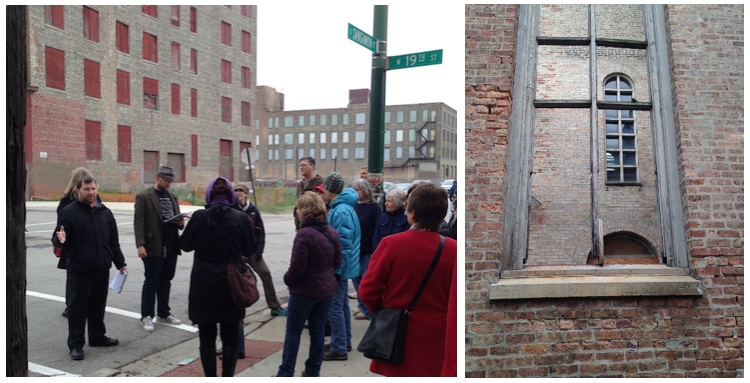
Patrick Steffes
Forgotten Chicago’s 2016 tour season kicked off with a sold-out walking tour of Pilsen, held on Sunday, May 1, 2016. Expanding upon a a VIP tour conducted for the inaugural Chicago Architectural Biennial in October 2015, this tour delved deeply into the overlooked built environment of Pilsen, one of Chicago’s most dynamic neighborhoods, a pre-zoning nineteenth century Chicago neighborhood that developed alongside industrial growth and expansion. Two of the thirty sites visited included a former industrial corridor along South Sangamon Street seen above left. slated to be part of the new El Paseo trail in the years ahead. We also visited the former Zion Evangelical Church above right, a curious ruin towering over the eastern end of Pilsen in its burned-out state since 1979.
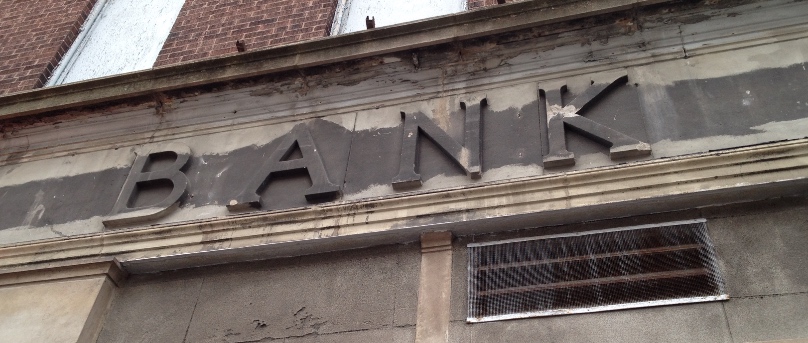
Patrick Steffes
Pilsen has been subject to enormous development pressure in recent years, and this in-depth tour was a unique opportunity to see this dynamic neighborhood Forgotten Chicago-style, before more of its rich built environment and history is swept away. Pilsen’s strong link to transit is leading to increasing demolition and remodeling, including the former Ashland State Bank relief, hidden for decades at the corner of Ashland & 18th before being suddenly revealed in February 2016, as seen above. On this tour, we also examined historic links between home, work and pleasure in this community with a rich ethnic history, including Czechs, Germans, and Latinos. This tour also visited a little-known and extant 1911 factory by Adler & Sullivan, an organized labor landmark, former Eastern European athletic and social clubs, and much more.

Left: Patrick Steffes Center: Jerzy “George” Skwarek Right: Google Maps
On Sunday, April 10, 2016, a standing room only group of over 60 guests enjoyed Forgotten Chicago’s popular (and free!) presentation on the history of Chicago’s dynamic and ever-changing Avondale neighborhood at Brew Brew Coffee Lounge, 3832 West Diversey Avenue. This presentation was be given by Jacob Kaplan and Dan Pogorzelski, two of the authors of the book Images of America: Avondale and Chicago’s Polish Village, published in July 2014, and included rare Avondale images not seen in the book.
Delving deeply in the past and present of this fascinating and often-overlooked community, this presentation examined Avondale’s ethnic communities (including the large and influential Polish population, once commemorated in long-vanished street signs above center), industry past and present, political powerbrokers, and the nearly forgotten nightclubs and music venues once filled with “holidaymakers” who would work in Avondale for a short time and then return to the Eastern Europe. Also examined was the demolition and disruption the Northwest (now Kennedy) Expressway caused in Avondale, including to its namesake park, seen above right.
Many thanks to the large crowd that joined us in Avondale!
Following a very busy last few years, Forgotten Chicago concluded our 2015 season exploring the little-studied neighborhoods, history, culture, and the built environment of the Chicago area in a series of exclusive programs and events, with many Forgotten Chicago events never offered before by any organization.
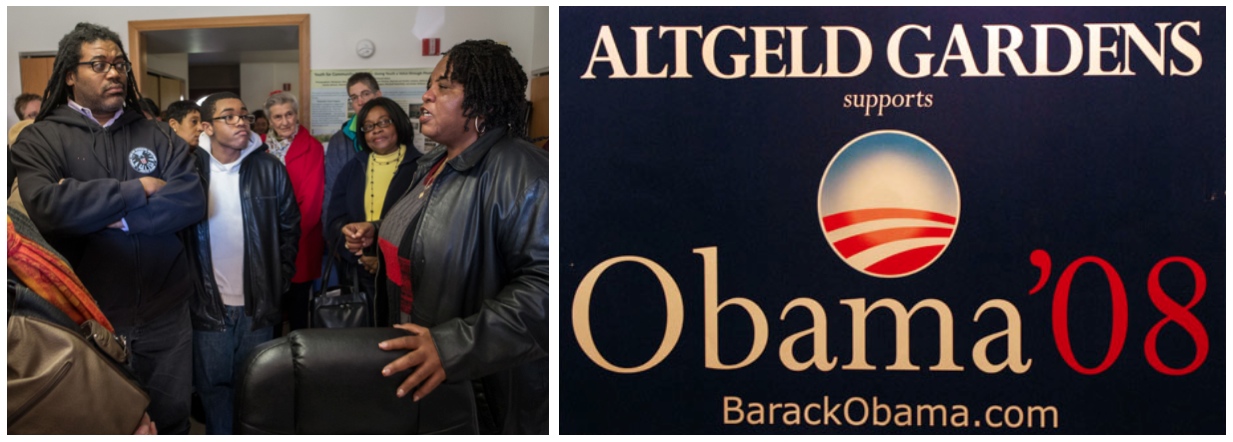
Left: Matthew Kaplan Right: Medill Reports, Northwestern University
On Sunday, November 8, 2015, one year to the day before the 2016 election that will mark the final chapter of President Barack Obama’s unprecedented political career, Forgotten Chicago and Pullman-area native Tom Shepherd presented an exclusive and quickly sold-out tour of sites crucial to the rise of Barack Obama in Chicago in the 13 years from his arrival in Chicago to his first election to the White House.
Our first stop was Altgeld Gardens, a Chicago Housing Authority community near the Calumet River. Cheryl Johnson, Director of People for Community Recovery above center recalled the many times Obama spent at the Johnson home with Cheryl’s mother, the late Hazel Johnson, to discuss environmental issues, jobs, poverty, housing, and other issues in Altgeld Gardens.
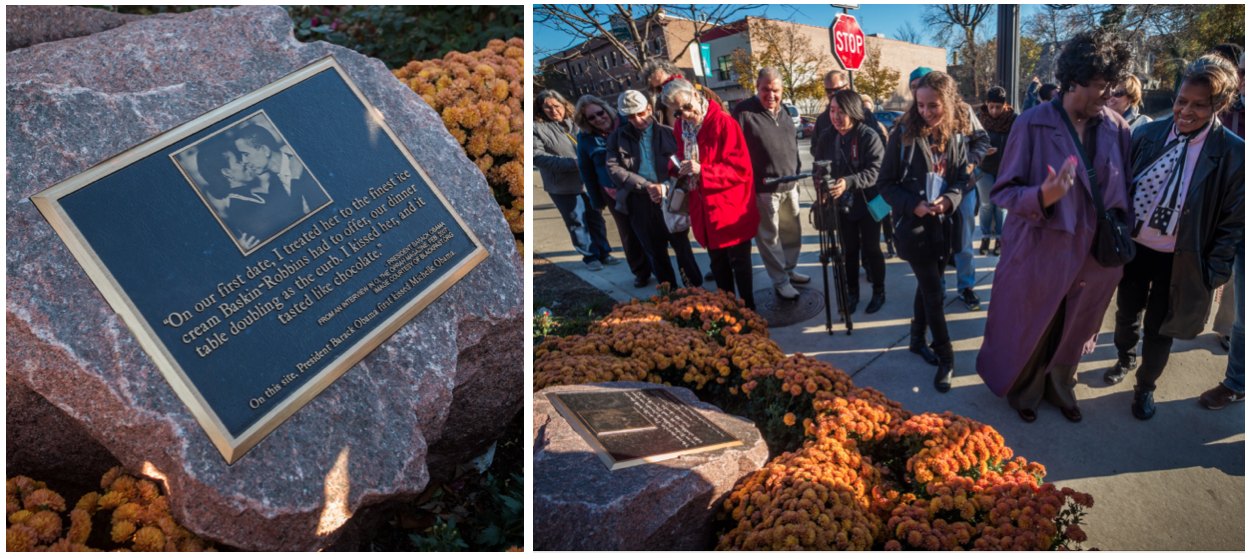
Matthew Kaplan
No tour of Barack Obama’s Chicago would be complete without a visit to Hyde Park, where Obama taught at the University of Chicago from 1992 to 2004 and where he won his first election to public office in 1996. Utilizing a 55-passenger motor coach, this tour also visited sites related to First Lady Michelle Obama’s remarkable life and career in her hometown before moving to Washington. Our tour included a cafeteria lunch at Valois, one of the President’s favorite restaurants, a visit inside his long-time barbershop, and the site of the first kiss between the future president and first lady.
Many thanks to all those who joined us in this rare and exclusive opportunity to visit the many Chicago sites crucial to the rise of Barack and Michelle Obama in the years before they became president and first lady!
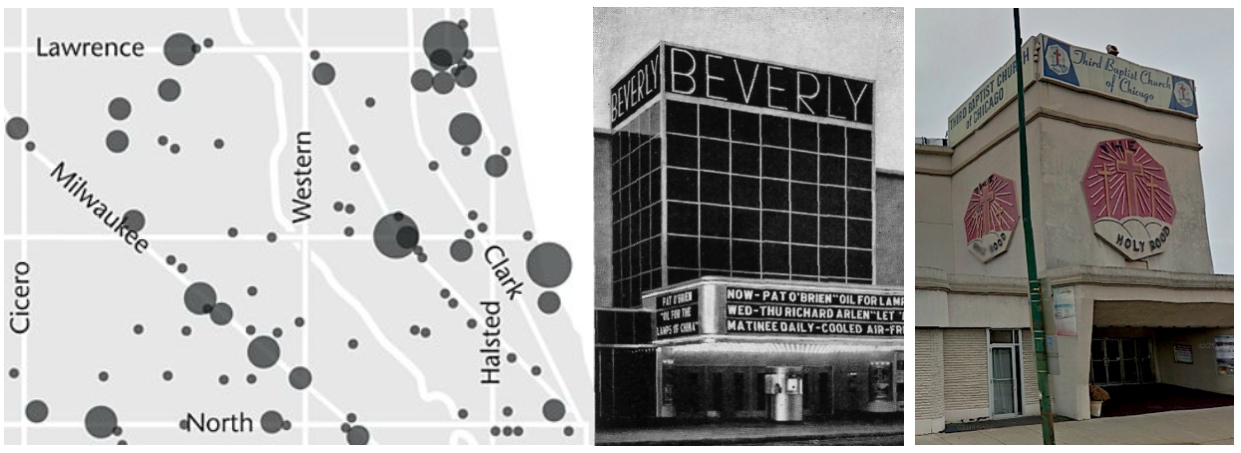
Left: Encyclopedia of Chicago Center: Architectural Forum Left: Google Street View
Forgotten Chicago presented to an enthusiastic crowd at Mather’s – More Than a Cafe on Friday, October 23, 2015 on the integral part Chicago has played in motion picture history. This exclusive event explained how Chicago has been at the forefront of motion picture innovation for more than 120 years, including the first demonstration of pictures that gave the illusion of movement, the world’s first movie palace, and the Chicago beginnings of the world’s first integrated movie studio, Universal Studios, in a modest building demolished with little notice in 2015.
Also discussed were the countless former movie theaters seen above left on the North Side in 1926. Nearly all since repurposed and many are still standing; Forgotten Chicago will often point out these former theaters buildings during tours. A good example is seen above center and right, the 1935 Beverly Theater by R.F. Perry, long since converted to a church but retaining its distinctive appearance.
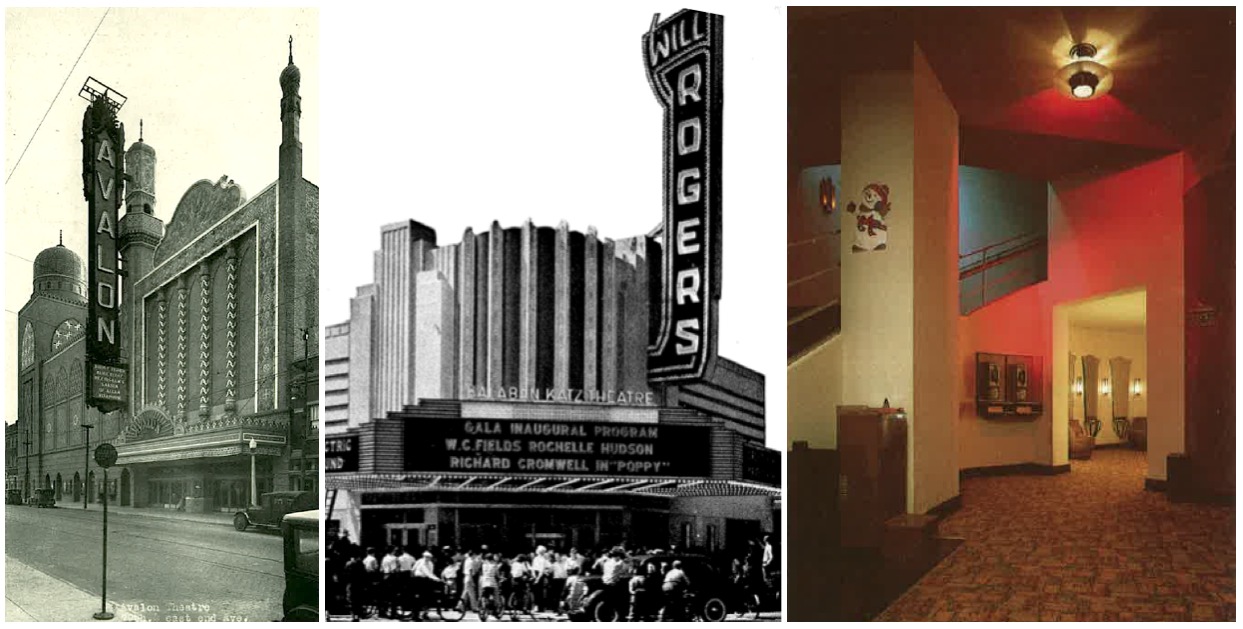
Left: Western Architect Center: Architectural Forum Right: Don DuBroff, Chicago History Museum
Utilizing Forgotten Chicago’s enormous database of articles and images, most not seen in decades, we also shared photos and histories of many once-prominent theaters. Above left is the spectacular 1927 Avalon Theater by John Eberson; this local landmark would be renamed the New Regal, with this venue not hosting performances in years. We also discussed a theater remembered by many in the audience, the Will Rogers near Belmont & Central by Rapp & Rapp, shown above center and right and opened in 1936; an interior view prior to its demolition is also seen above.
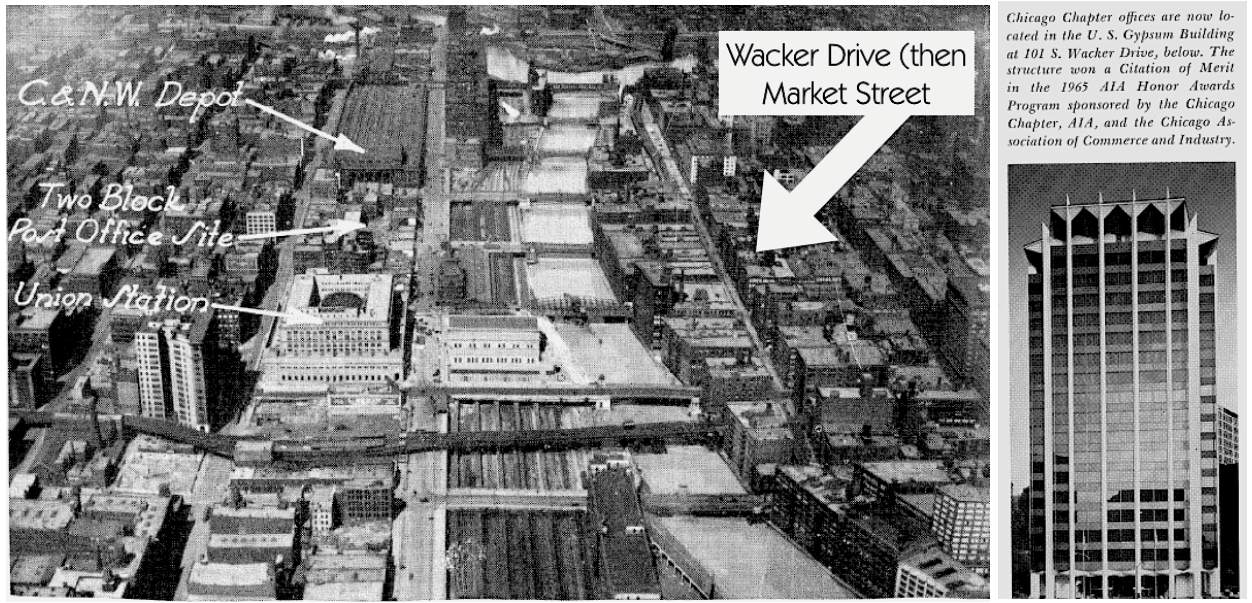
Left: Western Architect, 1926 Right: Inland Architect, 1965
Forgotten Chicago offered our first public tour on the development and history of North and South Wacker Drive on Sunday October 18, 2015, in an encore of a tour given on behalf of The Society of Architectural Historians Annual Conference in April 2015. One of the most important commercial streets in the U.S., Wacker Drive’s history is nearly completely overlooked, especially compared to Chicago’s Michigan Avenue and State Street.
We looked closely at this street’s drastic transformation since the early 1950s, unrecognizable from the 1926 aerial photo seen above left. More than half of Wacker Drive’s major commercial buildings completed in the 1950s and 1960s have vanished, including what may be the shortest-lived major building since the Great Fire, the headquarters of U.S. Gypsum, above right. Completed in 1963, this distinctive building by Perkins & Will would be abandoned and demolished less than 30 years later.
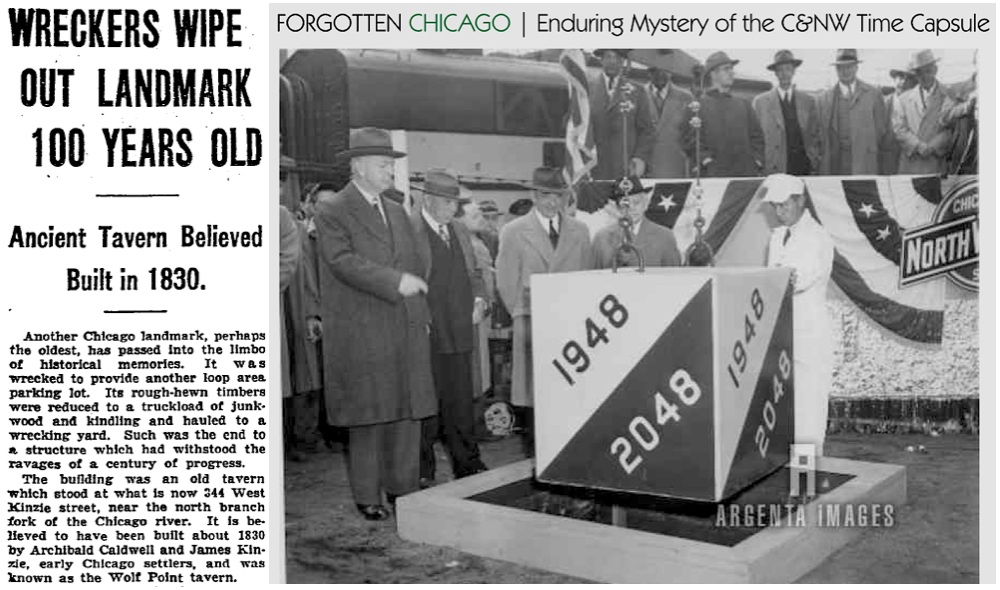
Left: Chicago Tribune, 1933 Right: Forgotten Chicago Forum & Argenta Images
In addition to Wacker Drive, this tour visited both Union and Northwestern train stations and examined the area around West Kinzie Street, north and west of the Merchandise Mart. We took a look at the forgotten story of the former site of the very historic Wolf Point Tavern at Kinzie and Orleans Streets, which was inexplicably torn down in 1933 for a parking lot, seen above left.
Traveling to the corner of Kinzie and Canal, we saw what may be the site of the 1948 time capsule buried for the centennial of the Chicago & Northwestern Railroad, above right. The photo above right was posted to the Forgotten Chicago Forum in 2013 by user “barbchri”; the exact whereabouts of this piece of Chicago history remains undetermined today. Many thanks to those that joined us on this tour!
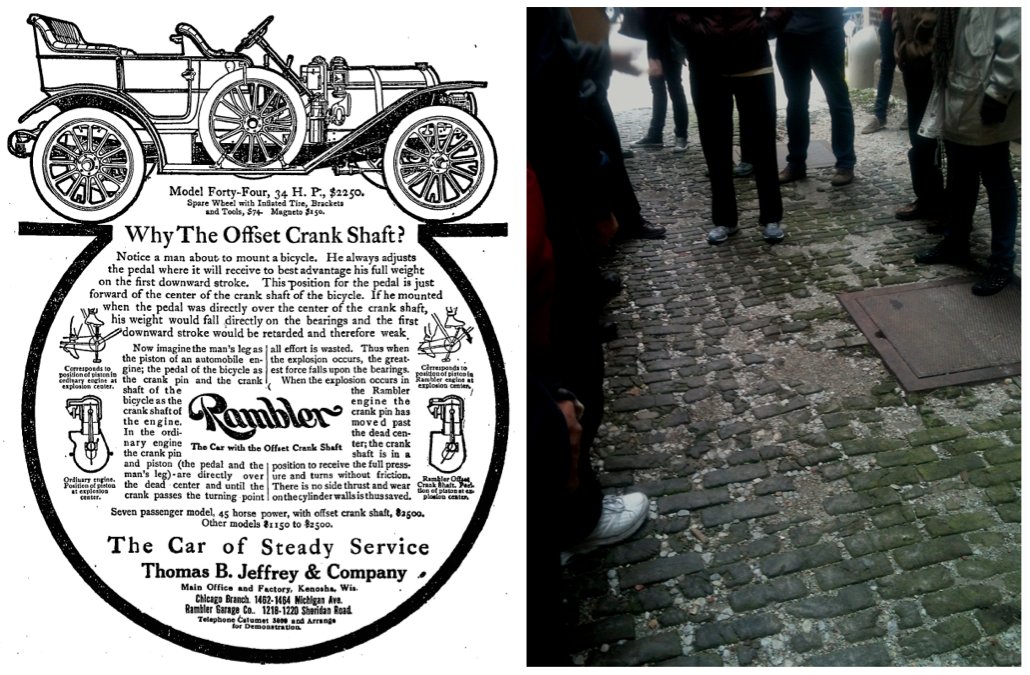
Left: Chicago Tribune Right: Patrick Steffes
Forgotten Chicago conducted its first-ever visit to Lake View on Sunday October 4, 2015, in a sold-out tour exploring 40 mostly forgotten and largely overlooked sites from the Lake Shore Drive and West Oakdale Street to the Sheridan Red Line Station. We visited the former Rambler Garage, a building that may be Chicago’s most forgotten landmark, above left, a structure that turned 110 years old in 2015 and was built by the founder of the company that would ultimately become American Motors Corportation. Besides being the first multi-level parking garage built in Chicago, this building is one of the oldest extant former parking structures in the world. Additionally, we took a look at a rare nineteenth century wood block alley, above right, just steps from busy Lake Shore Drive.
This tour took a look at the enormous variety of housing types in Lake View, from former churches converted to condominiums, single family homes on busy arterial streets, elaborate 1920s high rises, 1940s townhomes and the only partially completed 1987 New York condominium on Lake Shore Drive. Former and current religious buildings were also examined, including an enormous former tabernacle church now housing a Walgreens and Petco. Additionally, we visited a long-closed hospital, on whose site may have been the birthplace of one of the most influential American woman of the twentieth century.

Left: Western Architect, 1917 Right: Chicago Tribune, 1955
Perhaps the most curious Lake View landmark is an extant building once a part of the vast Bismarck beer garden property built in the 1910s, designed by architects Huehl & Schmid, above left. Developed by the Eitel Inc., a leading hospitality company in Chicago for generations, this complex would change its name to Marigold Gardens due to widespread anti-German sentiment in World War I, and would go through a wide variety of uses though the years, including a dance hall and arena, above right. Modified and converted to a church in 1964, the building remains standing as a reminder of the enormous changes that have occurred in Lake View over the years.
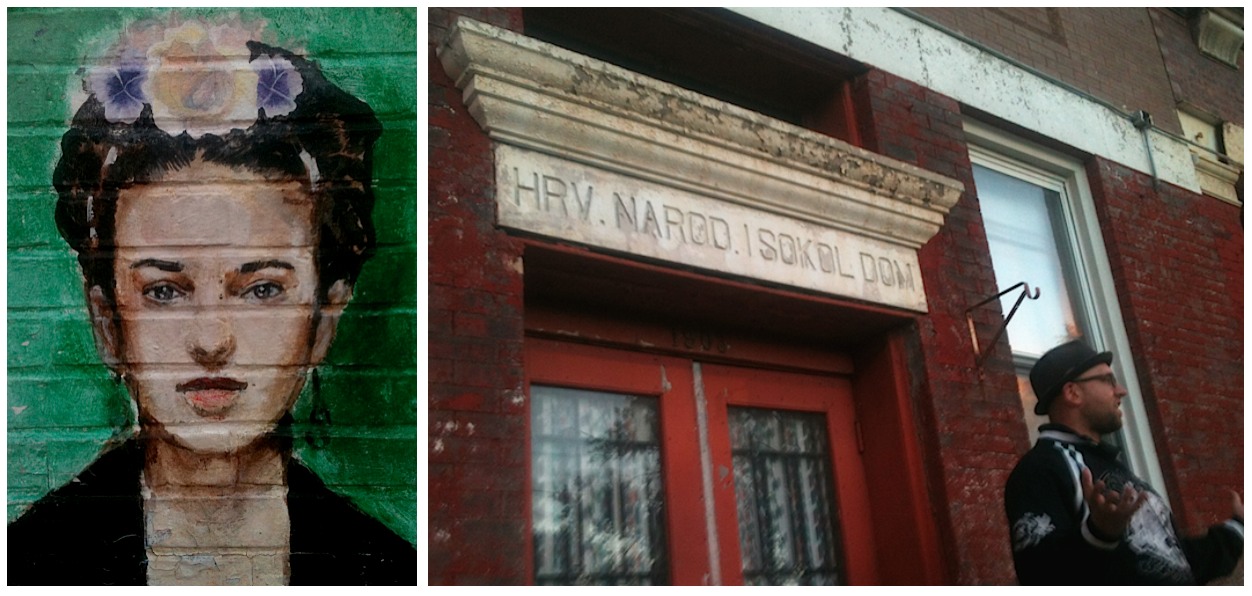
Patrick Steffes
On Thursday October 1, 2015, Forgotten Chicago was pleased to present a VIP tour on behalf of the first Chicago Architecture Biennial, in the Pilsen community, on and around West 18th Street, Blue Island Avenue and South Halsted Streets. In true Forgotten Chicago fashion, we examined the many layers of ethnic history in Pilsen, including Czechs, Slovaks, Slovenes, Croatians, Lithuanians, and Mexicans. Above right is a long-closed former Croatian Sokol, or social and athletic club with its former use clearly visible. We examined a former post office, former factories, churches converted to other uses, and a major landmark in U.S. labor history. Finally, the group enjoyed a guided tour of Thalia Hall, a recently reopened entertainment, dining, and shopping landmark in Pilsen.
Forgotten Chicago’s Near South Side Bike Tour was held on a cool Sunday, September 27, 2015. Starting in Chinatown, this tour examined industrial and political landmarks, architectural curiosities, and the continuing evolution of the Near South Side. Including the dynamic neighborhoods of Bridgeport, McKinley Park, and others, this bike tour explored overlooked architecture and landmarks in these fascinating communities, including the massive Central Manufacturing District, the first of its kind in the nation, and full of many intact details.
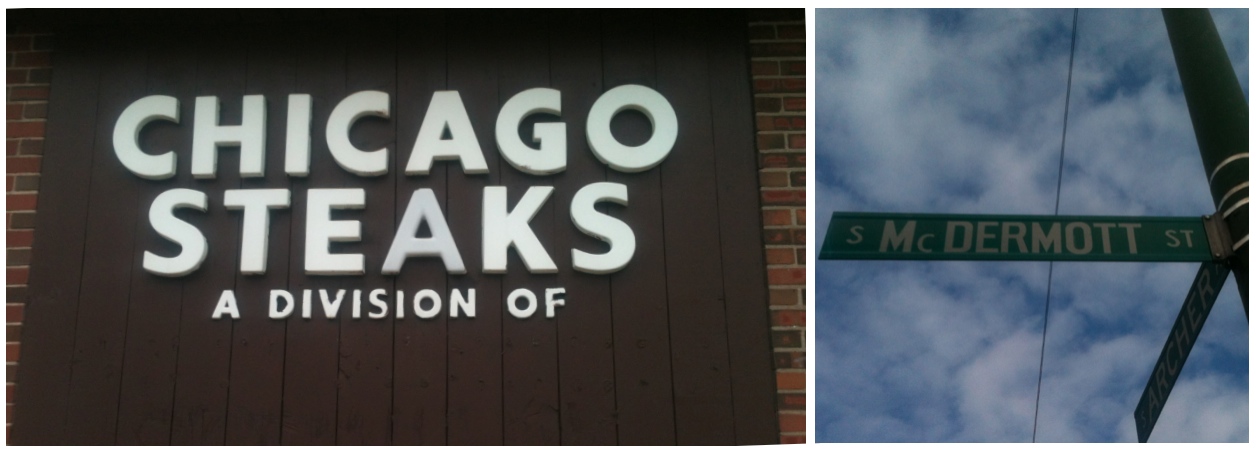
Patrick Steffes
The Stockyards and Canaryville community were also visited and discussed, along with the former Stockyards, containing a surprising number of intact remnants and structures more than 40 years after it closed. Not everything covered on the tour was “historic” however, as we explored the dynamic ways in which these neighborhoods are changing, and new businesses and landmarks, such as the recently opened Chinatown branch of the Chicago Public Library. We ended the tour on South McDermott Street, identified in a popular 2008 Forgotten Chicago article as Chicago’s shortest street.
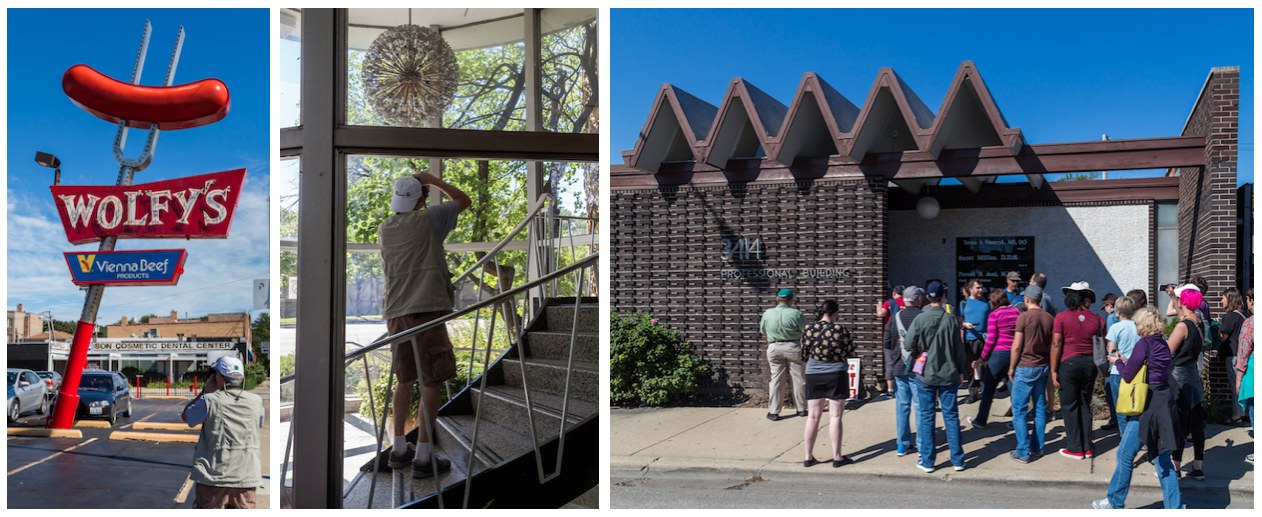
Matthew Kaplan
An enthusiastic crowd joined Forgotten Chicago on a gorgeous Sunday afternoon on September 20, 2015 for an all-new Modernist Peterson Avenue walking tour. Home to what may be the most concentrated and intact collection of Mid-Century Modern commercial structures in the Midwest, Peterson Avenue and nearby Ridge Avenue is nearly completely forgotten in published work on Chicago architecture and design.
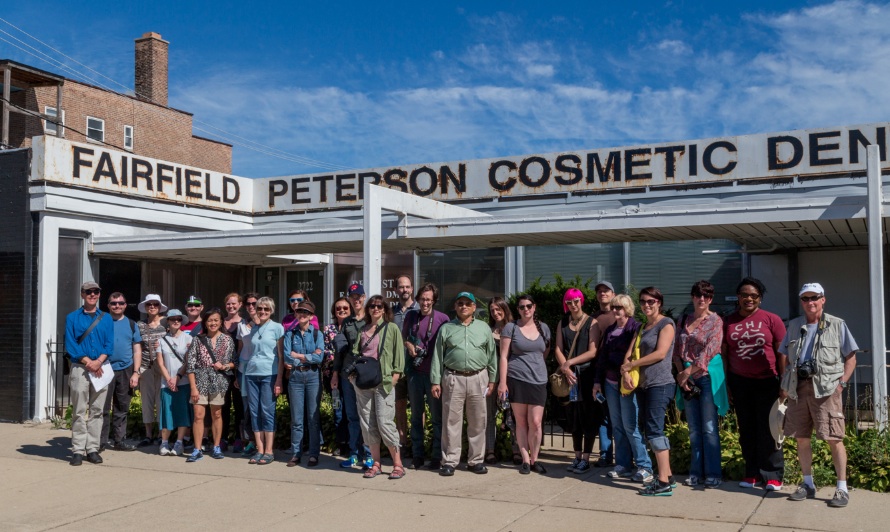
Matthew Kaplan
The often-flashy buildings of Peterson Avenue were meant to be noticed from speeding car; this tour explored more than 35 sites up close and on foot, to see these building’s enormous attention to detail in entrances, lobbies, and building materials. As with all Forgotten Chicago tours, a wide variety of other sites were included as well, including the only indoor Chicago public park, remnants of the 1920s housing bubble, a nearly intact 1959 motel, a swank 1920s former Chrysler showroom, an enormous convent, and much more.
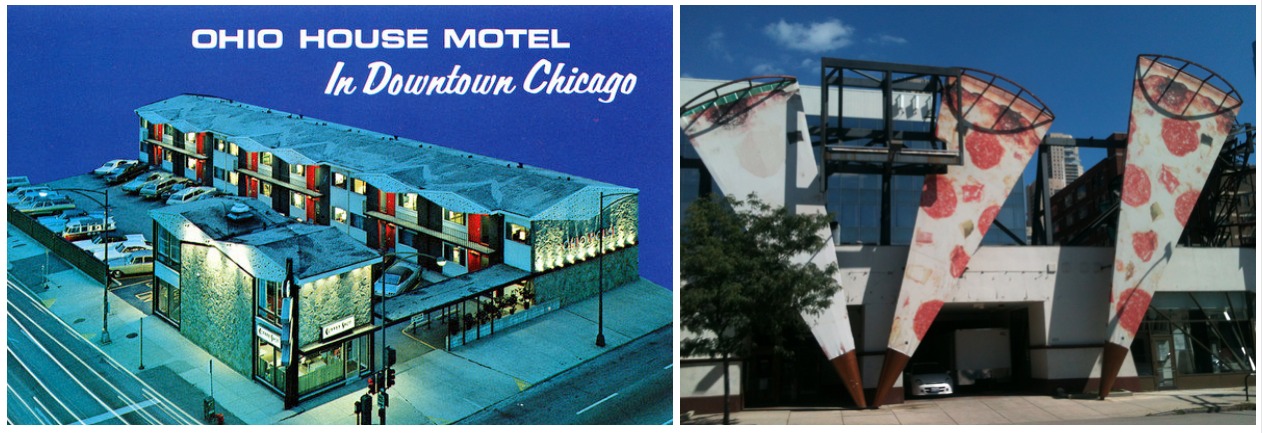
Left: Edge & Corner Wear Right: Patrick Steffes
A sold-out group joined Forgotten Chicago on Sunday August 30, 2015 for our exclusive LaSalle Street Walking Tour. Urban neighborhoods and environments are constantly in flux, none more so than River North and Old Town. On this tour, offered for the first time in more than four years, we examined wildly varying architectural styles from numerous eras of construction on and around LaSalle Street north of the Chicago River. We paid special attention to auto-oriented development near the Ohio Street Feeder to the Kennedy Expressway. Seen above, the Ohio House Motel is going strong, but the abandoned former Planet Hollywood / Gino’s East (complete with giant images of pizza slices covering former “searchlights”) is doomed, with a demolition permit issued in July 2015, and now nothing but a tourist-friendly memory.

Patrick Steffes
Roughly following North LaSalle Street from the Chicago River to North Avenue, we saw evidence of the widening in 1928 that turned LaSalle from once-sleepy and mostly residential street to the busy auto-centric thoroughfare it is today. More than 30 different sites were visited, including an 1880s cable car powerhouse, former (and then-open) gay pornographic movie theaters, the first home of what was to become Essanay Studios, a gentrification project dating back nearly 90 years, and much more. As in many neighborhoods in central Chicago, the area on and around North LaSalle street is undergoing great change and demolition, with several longtime landmarks disappearing since our last tour, and more undoubtedly vanishing in the years ahead.

Left: Dan Pogorzelski Center and Right: Patrick Steffes
A sold-out group joined Forgotten Chicago on Sunday August 9, 2015 as we toured the Northwest Side neighborhoods of Irving Park, Independence Park, and the Villa District. This walking tour followed the ethnic and development patterns of the city as it grew towards the northwest, with early farmhouses, commercial districts and much more examined along the way. Some of the many sites visited included a circa-1856 farmhouse seen above center and a circa-2005 “castle” located along the Kennedy Expressway and seen above right that was mired in foreclosure and abandoned since 2010 until construction recently resumed on this startling home.
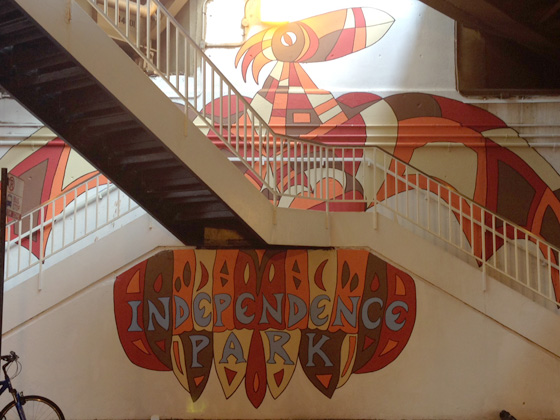
Derek Harmening
The unique and mostly intact architecture of the Villa District was covered in depth, and this tour featured an interior tour of a beautiful residence built for a Polish coal magnate in the heart of the District. We also visited the remarkable Art Deco Saint Wenceslaus Church, site of the wedding of famed photographer Richard Nickel, as well as the Kennedy Expressway and its profound effect on these communities. From overlooked funeral home architecture to little-known ethnic landmarks and some of the best murals in Chicago, this tour explored the many overlooked nooks and crannies of this fascinating area of the city.
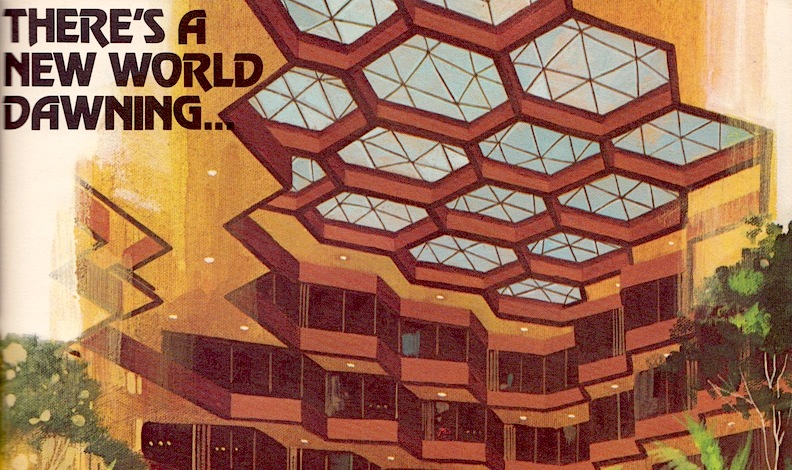
Chicago Faces and Places
For our first presentation in DuPage County, more than 40 guests joined Forgotten Chicago at the Elmhurst Public Library on Wednesday July 29, 2015 for an all-new presentation on the modern architecture of Carson Pirie Scott from the 1930s to the 1980s. One of the most overlooked chapters in the Chicago area’s history, Carson’s enthusiastically embraced top modern architects for their vast collection of department stores, restaurants and resort hotels. Nearly completely forgotten today, Carson’s would hire national firms such as Skidmore, Owings & Merrill and Welton Beckett & Associates to design a wide variety of branch department stores in the Chicagoland area. In the 1970s, overlooked modernist Don Erickson would design a stunning resort hotel with a dramatic atrium for Carson’s hospitality division in the western suburbs that is remarkably intact today, as seen above.
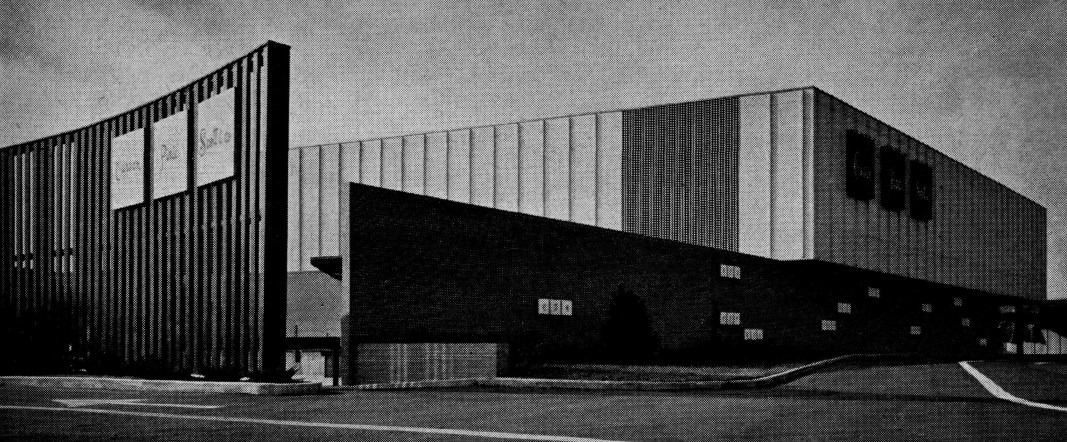

Top and Bottom Left: Architectural Record Bottom Right: Architectural Forum
Arguably, no other post-World War II retailer in the U.S. embraced modernist architecture and employed more high-profile architects than Carson Pirie Scott. Starting in 1952 with their first full-line branch by Holabird & Root and Howard T. Fisher & Associates and continuing into the 1980s, nearly all of these buildings survive today and continue to operate as Carson’s stores, including Victor Gruen’s Woodmar branch in Hammond, Indiana as nationally published above more than sixty years ago. In addition to Carson’s forward-thinking store design, this retail chain would also sponsor a high-profile contest in 1954 designed to demolish much of the Loop and convert the Lake Street ‘L’ in to an “Express Road” as seen above. Many thanks to joined us for this free, all-new presentation, featuring dozens of historic images, most not seen in decades.

Left: Northeastern Illinois University collection, 1872 Right: Matthew Kaplan
On Sunday July 26, 2015, Forgotten Chicago conducted a sold-out and all-new tour of the University of Illinois at Chicago and environs, one of Chicago’s most historic and fascinating neighborhoods, and one that is often ignored by residents and tourists alike outside of a short stretch of West Taylor Street. Appropriately, this tour spent a good deal of time in the heart of the UIC campus at the site of the former UIC Forum, a series of outdoor amphitheaters that was demolished starting in 1993. Until the early 1960s this area was the heart of a thriving, multi-ethnic and and densely populated community; the location of the Forum is show above left. overlaid on an 1872 map; this site 2015 is seen above right.
UIC celebrated its 50th anniversary in February 2015, and Forgotten Chicago used this anniversary year to explore the campus and surrounding area in depth. This tour explored the site nearby of the origin of the 1871 Great Chicago Fire, the destruction of the original Maxwell Street Market by UIC, the few remnants of the area’s once dynamic Jewish population, and what remains of lead architect Walter Netsch’s signature UIC campus skywalk system.
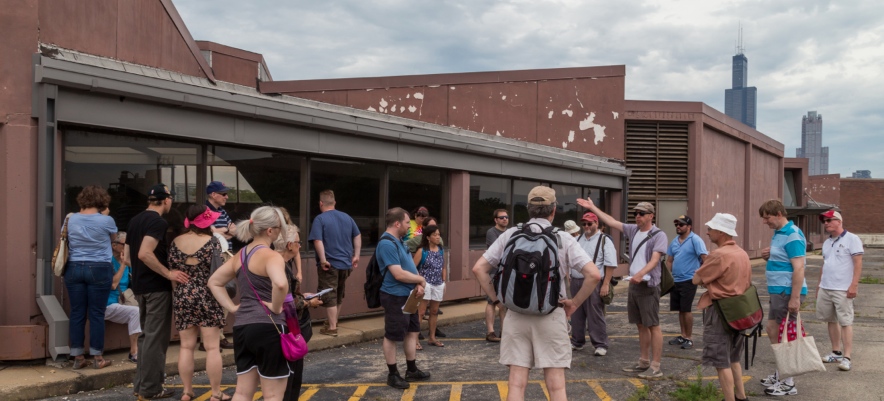
Matthew Kaplan
In true Forgotten Chicago fashion, we also visited Chicago’s oldest standing firehouse on Roosevelt Road, in continuous use from 1873 to 2008, Stanley Tigerman’s once-colorful former Illinois Regional Library for the Blind, and the fascinating architectural graveyard of Saint Ignatius High School, subject of a 2009 Forgotten Chicago article. We ended the tour with a stop to the abandoned rooftop parking lot of the former Circle Court shopping center seen above, a miniature West Side version of Woodfield Mall in Schaumburg that was an enormous failure for years until finally being purchased by UIC in the early 1990s.

Patrick Steffes
A sold-out group joined Forgotten Chicago on Sunday June 14, 2015 for an encore of our Six Corners tour, offered for the first time since 2012. One of the largest outlying shopping districts in Chicago, Six Corners (at the intersection of Cicero, Milwaukee and Irving Park) has been a major commercial destination since before World War I. Curiosities abound, from two mostly intact Great Depression-era storefronts facing the neighborhood’s iconic Portage Theater above left (where we also conducted an extensive interior tour) as well as an earlier movie theater, the former Grayland nickelodeon on busy Cicero Avenue, whose intact facade was revealed in recent years, above right.
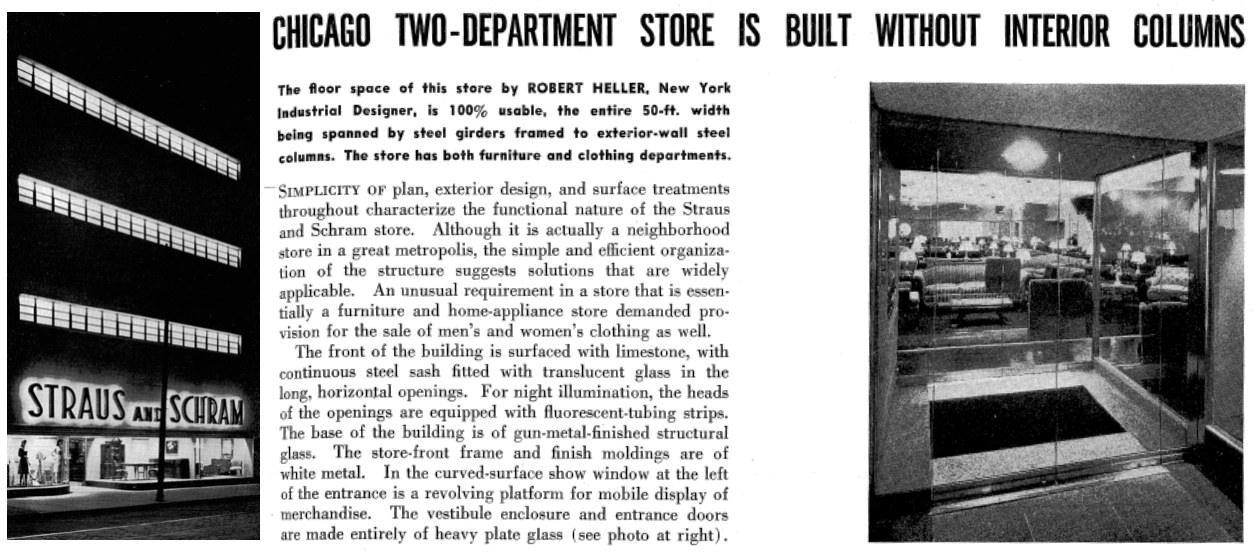
Architectural Record
This tour examined the area’s early history as a crossroads, as well as the beginnings of the streetcar era. The tour also looked at evidence of the district’s rapid growth and evolution, including a visit inside Robert Heller’s and A. Epstein’s nearly intact 1940 former Straus & Schram store shown above, as well as other storefront modernizations. Finally, we will discuss how the switch from the streetcar to the automobile caused Six Corners to transform and adapt to changing trends.
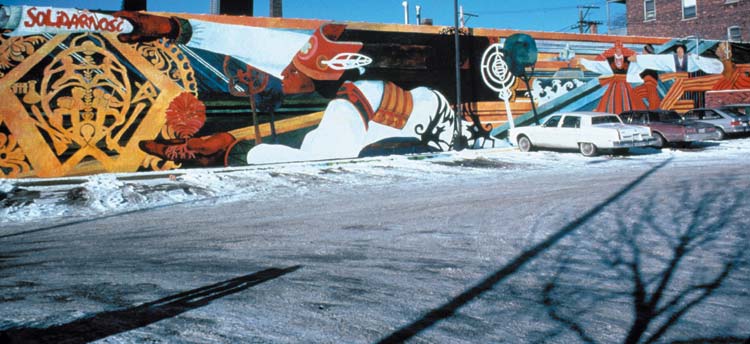
Chicago Public Arts Group
On Wednesday June 10, 2015, Forgotten Chicago gave a free lecture at the Niles Public Library on the history of the overlooked Northwest Side neighborhood of Avondale. Home to Chicago’s Polish Village, majestic church architecture, overlooked ethnic murals (above) and the spectacular former Olson Waterfall, this presentation shed light on some of the little known history of the area — including its fascinating industrial history.
This presentation on Avondale was given by Jacob Kaplan and Dan Pogorzelski of Forgotten Chicago, two of the co-authors of the recently released book Images of America: Avondale and Chicago’s Polish Village. Many thanks to those who joined us in Niles!
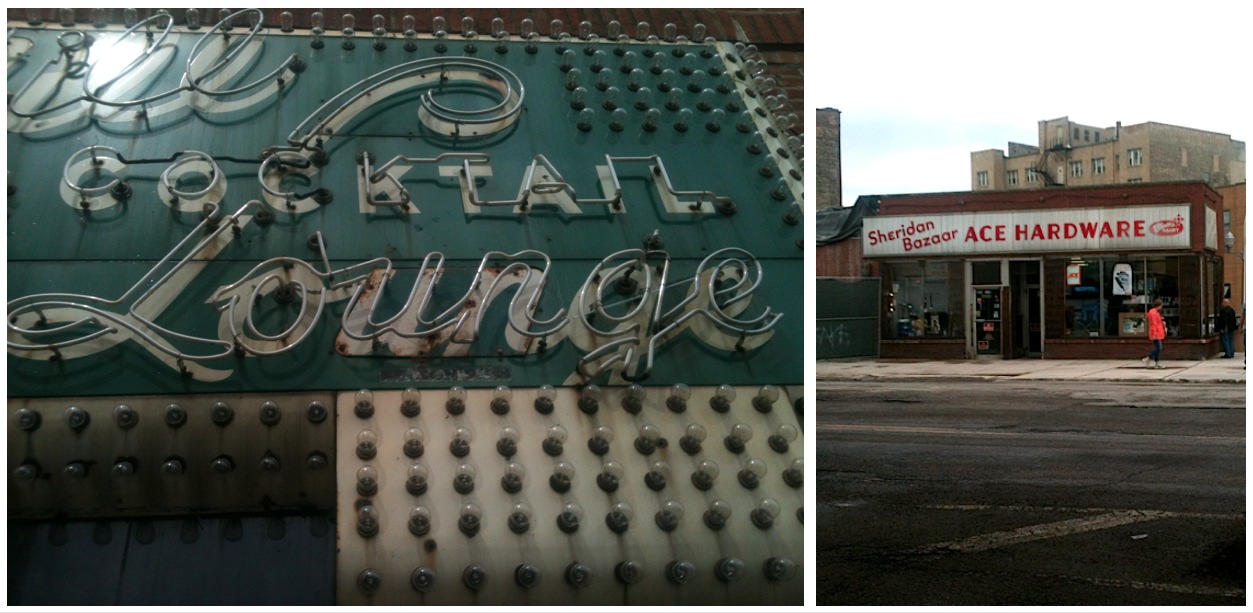
Patrick Steffes
Forgotten Chicago was proud to present the final program for the Vernacular Architectural Forum, an annual conference attracting 350 attendees from around the world from in early June, with FC conducting a tour highlighting the overlooked built environment and history of the Uptown community on Sunday June 7, 2015. The enthusiastic crowd of VAF attendees enjoyed an in-depth tour of Uptown, including the boom years of the 1920s that saw massive building of hotels, office buildings, parking garages and entertainment venues such as the iconic Green Mill, above right. We also showed recent changes to the community, including the demolition in the months before the tour of the massive concrete viaduct crossing North Broadway, newly revealing businesses such as the Sheridan Bazaar Ace Hardware, shown above right. Many thanks to VAF attendees who joined us for this lively tour!

Forgotten Chicago Archives
On Monday June 8, 2015, Forgotten Chicago was pleased to present another exclusive presentation to Mather’s More Than a Café location in Portage Park on the little-known history of presidential and first ladies sites in the Chicago area. Some of the many non-landmarked political sites in the Chicago area is the still-standing Shoreline Motel with an outsized place in Chicago history, shown above. This 1958 motel by Frank LaPasso in Hyde Park was a regular haunt of Mayor Harold Washington, the site of his final meal in 1987, and the location of President Obama’s first announcement for public office in September 1995.
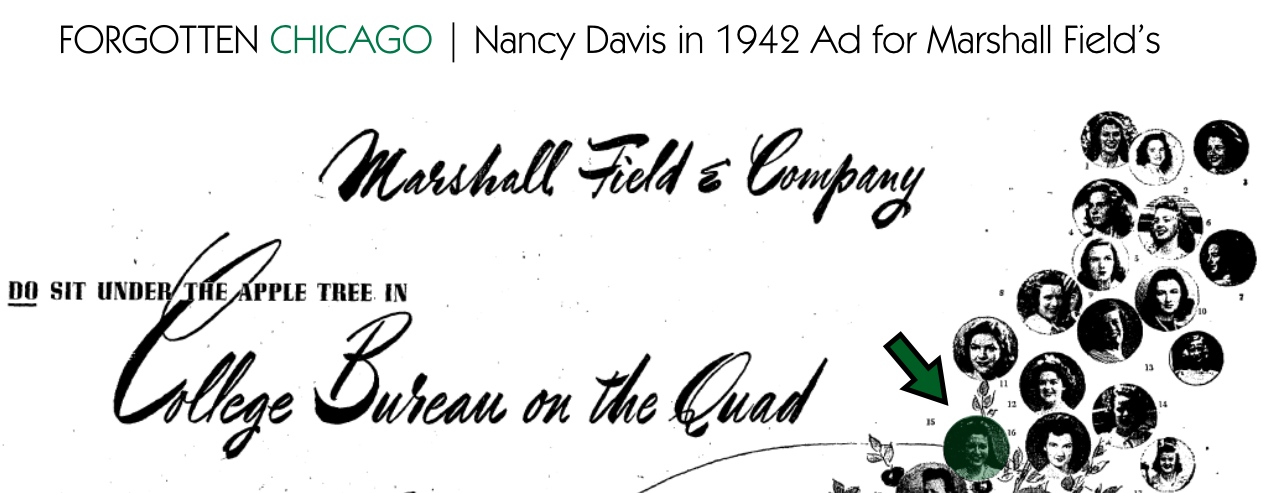
Chicago Tribune
Chicago has also had an enormous influence in recent first ladies, with every other one claiming ties to Chicago since 1974. Former First Lady Nancy Reagan was a flower girl in her mother’s second marriage at Fourth Presbyterian Church in 1929, and would live in a series of swank Gold Coast apartments until leaving for college in Massachusetts in 1939. The utter public relations genius of Nancy’s mother Edith Luckett Davis would see young Nancy Davis featured in the Chicago Tribune no fewer than 41 times before her 21st birthday, including a 1942 wartime ad for Marshall Field’s, above. This presentation also talked about Chicago hosting 25 national political conventions between 1860 and 1996, far more than any other city, and why the vast McCormick Place would curiously not host a national political event until more than 50 years after opening in 1960.
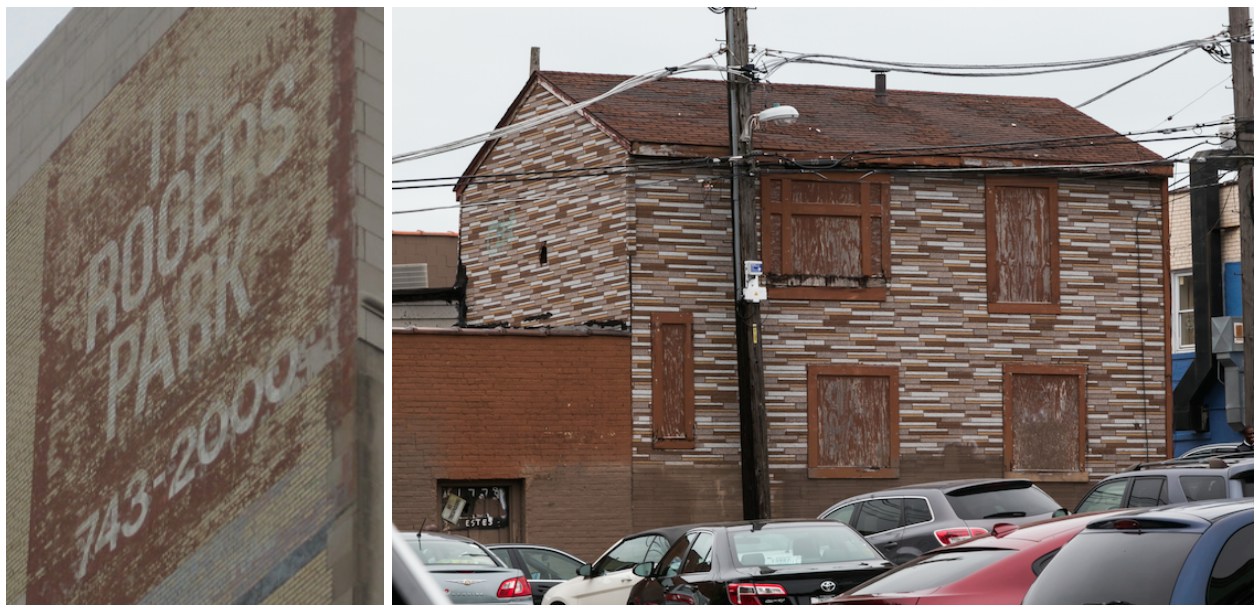
Left: Dave Gudewicz Right: Matthew Kaplan
A sold-out group joined Forgotten Chicago on a brisk Sunday, May 31, 2015 for our first-ever tour of Rogers Park, one of Chicago’s most dynamic and diverse neighborhoods. This tour examined the neighborhood’s history as a suburban community, its annexation to the city, and its era as a lakefront resort community. Among the many remnants of Rogers Park’s past we visited included a painted sign for a Sheridan Road apartment building above left that predates the introduction of the (773) area code nearly 20 years ago, and an often-overlooked two-story former horse stable above right just steps from busy Clark Street.
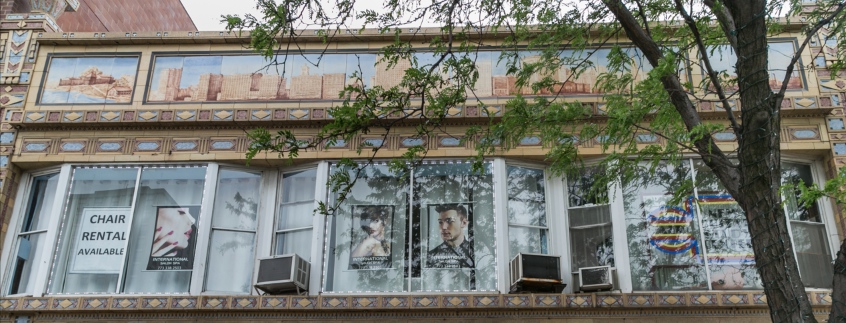
Matthew Kaplan
Our Rogers Park tour examined development patterns, densification, overlooked architectural landmarks, and remnants of long-gone forms of transportation, commercial and entertainment districts, a former synagogue, Rogers Park’s only built Shoreline Motel, and much more was covered on this all-new tour of Chicago’s northernmost community. This tour ended at perhaps the most unique artwork commemorating Chicago’s built environment, a nearly 95-year old terra cotta rendering of Chicago’s 1922 skyline, seen above. Many thanks who braved the brisk weather to join us on this tour!
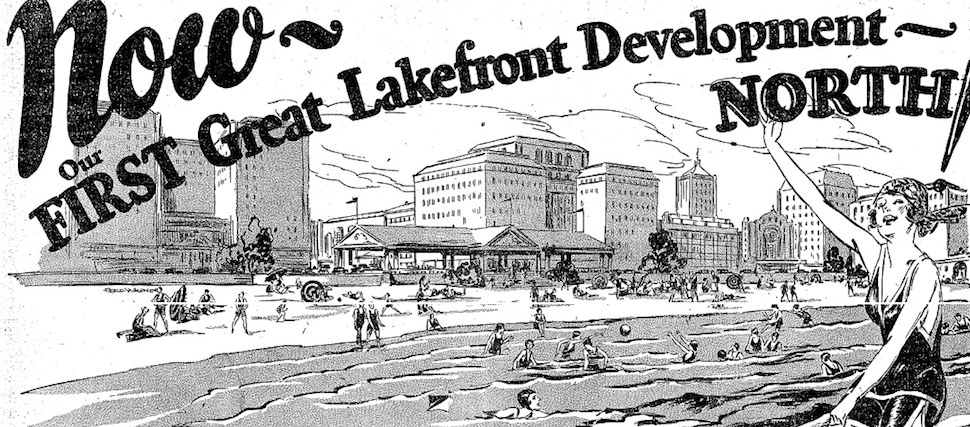
Chicago Tribune
Following a standing-room only presentation for 85 guests in November 2014, Forgotten Chicago offered another exclusive and all-new free presentation at the Bezazian Branch of the Chicago Public Library on Saturday May 16, 2015 on decades of unrealized plans for Chicago. During this presentation, we shared some of our enormous research database on the city that doesn’t always work, including an utterly forgotten and outrageous Roaring Twenties plan for a Miami Beach-style community, complete with water-skiing beauties, along the North Shore and rediscovered by Forgotten Chicago in 2015.
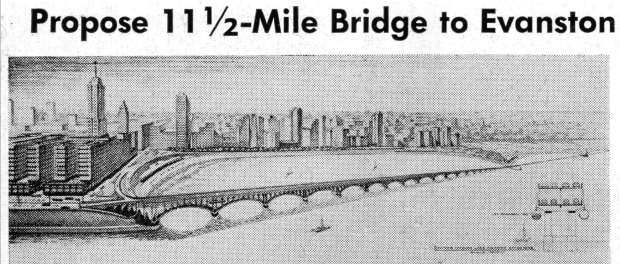
Realty and Building
Featuring dozens of projects from Forgotten Chicago’s enormous research database, most not republished or seen in decades, this presentation included a special emphasis on unbuilt projects in Uptown, including a rather impractical monorail and bridge to Evanston from Oak Street, with a stop in the middle of Montrose Beach, as seen above. We discussed everything from doomed urban renewal and civic projects, unrealized rail and road projects, and the many privately-funded projects that did not make it past the drawing board. Many thanks to those who joined us as we explored decades of unbuilt Chicago!
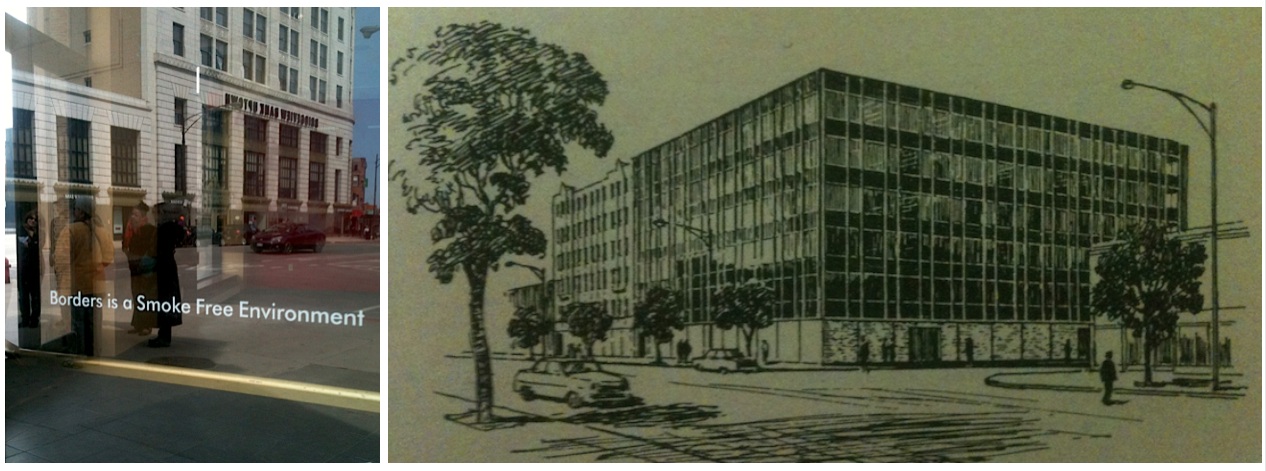
Left: Patrick Steffes Right: Bezazian Branch of the Chicago Public Library
On Saturday, April 18, 2015, a sold-out tour on behalf of the Society of Architectural Historian’s 68th Annual Conference, Forgotten Chicago explored the Uptown neighborhood, Chicago’s grandest outlying commercial and entertainment district. From its beginnings as an upper-middle class suburb to the booming entertainment and shopping district of the 1920’s, Uptown has evolved into a veritable menagerie of people and cultures, all of which is reflected in Uptown’s strikingly diverse built environment. Remnants of Uptown’s past are everywhere, including a door sign still stating that the Borders store on North Broadway is smoke free, more than three years after this chain vanished, as seen above left.
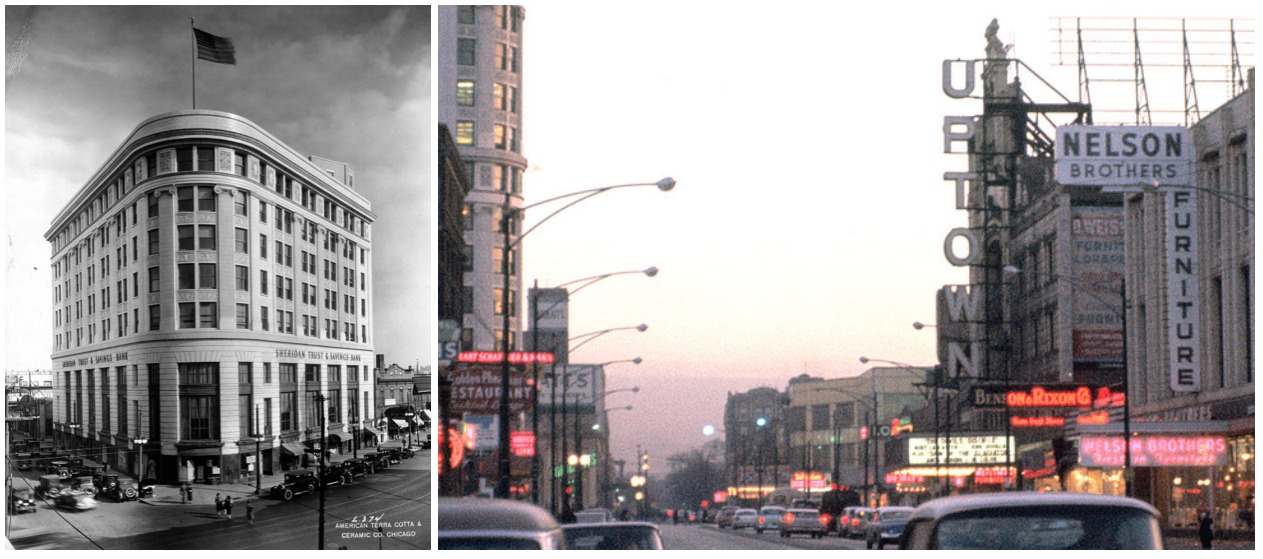
Left: American Terra Cotta and Ceramic Company Records (N 5), Northwest Architectural Archives, University of Minnesota Libraries, Minneapolis, 1928 Right: OldChicago, 1960
The built environment of Uptown is a snapshot of the city itself, including outstanding examples from the early 20th century, movie palaces, hotels and commercial buildings from the 1920s, postwar urban renewal, rapid transit and parking facilities, and much more. Many thanks to the SAH participants and guests who joined us on this tour!
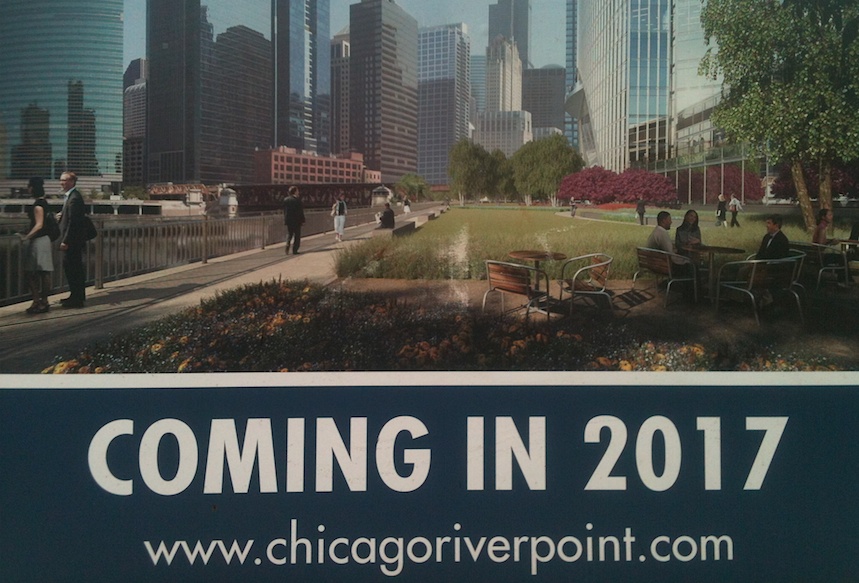
Patrick Steffes
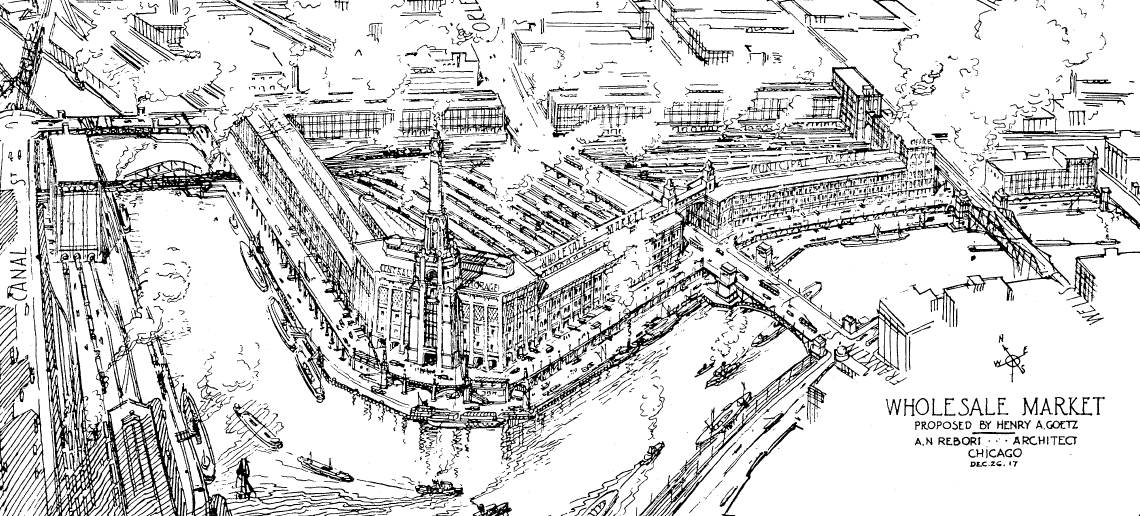
Western Architect
On Friday, April 17, 2015 Forgotten Chicago conducted a sold-out tour on recent architecture along North-South Wacker Drive and Wolf Point for the Society of Architectural Historians in conjunction with their 68th Annual Conference. Besides examining the hundreds of millions of dollars in investments in new projects in the area, we discussed the long history of the area in the founding and development of Chicago going back to the 1830s. Additionally, we shared a portfolio of more than 20 images of past and future projects, including a previously unknown 1917 project by Andrew N. Rebori for a wholesale market on what is now the Merchandise Mart and Wolf Point, discovered by Forgotten Chicago in 2014.
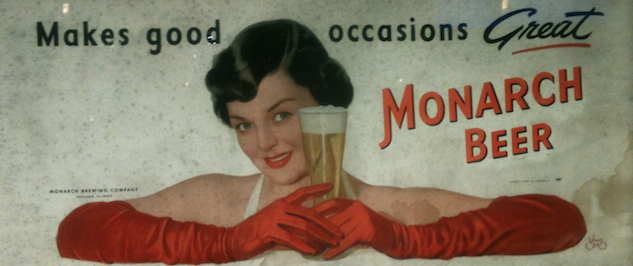
Patrick Steffes
Chicago’s brewing industry is currently experiencing a boom not seen since perhaps the 1890s, with new independent breweries and brewpubs opening on what seems like a weekly basis. On Saturday, January 11, 2015 Forgotten Chicago and Elizabeth Garibay of History on Tap presented an all-new and exclusive tour exploring some of the many remnants of Chicago’s more than 180 years of brewing history. Forgotten Chicago explored brewing industry remnants in a 2009 article; we took a look at what remains of several of these breweries and tied houses during this tour, exploring neighborhoods as disparate as Pilsen and Little Village, Lake View and Ukrainian Village.
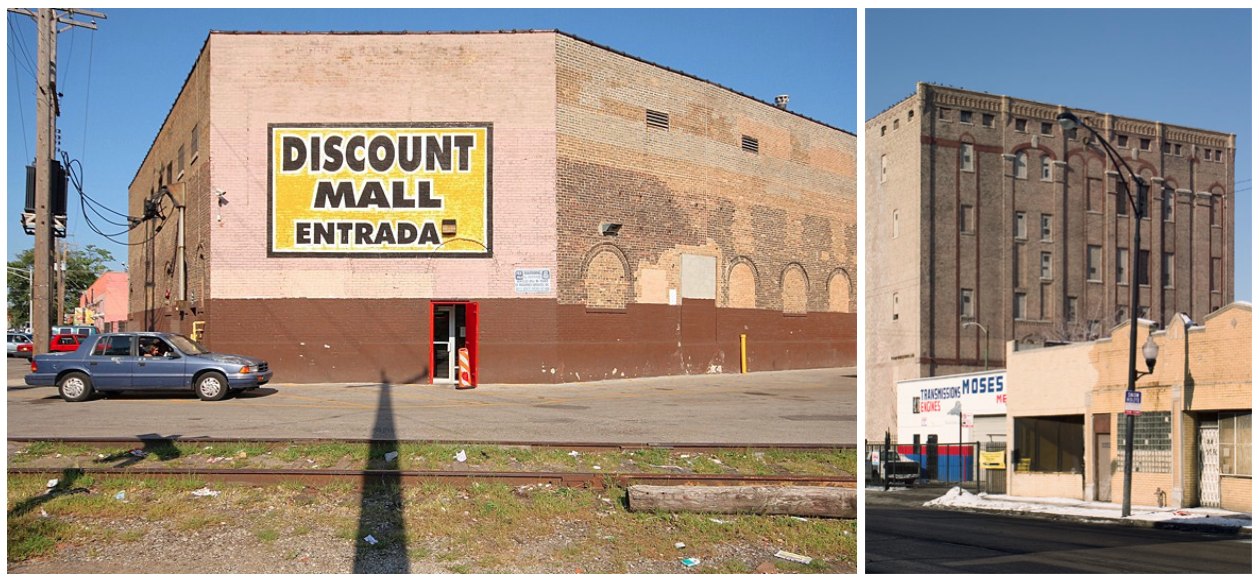
Left: Noah Vaughn Right: Serhii Chrucky
Starting appropriately enough at a former Schlitz tied house, now Southport Lanes & Billiards, we took a look at many of these relics and remnants of breweries and tied houses, many hiding in plain site. We also drove past the former Pilsen Brewing Company above left, now a discount mall, along with Mutual Brewery above right, closed for 90 years and still remarkably intact. This tour also included a stop at the Happy Village, a former Peter Hand tied house, and ended tour at one of Chicago’s newest breweries, Atlas Brewing Company for a delicious pint of one of their signature beer
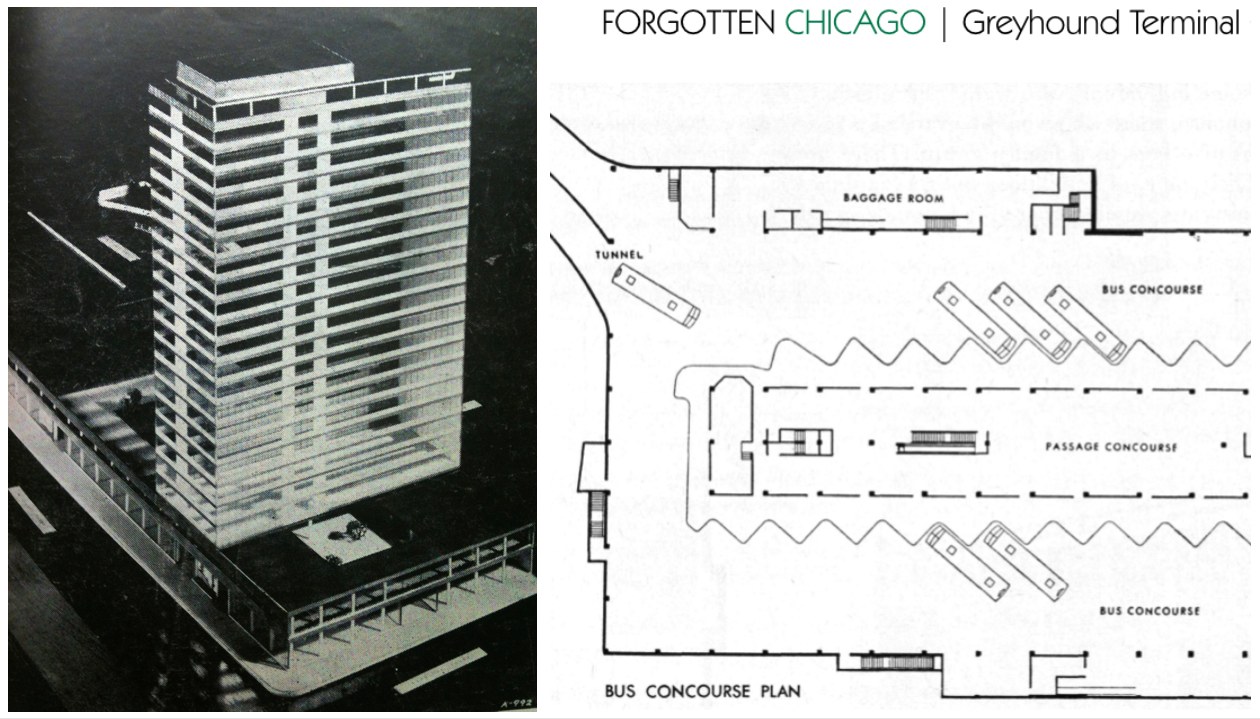
Left: Realty and Buiding, 1949 Right: Architectural Record, 1954
A group of nearly 70 guests enjoyed a free, special Forgotten Chicago presentation by Patrick Steffes on behalf of Terminal Town on Thursday, December 4, 2014 on two of Chicago’s most forgotten former transportation landmarks, the Greyhound and Trailways bus stations, both once located on busy Randolph Street in the heart of the Chicago Loop. Held in conjunction with Friends of Downtown and The Chaddick Institute for Metropolitan Studies at DePaul University, this presentation commemorated the 25th anniversary of the closing of the Greyhound terminal at Clark and Randolph in December 1989; when it opened in 1954 this terminal was the world’s largest independently operated bus station, as well as a remarkable multi-level engineering achievement.
Notably, when the Greyhound terminal was announced in 1949, its design by Skidmore, Owings and Merrill included plans for an ultra-modern office tower above left that predated the completion of SOM’s iconic Lever House in New York City by three years. The Greyhound terminal also featured a unique private tunnel that funneled hundred of buses per day from Lower Wacker Drive to the underground bus concourse area, two stories below the Loop, as seen above right.
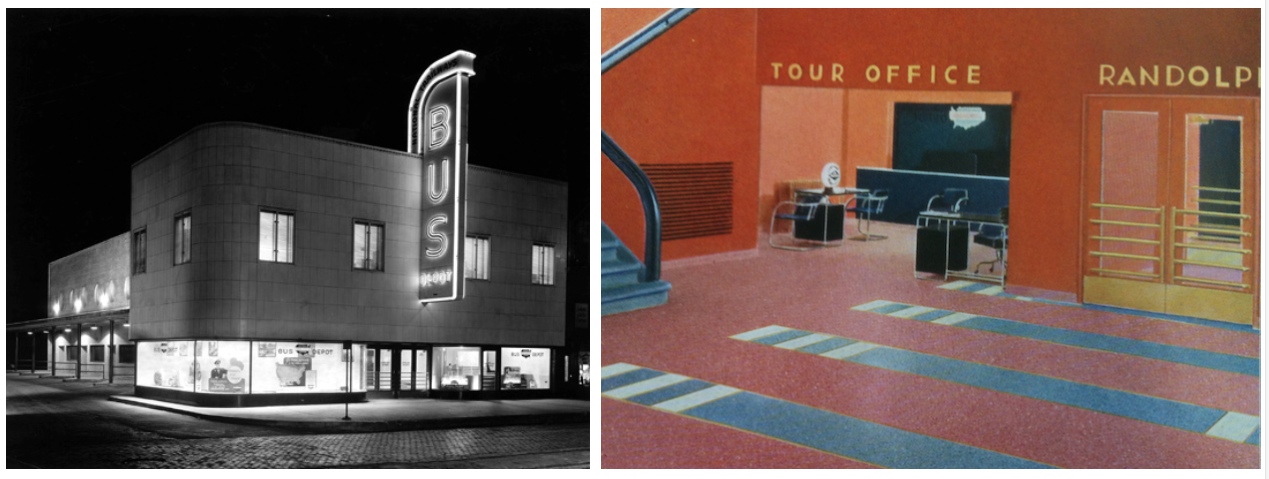
American Architect and Architecture, 1937
This presentation was one of many components of Terminal Town, a festival of events showcasing Chicago’s extraordinary role as a center of U.S. passenger transportation. Running from September 2014 through April 2015, Terminal Town offers everyone in the metropolitan region opportunities take part in presentations, special events, tours and competitions. This presentation also discussed the Art Deco former National Trailways Bus Depot on Randolph Street between State and Wabash, a modest building on a tight urban site. Many thanks to those who joined us to commemorate how these often-overlooked bus stations have made to the region’s transportation network!
About the Terminal Town book: Featuring 48 stations and terminals through short narratives, 215 color photographs, and 20 custom maps, Terminal Town provides a fascinating portrait of the city’s famously complex and constantly changing transportation system. More information on this invaluable Chicago transportation and historical reference book may be found may be found here.
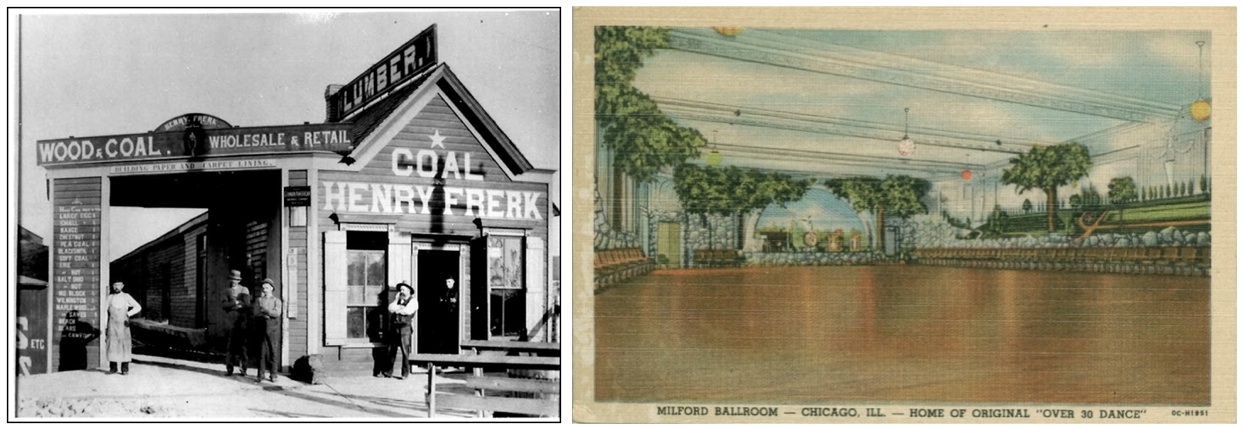
Left: Photo courtesy of Matthew Wolf Right: Chuckman Collection
In November, Forgotten Chicago authors Dan Pogorzelski and Jacob Kaplan gave two presentations on the history of Avondale, as well as discussing their recently published book on this fascinating Northwest Side neighborhood. The first presentation was on Wednesday, November 12, 2014 at the Portage-Cragin branch of the Chicago Public Library. The second presentation was on Tuesday, November 18, 2014 at Mirabell Restaurant & Lounge, an authentic German-style landmark since 1977 at 3454 West Addison.
These presentations were the two most recent in a series of events since the publication of this book in July 2014. Utilizing many rarely-seen images (including many not published in the book), the authors explored the development of Avondale and its often-colorful history. The authors discussed the history of Henry Frerk Sons seen above left, and Avondale business landmark on Belmont just east of Kedzie for more than 125 years. Also discussed was the Milford Ballroom shown above right, which once featured the “Original Over 30 Dance.” Many thanks to those who joined us for these two presentations!
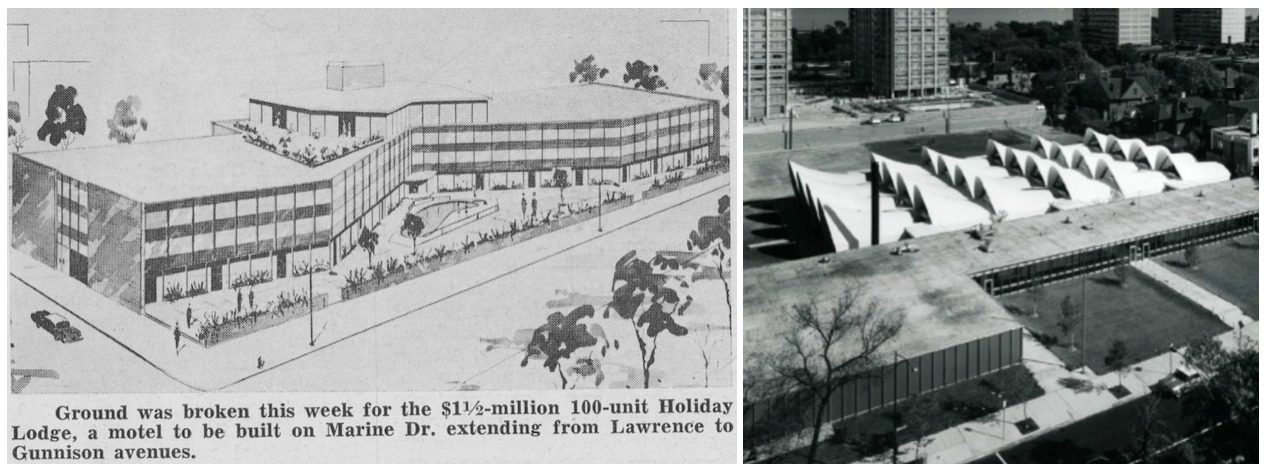
Left: Realty and Building, 1959 Right: www.bertrandgoldberg.org
A standing-room only, capacity crowd of 85 people enjoyed a free and all-new presentation on the long and complex history of Chicago’s Uptown community on Saturday, November 15, 2014 at the Bezazian Branch of the Chicago Public Library. In true Forgotten Chicago form, this presentation included present-day photos of the remnants that remain, demonstrating that relics of history are often hidden in plain sight. The presentation was fully illustrated with historic and present-day photos and maps, such as the 1959 Holiday Lodge Motel (later Holiday Inn) Shoreline Motel in Uptown that is still very much intact in 2014. Perhaps the most overlooked landmark in Uptown is a one-of-a-kind elementary school by Bertrand Goldberg shown above right. Although since altered, this school remains nearly completely intact (although covered with a new roof) more than 50 years after its completion.
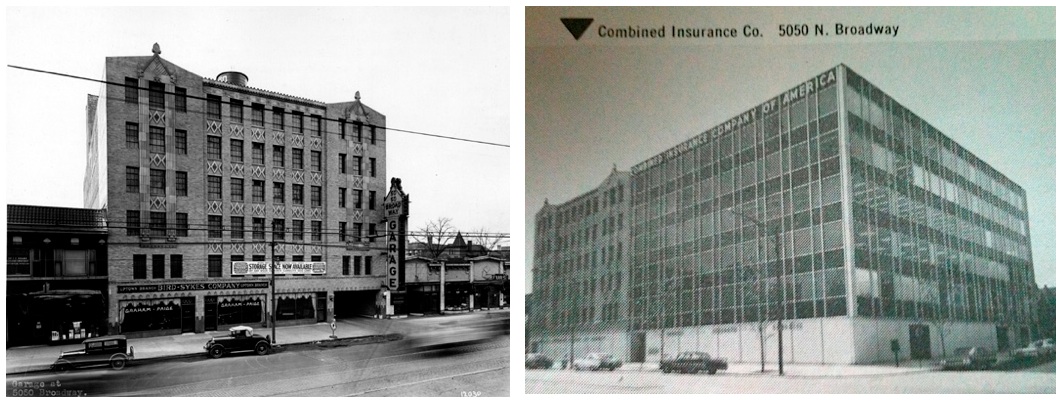
Left: American Terra Cotta and Ceramic Company Records (N 5), Northwest Architectural Archives, University of Minnesota Libraries, Minneapolis Right: Realty and Buiding, 1963
Also discussed was the 1927 parking garage at 5050 North Broadway shown above left that would be converted to an office for Combined Insurance Company of America (later Aon) in the early 1960s. Mostly empty since 2008, there are currently plans for this unique former parking garage / office building to be converted to apartments. Finally, we discussed how the heart of Uptown is about to soon undergo a profound change with the reconstruction of the Wilson CTA station, which began in October 2014, with the ongoing demolition of many buildings surrounding this station at the heart of the Uptown community. Many thanks to our standing-room only crowd!
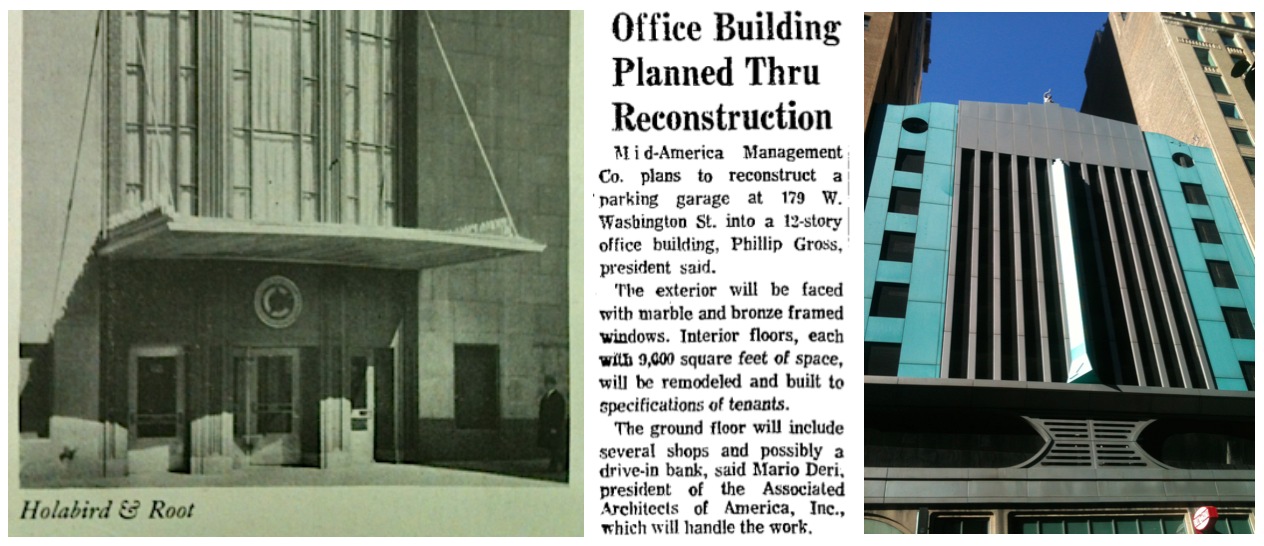
Left: Architecture, 1932 Center: Chicago Tribune, 1970 Right: Patrick Steffes
A sold-out group joined Forgotten Chicago on Sunday, September 21, 2014 for an encore presentation of our Downtown Confidential walking tour, offered for the first time since 2011. Focusing on the opposite of every other Loop walking tour by skipping well-known landmarks, we examined marginal structures like parking garages, three and four story brick buildings, abandoned buildings, and unexpected conversions. Visiting nearly 40 sites, this tour also took a look at the role the automobile has played in the Loop and environs over the decades, including Holabird & Root’s Chicago Motor Club, abandoned for years and currently being converted to hotel above left. We discussed the odd story of 179 West Washington, an 1893 mid-rise by Handy & Cady that was converted from an office building to a parking garage in 1965, back to an office building in 1970, and yet again back to a parking garage sometime after the 1980s. We also looked at Stanley Tigerman’s parking garage above right, a postmodern curiousity on East Lake Street since 1986.
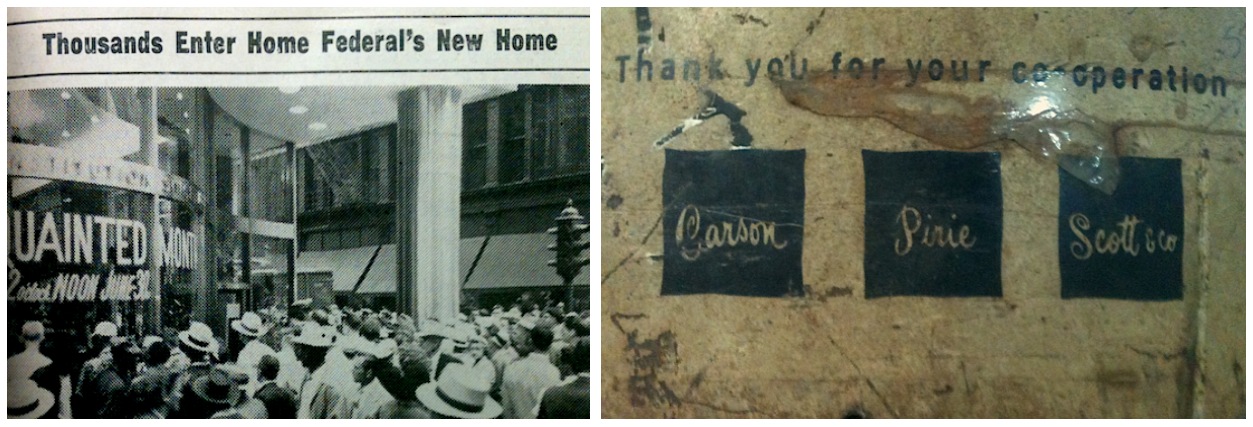
Left: Realty and Building, 1952 Right: Patrick Steffes
Focusing on sites that are, at least for now, extant, we took a look at buildings like Architect Benjamin Marshall’s 1906 Hotel Brevoort at 120 West Madison Street, converted to an office building in 1963. Additionally, we looked at a grouping of two remarkable buildings from the 1930s, the former Benson-Rixon building on South State Street by Alfred Alschuler, and its neighbor, the former Bond store by Miami Beach’s Morris Lapidus. Visible remnants of building’s former uses were seen, including an 1890s State Street building by Holabird & Roche, above left; although this building has been abandoned for years, its 1952 exterior remodeling for Home Federal Savings remains nearly completely intact in 2014. Additionally, we walked into the alley and loading zone of what was the Carson Pirie Scott flagship store until 2007, finding a decades-only sign that somehow still remains today.
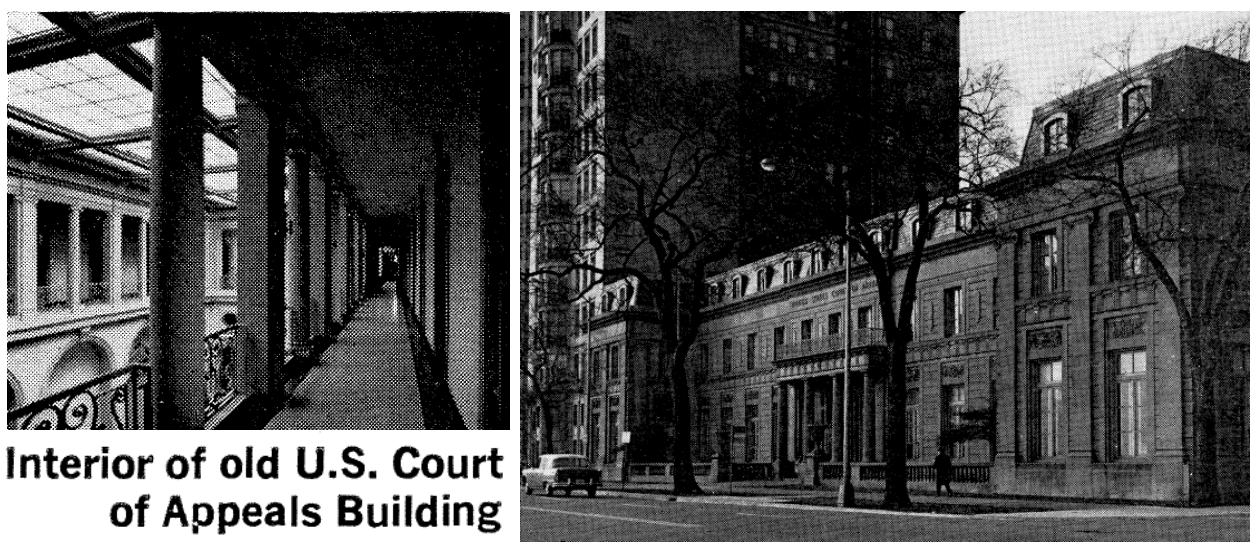
Inland Architect, 1969
On Wednesday, September 17, 2014 Forgotten Chicago gave an all-new, ninety-minute presentation and discussion at CivicLab on Chicago’s political and governmental historic sites, both known and forgotten. Covering everything from Chicago’s 26 national political conventions from 1860 to 1996 to the still extant Shoreline Motel where President Obama made his first announcement for public office in 1995, this presentation also looked at vanished government and political sites. Possibly qualifying as Chicago’s most forgotten landmark is the former U.S. Court of Appeals at 1212 North Lake Shore Drive seen above, once a lavish 1922 branch office for a Des Moines-based insurance company, later occupied and abandoned by the federal government, and briefly considered as what would later become the Museum of Contemporary Art.

From Left to Right: Wikimedia, New York Daily News, Washington Post, ExtraTV
Often as controversial as their husbands, every other U.S. First Lady since 1974 was either born in Chicago (Betty Bloomer Ford, Hillary Rodham Clinton and Michelle Robinson Obama) or spent their adolescence here (Nancy Davis Reagan). Historic Chicago sites related to First Ladies are almost completely forgotten today; the location of Betty Ford’s Chicago birthplace is rarely mentioned in biographies of her, and Hillary Rodham Clinton’s Chicago apartment was demolished decades ago. Additionally, Clinton’s birthplace in Edgewater has been abandoned since 2001, and may or may not be demolished before the 2016 election. Using rarely seen images and ephemera, many not seen in decades, we wish to thank those who attended this exclusive presentation on Chicago’s lesser-known political and governmental landmark locations, past, present, and future.

Patrick Steffes
The many relics and remnants of the Albany Park neighborhood were explored by a sold-out Forgotten Chicago tour on Sunday, September 7, 2014. One of the most diverse neighborhoods in the U.S., Albany Park has been home to a changing kaleidoscope of countless ethnicities, cultures, and religions. Many religious buildings have been repurposed over the years, from Jewish community centers and synagogues to a 1920 church whose original name has been obliterated above left. We also took a look at the ambitious Ravenswood Gardens subdivision developed more than 100 years ago, including the altered marker along Lawrence Avenue, above right. We discussed how Albany Park was once one of Chicago’s largest and most concentrated automobile sales districts, with many intact buildings dating back more than 90 years.
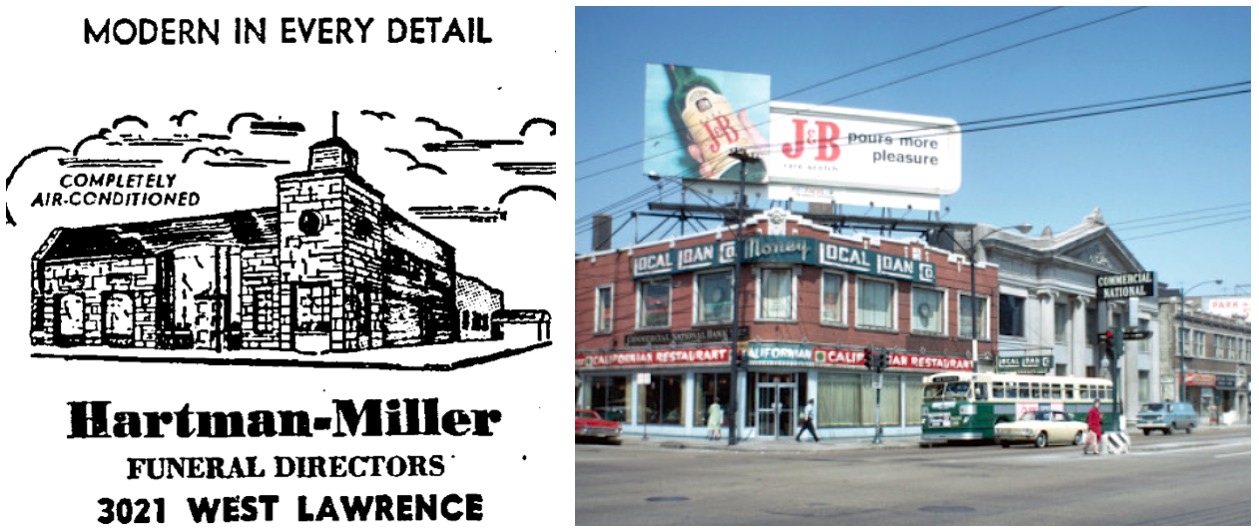
Left: Chicago Tribune, 1953 Right: C. William Brubaker Collection, University of Illinois at Chicago, 1967
Lawrence Avenue east of Pulaski Road contains some of the most intact pre- and post-World War II commercial buildings in Chicago, including the “Modern in Every Detail” former Hartman-Miller funeral home seen above left, now a market and convenience store; its terrazzo is still intact at the entrance. We also discussed the former Commercial National Bank at the busy corner of Lawrence and Western above right; the building remains a bank and its façade has been modernized, but its peaked roof seen above right can still be seen from this busy intersection today. Fittingly, we concluded our ethnic explorations by ending this tour in Lincoln Square at one of Chicago’s largest annual street festivals, the always-lively German Fest.
A near-capacity crowd joined Forgotten Chicago at the Logan Square Comfort Station on Saturday, August 23, 2014 for a discussion on the odd story of Pennock, Illinois, a one-time industrial and residential suburb of Chicago that was abandoned and (mostly) vanished more than 110 years ago. Founded by the same colorful huckster that founded Homer, Alaska and long-since absorbed by the City of Chicago, Pennock’s long shadow continues to this day. Besides appearing as a train station for decades as seen above, users of Google and Bing maps can type in “Pennock, IL” in 2014 and be curiously directed to near the intersection of Pulaski Road and Wrightwood Avenue.
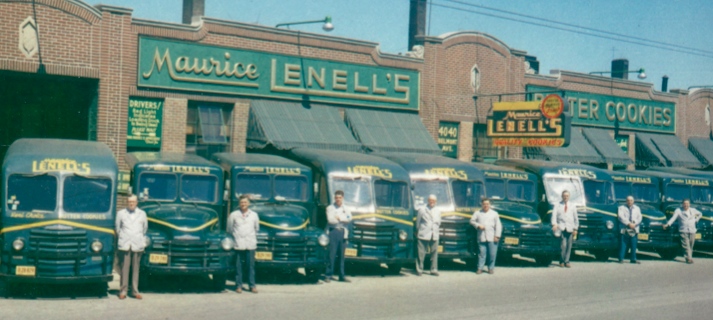
Jill Bocskay-Cardalucca
Sharing rarely-seen images of Pennock, Avondale and Logan Square, this presentation discussed the long and complex history of these Northwest Side neighborhoods of Chicago, including transportation, industry, and ethnic enclaves. One of the best-loved industries in the area was the former Maurice Lenell Cookie Company, located on Belmont Avenue until the 1950s, as shown above. The enormous disruption caused by construction of the Northwest (later Kennedy) Expressway was also discussed in depth, as well as the discovery by Forgotten Chicago in 2014 of original homes built for Pennock still standing today. Many thanks to those who joined us for this exclusive presentation!
A sold-out group joined Forgotten Chicago on Sunday, August 17, 2014 exploring Chicago’s historic Noble Street and environs, along with the rapidly changing intersection of Division, Milwaukee and Ashland. This once-bustling Noble Street corridor (once with its own streetcar line) has been substantially altered and partially removed since the days it served as Polish Chicago’s original main thoroughfare. This tour also explored other often-overlooked sites, such as the currently abandoned former Chicago Commons Settlement House on Grand Avenue above left, the former Kosciusko Public Bath house above center, and a curious and forgotten Mayor Michael Bilandic-era Expressway Park, above right.
This tour also discussed how diverse phenomena such as the Progressive Movement, the construction of the Kennedy Expressway, and changing demographics seriously impacted the built environment of the neighborhoods anchored by Noble Street. We looked closely at religious, political and civic landmarks, along with the usual fragments and oddities found on every Forgotten Chicago tour. Finally, we took a close look at the now-endangered former movie theatre building that directly led to the founding of Carl Laemmle’s Universal, the world’s first major movie studio, less than 10 years after opening on Milwaukee Avenue in 1906.
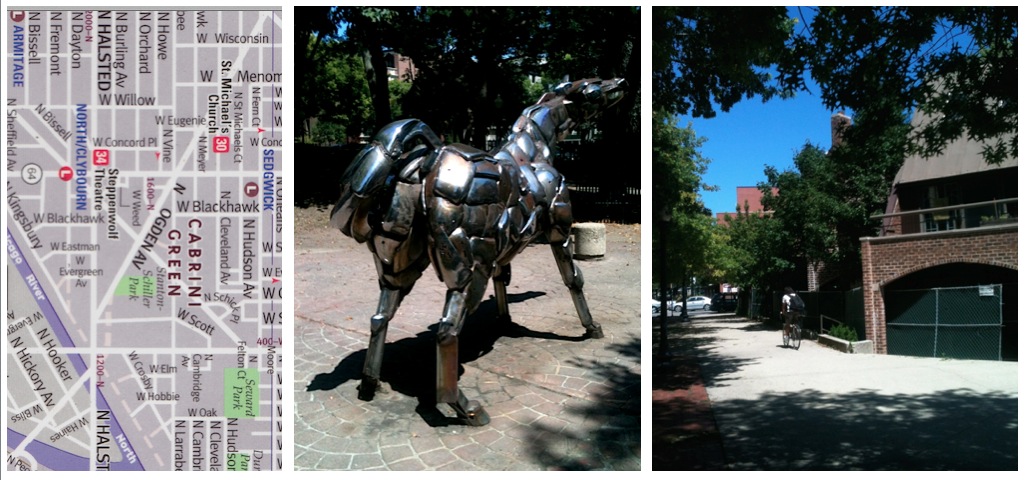
Left: VanDam Street Smart Chicago, 2004 Center and Right: Patrick Steffes
A sold-out group joined Forgotten Chicago on Sunday, August 10, 2014 for our first tour since 2011 on the extension and removal of Ogden Avenue, a curious and mostly forgotten chapter in Chicago transportation and infrastructure history. Explored by Forgotten Chicago in a 2009 article, Ogden Avenue was extended north into a major arterial street from Union Park to Lincoln Park at enormous expense and disruption in the 1930s, only to be closed in stages starting in 1967. This tour explored the entire length of the former Ogden Avenue, including the John Kearney car bumper sculptures along the former Ogden Avenue right-of-way above center. Sadly, Kearney died at age 89 in Chicago on the same day as our tour. We also took a look at the doomed strip mall on the former Ogden Avenue right of way seen above right, demolished shortly after this tour for some of Chicago’s most expensive new condominiums, as recently reported by Curbed Chicago.
In addition to some of the best remaining 1970s-era streetscapes in Chicagoland, this tour explored the long-time site of Siebens, the longest-operating brewery in Chicago history, the former home of the first female gubernatorial candidate in Illinois, Dawn Clark Netsch, and her husband, famed architect Walter Netsch. We also took a look at the quarter-billion dollar development under construction at the site of the colorful former New City YMCA, and the numerous hiding-in-plain-site remnants of the former route of North Ogden Avenue.
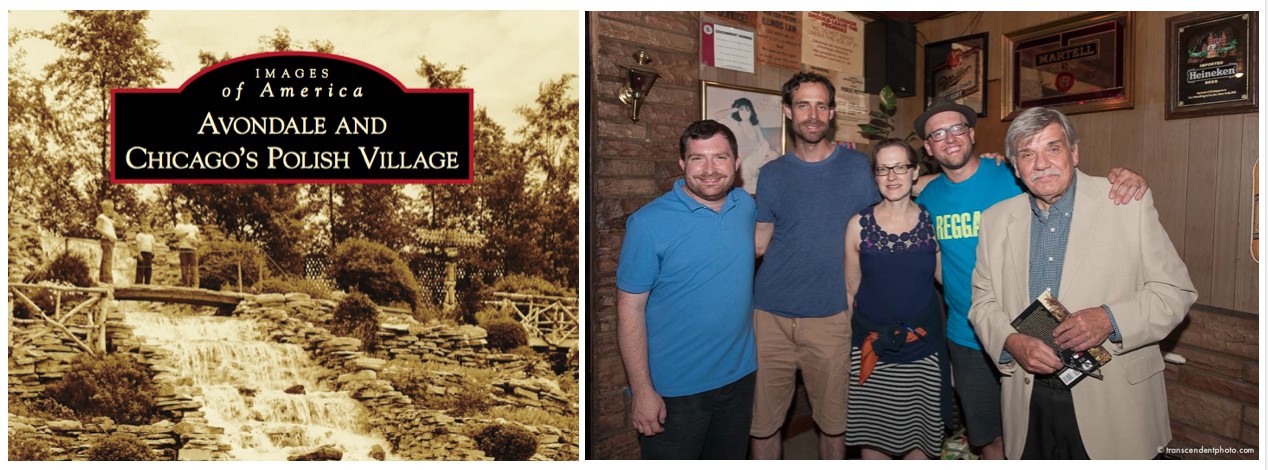
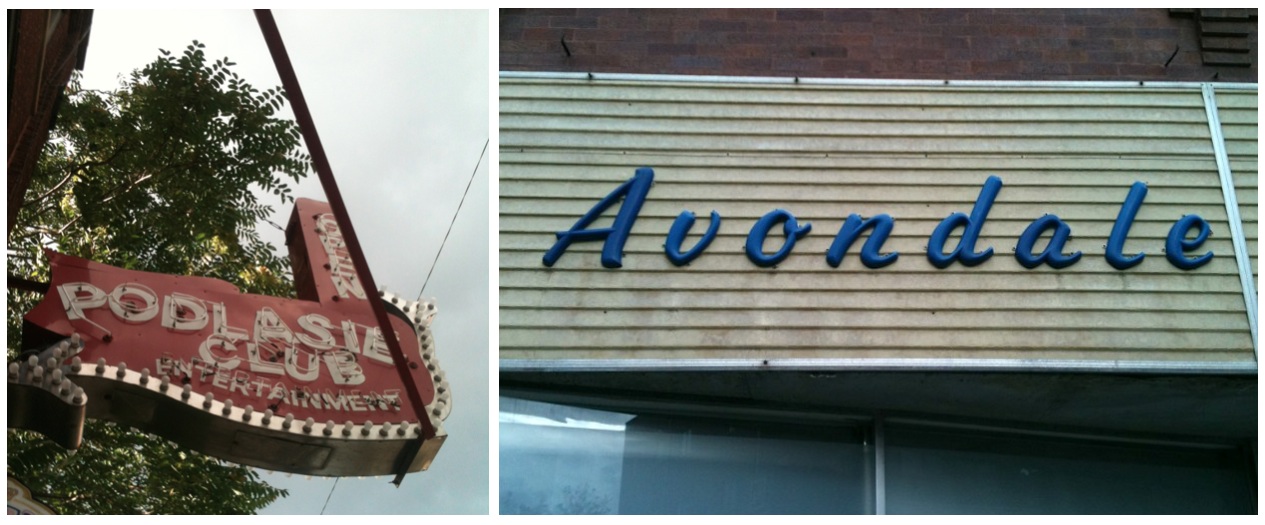
Top Left: Arcadia Publishing Top Right: Courtesy of Dariusz Lachowski and Dziennik Zwiazkowy Bottom Left and Right: Patrick Steffes
A group of 75 people joined the authors of “Images of America: Avondale and Chicago’s Polish Village” on Sunday, July 27, 2014 for a launch party celebrating the publication of this new book, the second by Forgotten Chicago Editor Dan Pogorzelski. Held at one of Chicago’s best and most authentic old-school bars, Podlasie Club on North Central Park just south of Milwaukee Avenue in the heart of Avondale, all of the book’s authors were present for this event. These included at top right from left to right Jacob Kaplan, Rob Reid, Dan Pogorzelski, Elisa Addlesperger, and Dominic Pacyga, PhD, author of the book’s foreword and one of Chicago’s most preeminent and celebrated historians. Offering an in-depth look at this fascinating and often-overlooked community on Chicago’s Northwest Side, copies of this book may be purchased here. Many thanks to the fans and residents of Avondale who joined us for this event!
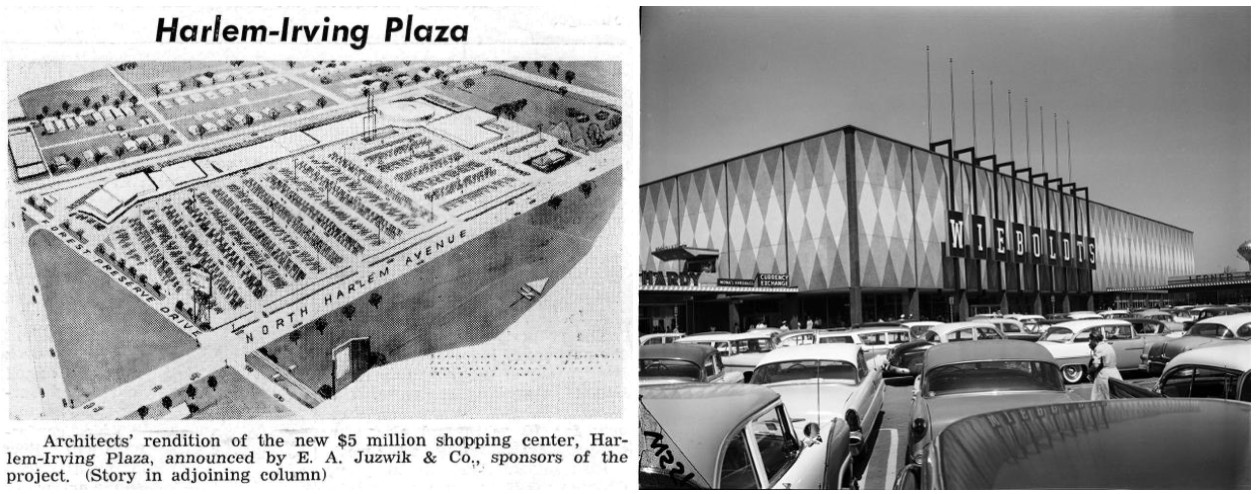
Left: Realty and Building, 1955 Right: Craig’s Lost Chicago
Forgotten Chicago’s first-ever bicycle tour of the far northwest side took place on a sunny Sunday, July 27, 2014. This exclusive and all-new tour covered a wide area and visited a large number of sites including the curious circular streets of Norwood Park, the oldest extant home in Chicago, as well as the highest point in Cook County and home to Chicago’s oldest cemetery, dating from 1838. This tour also enjoyed a fascinating presentation of the area by community leader and Eli’s Cheesecake President Marc Schulman, which included delicious samples of their famous desserts.
In addition to historic sites in Norwood Park Township, this tour explored the more recent history of this area and architectural landmarks, including the last completed work by architect Bertrand Goldberg, along with an almost unrecognizable 1950s home by Goldberg in Harwood Heights. We also biked through the village of Norridge and took a close look at one of the Chicago area’s oldest major shopping centers, Harlem Irving Plaza, the antithesis of a dead mall and still wildly popular nearly 60 years after opening. In typical Forgotten Chicago fashion, we discussed the original elements still visible at the HIP, including Barancik, Conte & Associates former Wieboldt’s department store seen above right, and surprisingly intact today.
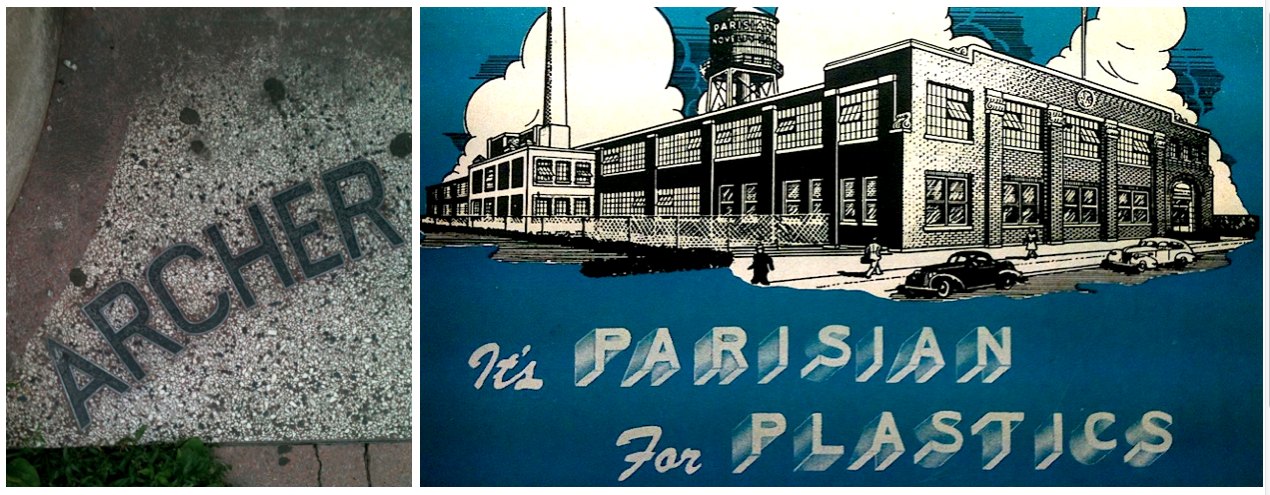
Left: Patrick Steffes Right: Commerce, 1950
A sold-out group joined Forgotten Chicago for our first-ever walking tour of the often-overlooked neighborhoods of McKinley Park and Brighton Park on Sunday, July 20, 2014, an area rich with Chicago history and culture. These neighborhoods were notably home to some of Chicago earliest factories, including the Parisian Novelty Company on South Western Avenue shown above, a company in business from 1898 until closing in recent years. We also took a look at the nation’s first planned industrial park, the massive Central Manufacturing District fronting Pershing Avenue. Additionally, we explored the innovative Progressive Era McKinley Park, an influential model for many other Chicago parks.

Patrick Steffes
Archer Avenue in Brighton Park has some of Chicago’s best-preserved storefronts, signs and terrazzo, including the unique children’s clothing store sign shown above. These two neighborhoods numerous churches were also explored, including the site of a historic mass for Pope John Paul II in 1979. Other highlights seen during this tour included Chicago’s oldest operating automobile dealership, the former home of what was purportedly the wealthiest union in the U.S. and “under control of the Kremlin,” a Schlitz tied house tavern, early landmarks of the Lithuanian and Irish communities, an endangered former church recreation building, two early nickelodeon movie theaters, and much more.

Patrick Steffes
On Tuesday, July 15, 2014 nearly 200 guests, the largest crowd yet for a Forgotten Chicago event, enjoyed a one-night-only program celebrating Chicago movie theater history at the Portage Theater, a Six Corners landmark for nearly 95 years. Hosted by Ward Miller, Executive Director of Preservation Chicago, and including a presentation by acclaimed author, editor, and Northwestern University’s Distinguished Senior Lecturer Bill Savage, this event took place in the 1920 Portage Theater, a Six Corners landmark that recently reopened after being closed for more than a year.
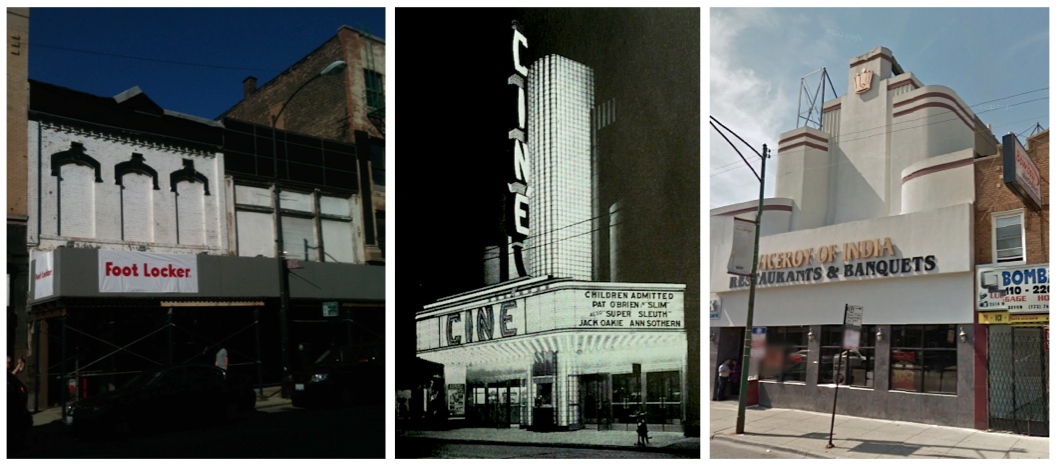
Left: Patrick Steffes Center: Pencil Points, 1938 Right: Google Street View, July 2011 Right: Chuckman Collection
This program included an exclusive presentation on many of Chicago’s overlooked and forgotten movie theaters, many hiding in plain site. One of the most significant movie history sites in the country is the 1200 block of North Milwaukee Avenue shown above left, the former site of Chicago resident Carl Laemmle’s White Front Theater, a 1906 nickelodeon that would ultimately lead to the founding of what would become Universal Studios in Southern California less than 10 years later. Several buildings on this block were purchased in late 2013, their fate currently unknown.
Another of Chicago’s many overlooked former theaters is the former Cine Theater on West Devon Avenue, seen above left and center. which opened in 1937, closed more than 60 years ago, but remains standing and partially altered today. More information on the wide variety of entertainment available at the Portage Theater may be found here. Many thanks to everyone who joined us for this exclusive Forgotten Chicago event!
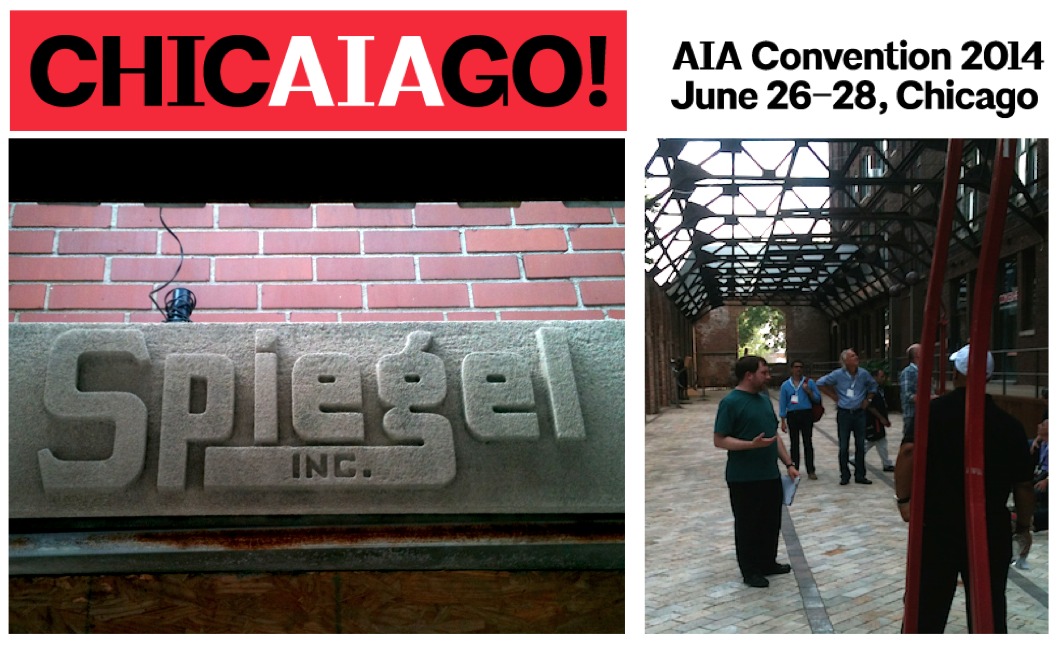
Top: American Institute of Architects Bottom: Patrick Steffes
In June, Forgotten Chicago conducted two walking tours for the American Institute of Architect’s AIA Convention 2014. On Wednesday, June 25, we reprised our popular Chinatown tour, showing convention attendees the many fascinating aspects of this dynamic neighborhood. On Friday, June 27, we conducted a walking tour of the historic Bridgeport community, with one of the many highlights included a building once used by Spiegel, a former employer of First Grandmother Michelle Robinson, shown above left. We also took a look at Chicago’s shortest street, the remarkable Palmisano Park, ethnic diversity, Bridgeport’s six Chicago mayors, and the vast Bridgeport Arts Center, seen above right.
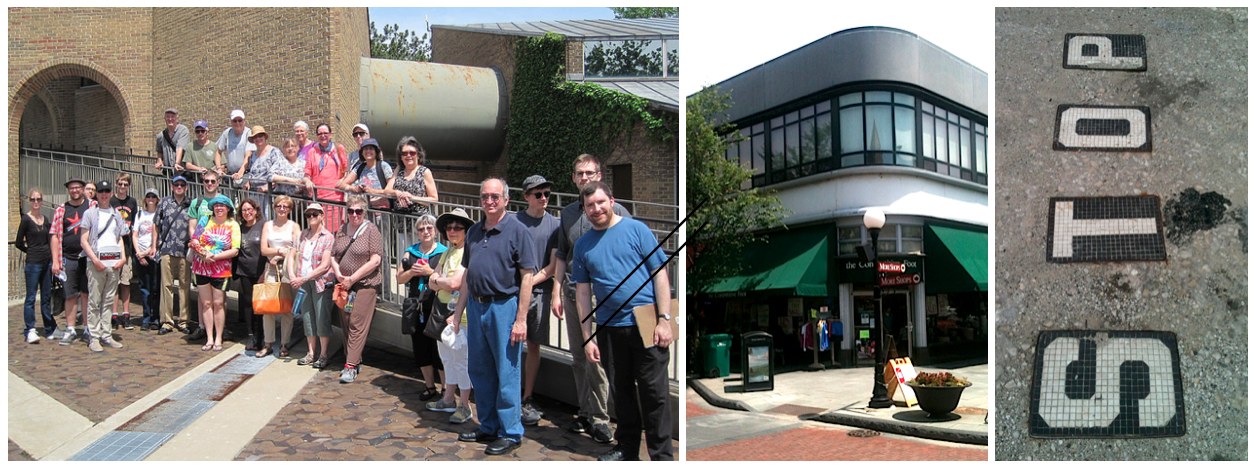
Patrick Steffes
A sold-out group joined Forgotten Chicago for our first-ever tour of the overlooked built environment of Oak Park on Sunday, June 22, 2014. This all-new and exclusive tour took a close look at more than 40 of Oak Park’s mostly forgotten sites by a wide variety of some of the region’s leading architects since the 1920s. One of the highlights was Harry Weese’s remarkable Village Hall, dedicated in 1975 and shown above and below left.
This tour also looked at many extant buildings by the iconic firm of Holabird & Roche (later Holabird & Root), such as their 1929 Forsyth Building, above center. Additionally, we discussed a dramatic 1962 apartment building by the firm of Shayman & Salk seen below right, architects of several Shoreline Motels, previously examined in a series of four Forgotten Chicago articles.

Left: Inland Architect, 1974 Center and Right: Patrick Steffes, January 2014
Besides buildings by noted architects, we looked at Oak Park’s many retail relics and still-standing former department stores such as Lytton’s and Montgomery Ward, and shared little-seen images of the Lake Street section of the 1974 pedestrian mall, demolished in the late 1980s. Additionally, we took a look at Oak Park’s many other Art Deco landmarks, a 1913 former movie theatre, a one-time Masonic Temple, and numerous automobile dealerships from the 1920s to the 1940s, and pioneering early radio station WTAY (“Wireless Tunes Await You”). Finally, we discussed Oak Park’s long history of racial integration and progressive politics, staunch independence from and interdependence to Chicago, and the usual oddities and fragments found on every Forgotten Chicago tour.
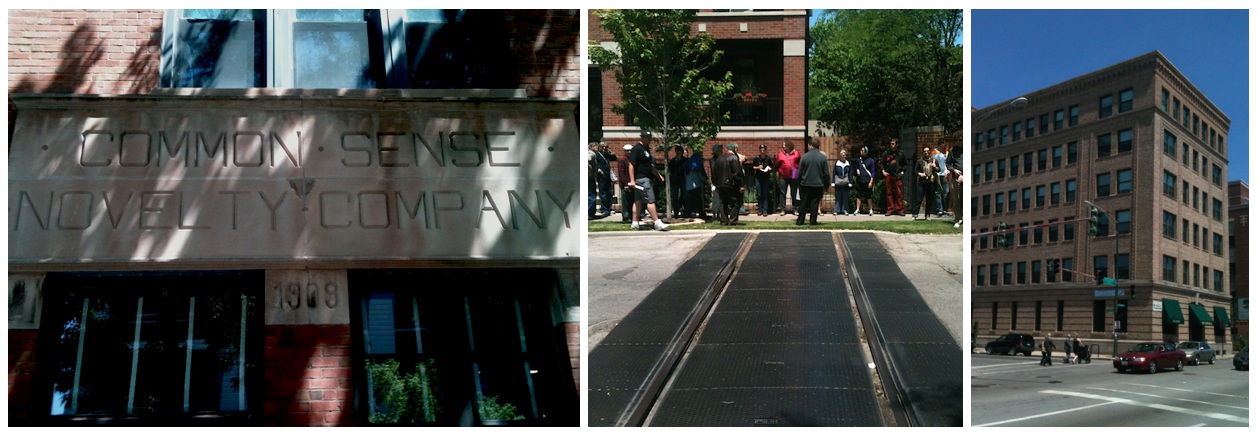
Patrick Steffes
A sold-out group joined Forgotten Chicago on Sunday, June 8, 2014 for an encore of our exclusive Industrial Lincoln Park tour, offered for the first time since 2010. Some of the more than 30 sites visited included the former Common Sense Novelty Company, above left near the DePaul University campus. Although the company left this location more than 90 years ago, their name and 1909 cornerstone remain intact on this building.
Other industrial remnants visited included now-disused tracks of what was originally the Chicago & Evanston Railroad, seen above center. These tracks were constructed in 1885 and once continued north past Addison, with this section shown now ending abruptly at a new residential development. The tour also took a look at an enormous former records building for the Chicago, Milwaukee, St. Paul and Pacific Railroad and occupied by the railroad until 1976; just 15% of this building is shown in the picture above right.
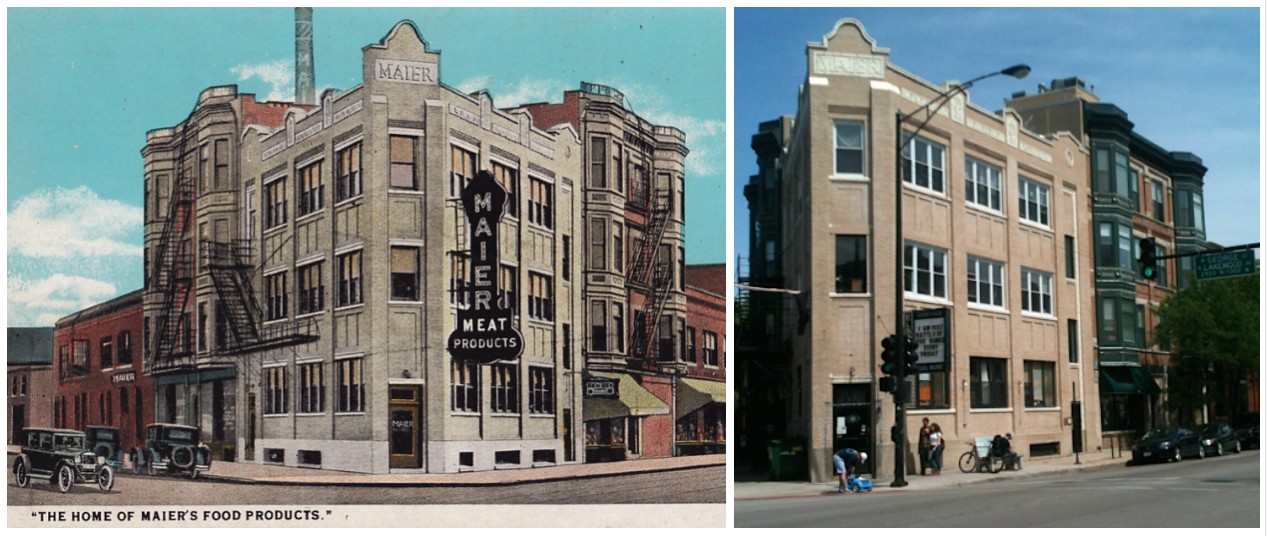
Left: Forgotten Chicago Archives Right: Patrick Steffes
Lincoln Park once produced half the blueprint paper used in the U.S. and products as varied as forgery-resistant check writing equipment, lampshade trimmings, pianos, bicycle sprockets, milk bottle caps and “pre-smoked” pipes. This tour also visited ethnic remnants, including a former Romanian Orthodox Church and Romanian community center. We examined one of the last surviving industrial facilities in Lincoln Park, the vast Finkl Steel complex, which is scheduled to close and relocate later this year. Our final stop was the former home of Maier’s Food Products, part of a former district of meat distribution outlets, on a section of Lincoln Avenue that has barely changed in ninety years as seen above.

Left: Rogers Park West Ridge Historical Society Center: Inland Architect, 1980 Right: Realty and Building, 1957
A group of 45 guests enjoyed a free presentation by Forgotten Chicago on Saturday, June 7, 2014 at the Rogers Park branch of the Chicago Public Library on the overlooked history of Rogers Park and West Ridge. This presentation explored the former Edgewater Golf Club, many long gone greenhouses that once populated the neighborhood, intact 1930s commercial buildings, movie palaces, proposed urban renewal projects, and much more. As with all Forgotten Chicago presentations, we showed present-day photos of the remnants that are visible today, demonstrating that relics of history are often hidden in plain sight.
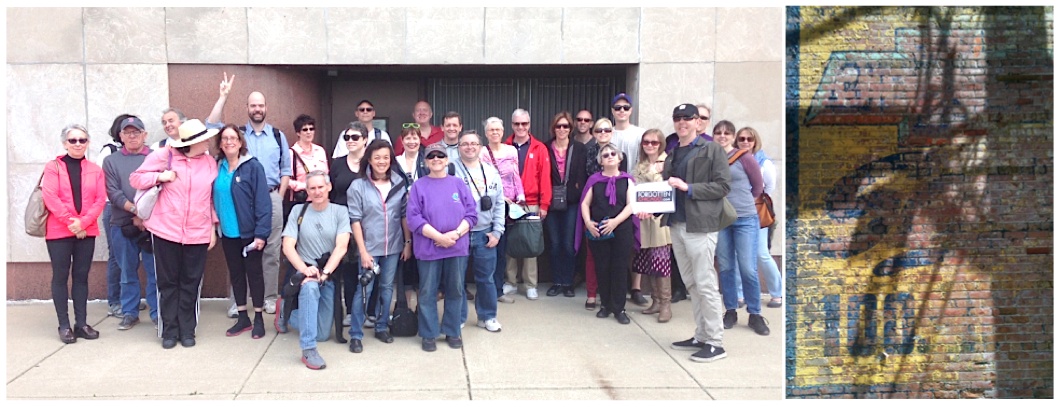
Left: Jacob Kaplan Right: Patrick Steffes
A sold-out group joined Forgotten Chicago on a beautiful afternoon on Sunday, May 18, 2014 for our first-ever tour of the ever-evolving South Loop, in a three-hour walking tour covering this fascinating neighborhood from Roosevelt Road to the campus of the Illinois Institute of Technology. This tour offered an in-depth look at the vast changes that have occurred in the neighborhood in recent decades, and continue to occur today, such as the planned construction of the new DePaul University Arena, a new CTA Green Line station at Cermak Road, and new hotels near McCormick Place. Sites visited included were two works by architect James F. Eppenstein, one of which is seen above left, and the remnants of the South Loop’s once-vast automotive sales district, above right.
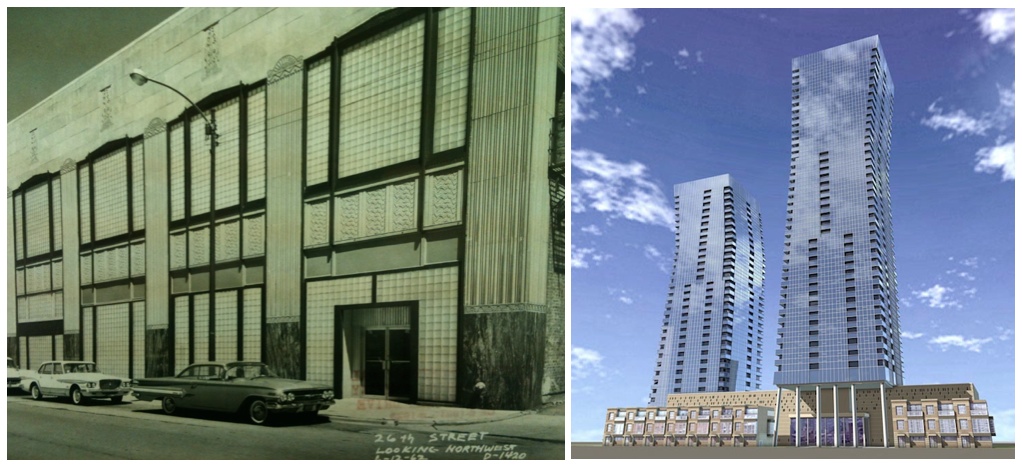
Left: Chicago Photographic Collection, University of Illinois at Chicago Right: YoChicago
This tour included forgotten and overlooked industrial and transportation remnants, the vast former St. Luke’s hospital complex, the bursting of the South Loop’s enormous housing bubble, and how the construction and expansion of McCormick Place since the late 1950s has profoundly changed this neighborhood. We also shared details and images of mostly unknown former landmarks of the area, such as the Art Deco former Studebaker dealership at the corner of South Michigan and East 26th Street above left, demolished in the mid-1960s for a parking lot. Finally, a South Loop curiosity: we visited the site of the ambitious and never-started X/O condominium project on the 1700 block of South Prairie Avenue seen above right, including a sign still indicating parking for this doomed project’s former sales gallery.

Patrick Steffes, August 2013
On Saturday, May 3, 2014 Forgotten Chicago gave our first-ever presentation on Chicago’s dynamic West Town community area to more than 50 people at the West Town branch of the Chicago Public Library. Our presentation discussed the long and complex history of West Town, with its key location near the Chicago River, the Northwest (now Kennedy) Expressway, and its eclectic mix of housing, retail and manufacturing. Also discussed was the former Snappy Service System hamburger stand on Ashland near Division seen above center, whose exterior had been painted over for decades before being suddenly revealed in March 2013, and the once-iconic Division Street Bridge, demolished in July 2014.
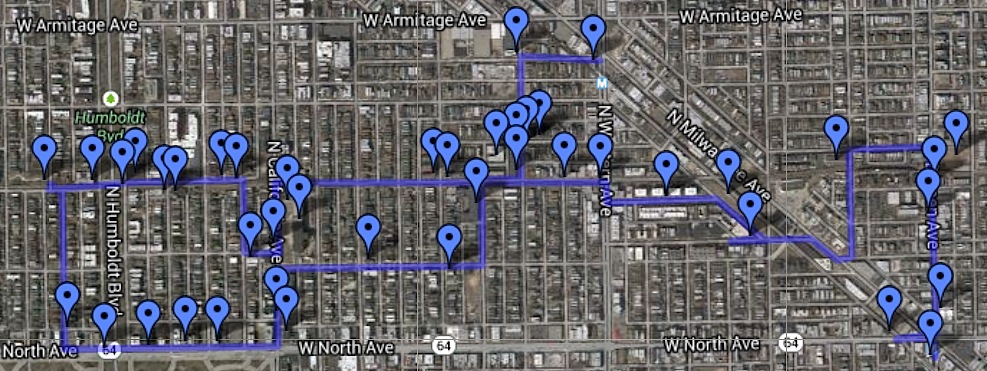
Forgotten Chicago
This presentation also detailed recent changes to the community, notably the 606 project, formerly known as the Bloomindale Trail. Forgotten Chicago conducted an in-depth tour of area around this former industrial rail line in September 2013 (sites visited on our tour are shown above), just as construction began on this $91 million project; whose history was exhaustively covered by Forgotten Chicago in May 2012
Many other aspects of West Town were also explored, including the many remnants of former “L” lines in the West Town community, extant former movie houses, the extension and removal of Ogden Avenue, urban renewal and dislocation, and much, much more. Many thanks to those who joined us in West Town!
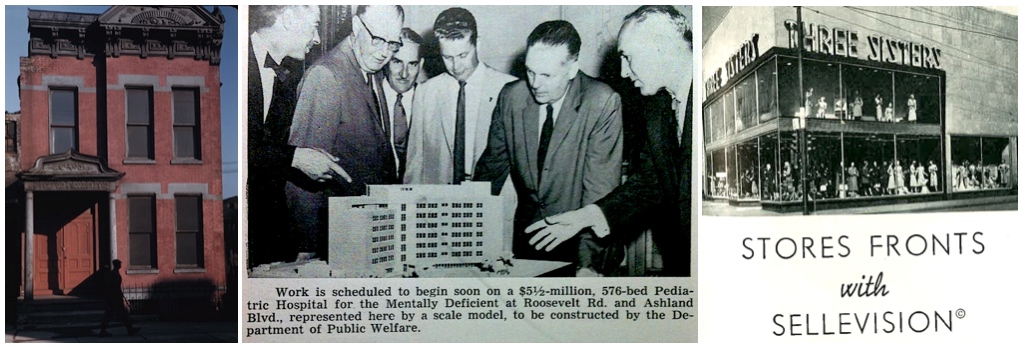
Left: Charles Cushman Archive, 1949 Center: Realty and Building, 1958 Right: Brasco Manufacturing Co. Ad, Architectural Record, 1949
A sold-out group joined Forgotten Chicago for our first public tour of Chicago’s fascinating West Side on Sunday, April 27, 2014. During this tour, we discussed how Chicago’s Jewish community and other groups built a vibrant system of local institutions and businesses that were influential far beyond Chicago. Also explored were the changes to the West Side since World War II and the many remnants of this area, such as the Madison and Pulaski (formerly Crawford) shopping district, including the now-altered 1948 Three Sisters retail store by Leichenko & Esser, above right.
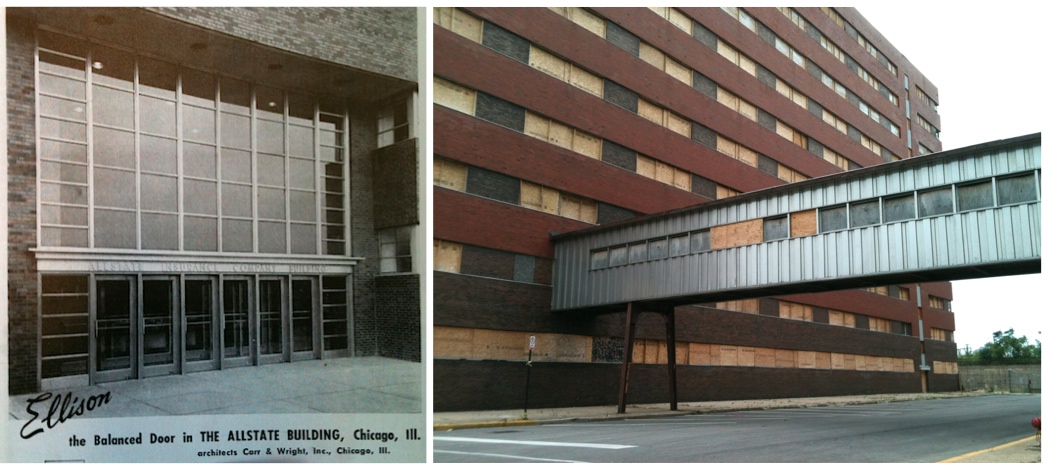
Left: Ellison Bronze Co. Ad, Progressive Architecture, 1950 Right: Patrick Steffes, October 2012
Also discussed were how key Chicago institutions such as Sears, Allstate Insurance, Hull House, WLS radio and the University of Illinois at Chicago were key to the development of the West Side, and what remains of these sites today. Noted was Carr & Wright’s 1949 former Allstate Insurance headquarters, now abandoned and deteriorating, one of the first major Chicago commercial buildings built after World War II. This tour examined more than sixty sites, including areas of urban renewal and land clearance, construction of the area expressway system, public housing, municipal parking garages, the numerous hospitals on the West Side, and many overlooked modernist landmarks.

Left: Patrick Steffes, September 2013 Right: Illinois Bell Classified Telephone Directory, 1951
Forgotten Chicago gave a presentation to a capacity crowd on Wednesday, April 2, 2014 about how we conduct our research for tours, presentations, and articles. The lecture was conducted at co-working space CivicLab at 114 North Aberdeen Street, located in an old Chicago fire station; CivicLab is dedicated to “collaboration, education and innovation for civic engagement,” and was a perfect venue for an FC presentation. We shared many of our research methods using both online and library resources, including the Newberry Library’s nearly complete collection of telephone directories starting in the 1920s that allowed us to make a complete list of former national shoe retailer Feltman & Curme, including their former location at 4049 North Milwaukee, shown above.
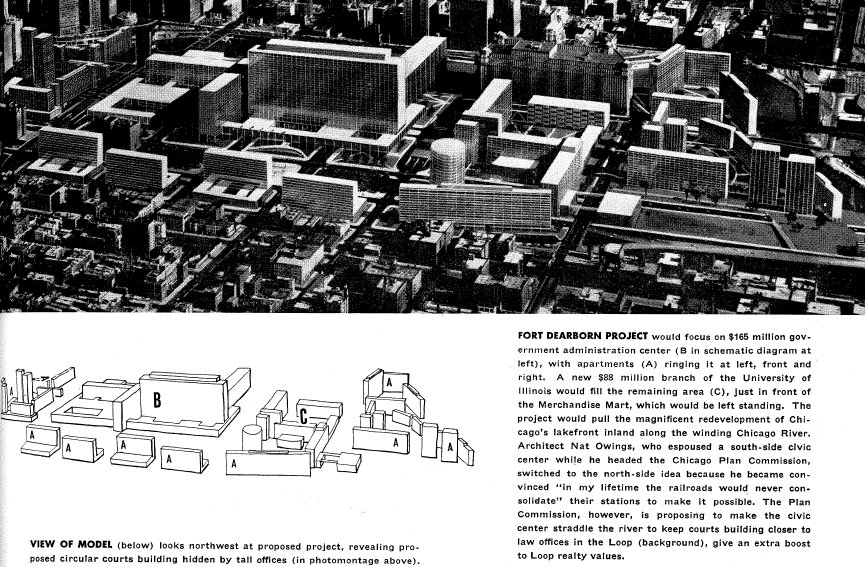
Architectural Forum, 1954
Our presentation also took a close look at how plans for Chicago’s civic and governmental buildings have changed and evolved over the years. We discussed how some city leaders and leading institutions, including retailer Carson Pirie Scott, were nearly obsessed in the 1950s with wholesale demolition of vast regions of the central area for civic redevelopment in both the West Loop and River North, including the massive Fort Dearborn project, seen above. We closed with a look at some of the resources available to research the Chicago area’s built environment and history, as well as a sneak peek at an upcoming FC article detailing our recent research finds.

Left and Center: Chuckman Collection Right: Realty and Building, 1978
A standing-room-only crowd of 45 guests joined Forgotten Chicago on Saturday, December 7, 2013 for a free presentation focusing on the overlooked history of Back of the Yards and environs. Held at the new Back of the Yards branch of the Chicago Public Library, which opened in August 2013, this presentation covered the long and complex history of the area around the famed Chicago Stockyards, which closed in 1971 but has a surprising number of remnants remaining. The presentation covered the history of the Yards, its architecture, and some of the other industries that once located in the area — including the country’s first industrial park.
More than 100 little-seen images were included and discussed, including the sole bar that remains open along South Ashland Avenue’s famed “Whiskey Row” above center. This presentation delved deeply into the history of and interactions between the Chicago Stockyards and the surrounding neighborhood, including ethnic history, overlooked neighborhood architecture, retail relics, and other oddities and remnants. Also discussed were unrealized plans for the area, such as developer Harry Chaddick’s plans for a major shopping center in the area above right.
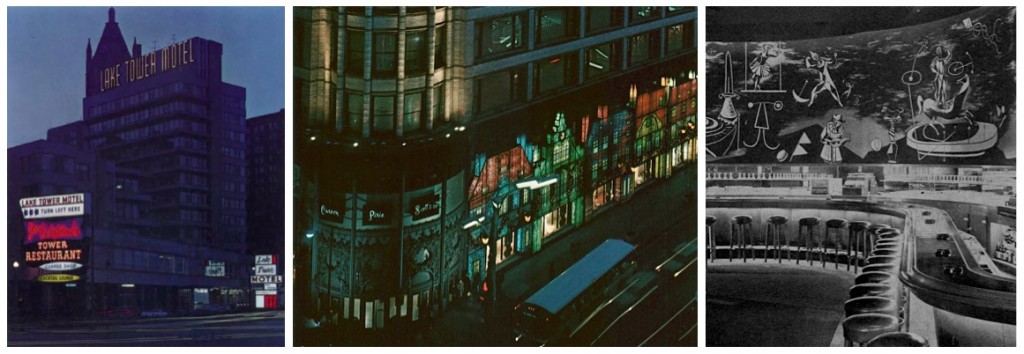
Left: White Way sales brochure, no date Center: Pleasant Family Shopping Right: Architectural Record, 1948
On the day before Thanksgiving 2013, WGN Radio 720 AM’s Bob Sirott and Marianne Murciano interviewed Jacob Kaplan and Patrick Steffes on Forgotten Chicago’s six years of research, presentations and tours. The wide variety of topics related to Chicago’s overlooked built environment discussed included Bob Sirott’s memories of the long vanished Henrici’s at the Merchandise Mart, above right, Carson Pirie Scott’s once elaborate Christmas displays at their State Street flagship, which celebrated its last holiday season in 2006 seen above center in 1971, and the mostly vanished Shoreline Motels, explored in a series of four Forgotten Chicago articles, above left. Bob and Marianne’s entertaining interview may be heard in its entirety on the WGN Radio 720 AM web site.
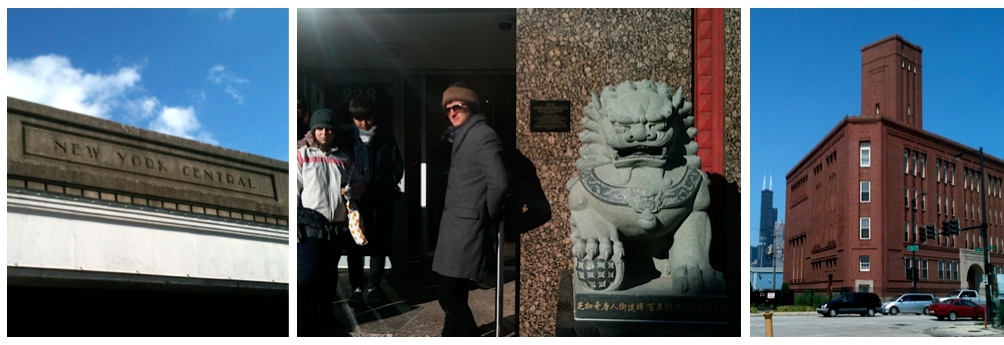
Patrick Steffes
Forgotten Chicago’s third tour of Chinatown and environs was conducted for students of the University of Chicago on a brisk fall day on Saturday, November 23, 2013. The many sites covered included a railroad viaduct over Cermak Road built in 1937 using federal WPA funds, and once used by the New York Central and Rock Island Lines railroads. Although these venerable names in transportation history disappeared in 1968 and 1980, respectively, their names are still visible over Cermak Road today. The long industrial and manufacturing history of the area west of Chinatown was discussed, including the 111-year old former Schoenhofen Brewery powerhouse above right, written about by Forgotten Chicago in 2008.
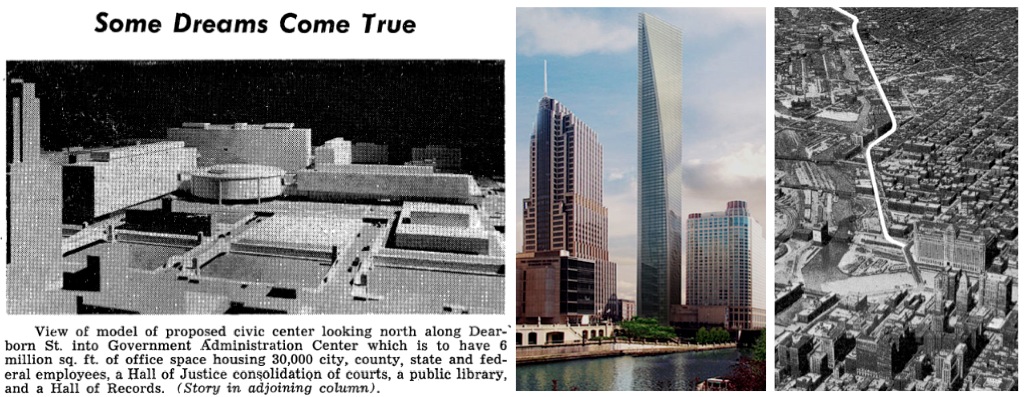
Left: Realty and Building, 1954 Center: Wikipedia Right: Limited Ways: A Plan for The Greater Chicago Traffic Area, 1933
Decades of unrealized and little-known projects was the focus on an all-new and exclusive Forgotten Chicago presentation on Unbuilt Chicago for Mather Lifeways on Friday, November 15, 2013 Utilizing FC’s proprietary database of thousands of images, articles and ephemera taken from decades of non-digitized publications, Chicago’s post-World War II obsession with attempting to demolish vast sections of the central city was discussed, including the ill-fated 151-acre Government Administration Center, above left.
Also discussed were the many ambitious supertall buildings announced in the previous decade, including the 107-story Waldorf-Astoria Hotel and Residence Tower project, announced in 2007. Another project discussed were the many 1933 city plans for a series of elevated and limited access roadways, including one heading northwest from the Merchandise Mart, above right. A similar and now-demolished viaduct travelling over Goose Island and the Chicago River was discussed by Forgotten Chicago in 2009.
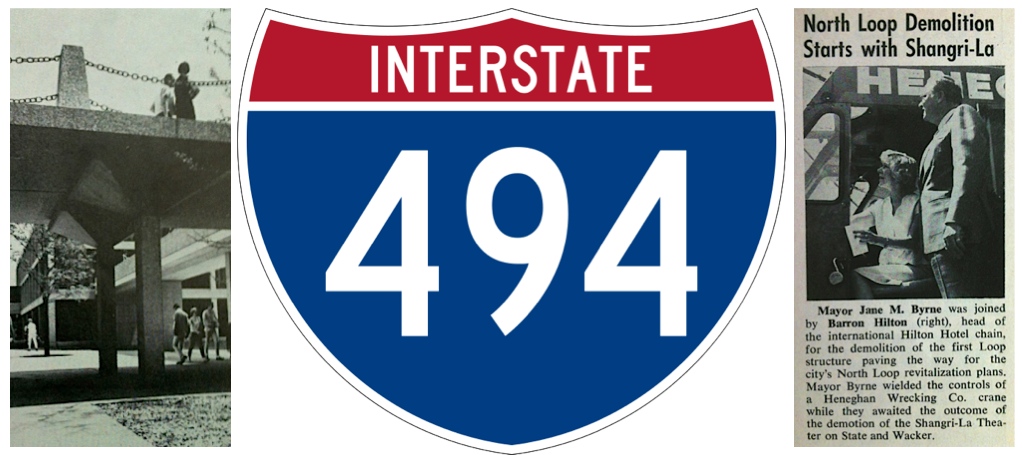
Left: Inland Architect, 1965 Center: Wikipedia Right: Realty and Building, 1981
An overview of planning in Chicago was the focus of Forgotten Chicago’s presentation to the University of Illinois at Chicago’s Urban Planning Alumni Association on Wednesday, November 13, 2013. Seen above left is a section of the “sidewalks in the sky” which once connected multiple buildings on the UIC campus; these were removed in a renovation in the early 1990s. The long and ultimately unsuccessful battle to build the Crosstown Expressway (Interstate 494) was discussed, as well as other unbuilt limited access roadways in the region.
Less well known than the notorious Block 37, and mostly forgotten today, was the city-led redevelopment of Blocks 16 and 17 in the North Loop, covering the two blocks bounded by State, Clark, Lake and Wacker. Above right, Mayor Byrne is seen above demolishing the pornographic Shanrgi-La Theater in 1981 to begin redevelopment of this site. This block was also the site of Chicago’s first Municipal Parking Garage by Shaw Metz & Dolio, completed in 1955 and privatized during the Byrne administration.
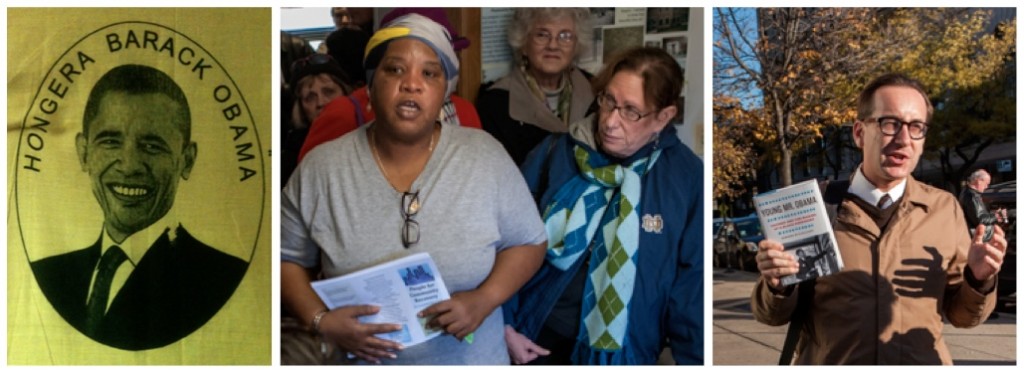
Left: Patrick Steffes Center and Right: Matthew Kaplan
Five years after the November 2008 election of Chicago’s Barack Obama as President of the United States, Forgotten Chicago, Pullman-area native Tom Shepherd, and The Public Historian Cynthia Ogorek presented a first-ever bus tour of sites crucial to the rise of Barack Obama in Chicago in the years before his move to the White House. On Sunday November 10, 2013 this exclusive tour visited many of the sites that helped shape Obama and his historic rise to the presidency between 1985 and 2008, including his early role as a community organizer.
Some of the many sites visited on this tour included Altgeld Gardens, where resident Cheryl Johnson above center, the Director of People for Community Recovery, described how Obama would visit their home to help organize residents improve living conditions at this Far South Side CHA community. Chicago author Edward McClelland also offered the group insights on Obama’s early Chicago life and career, as described in his 2010 book “Young Mr. Obama” above right.

Left: Patrick Steffes Right: Matthew Kaplan
This tour also made a stop in Pullman, where participants visited Reformation Evangelical Lutheran Church and heard from Reverend Joel Washington and Ada Scott, two local residents who worked closely with Obama, and are currently compiling an oral history project on Obama’s early community organizing work in Pullman. The group ended the tour in Hyde Park, above, where the group enjoyed lunch at Valois, one of the presidents favorite restaurants, and a walking tour including Obama’s barber shop above left, as well as the location of Barack and Michelle Obama’s first kiss. The usual visits to forgotten and overlooked sites included a former synagogue in Pullman, and Chicago modernist architects George Fred and William Keck’s 1948 “essential services building” in Altgeld Gardens. Both The Chicago Tribune and CBS Chicago reported on this tour.

Left: Chain Store Age, 1943 Right: Realty and Building, 1954 Right: United States Geological Survey, 1938
Nearly 60 people learned more about the forgotten history of Rogers Park and West Ridge in a free presentation held on Tuesday, November 4, 2013 at the Northtown Branch of the Chicago Public Library. Sites discussed included the large number of intact commercial buildings in the area, including the former Hillman’s Pure Foods store by Leichencko and Esser, above left. Also discussed was purportedly Chicago’s first solar home from 1954, seen above center, along with the long and scandalous history of the current Warren Park, first discussed by Forgotten Chicago in 2010. The local web site DNAInfo Chicago posted an article on our presentation with an extensive slide show the following day.

Patrick Steffes
Forgotten Chicago helped the landmark Sears store at 6 Corners celebrate its 75th anniversary with two exclusive tours on Sunday, October 13, 2013. These sold-out tours offered guests behind-the-scenes access to one of the largest extant department stores in the Midwest, in FC’s first tour to focus on a single building. Led by Dale Harris, a Sears contract employee since the late 1960s and the head of the store’s 75th anniversary celebrations, a tour highlight was a visit inside the store’s massive two-story former display window at the corner of Milwaukee, Cicero and Irving Park, seen inside and out above center. This tour also included a trip down the store’s grand Art Deco “marble staircase” that has been sealed off for decades, back-of-the-house stockroom and employee functions, and remnants of the former Hillman’s grocery store that operated in the store’s lower level from 1938 to 1967.

Patrick Steffes
Forgotten Chicago’s encore tour of Chinatown was conducted in association with the Chicago Chinatown Chamber of Commerce on a beautiful fall afternoon on Sunday, October 6, 2013. Forgotten Chicago Co-Founder and Editor Jacob Kaplan above left led the group to Sun Yat-Sen Playlot Park, a popular park adjoining the Stevenson Expressway; FC first wrote on some of these curious 1970s-era Expressway Parks in 2008. Also explored was Chinatown’s long and complex social history, early industry, and challenges being constrained by transportation infrastructure. This tour also discussed local landmarks, including Chinatown Square by Harry Weese & Associates above right, built on a former Santa Fe Railroad yard in the early 1990s. Following the tour, guests were able to enjoy an optional lunch at Phoenix Restaurant.
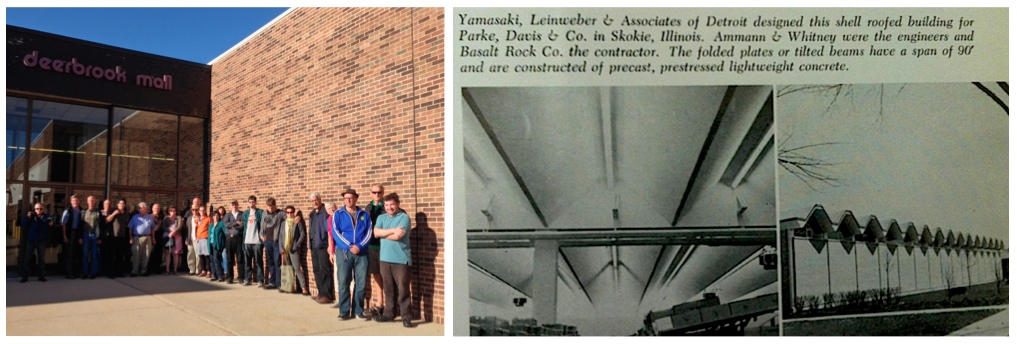
Left: Patrick Steffes Right: Inland Architect, 1962
No fewer than 75 sites in twelve municipalities were explored during Forgotten Chicago’s inaugural “Corporate Kings of the Suburbs North” bus tour, held on a sunny afternoon on Sunday, September 29, 2013. Using an air-conditioned 55-passenger motor coach to cruise the north suburbs in style, we explored corporate, manufacturing, retail, housing and transportation sites in the northern suburbs. Sites explored included an interior look of the Deerbrook Mall in Deerfield, a 1973 indoor mall with a nearly intact interior.
Also explored was a 2012 Forgotten Chicago discovery, a virtually unknown commission by one of the most overlooked architects of the twentieth century, Minouri Yamasaki, architect of New York City’s original World Trade. Originally built for Detroit-based pharmaceutical giant Parke-Davis, this former office and warehouse was nearly completely intact until significant exterior alterations recently began; we took a look at these changes on this tour.
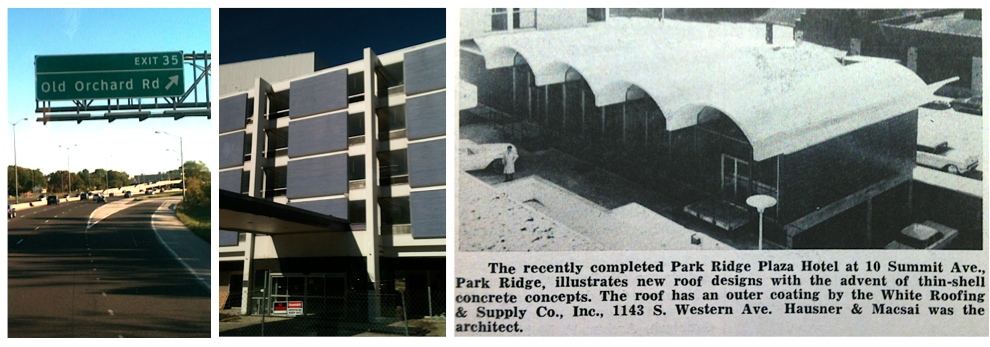
Left and Center: Patrick Steffes Right: Realty and Building, 1960
Exploring decades of development, construction and change in the region, we drove past Hausner & Macsai’s distinctively purple former Hyatt House in Lincolnwood above center currently undergoing demolition. We also took a look at a lesser-known project by the same firm, the former Park Ridge Plaza Hotel, still featuring its distinctive thin-shell roof. We discussed the 30,000 abandoned “dead land” residential lots that plagued Skokie starting in the 1920s until well into the middle of the twentieth century, former and current corporate headquarters, award-winning architecture, early retail landmarks including the first Kmart in the Chicago area, the remains of a Roaring Twenties airport in Northbrook, and much, much more.

Left: Dave Gudewicz Center: Patrick Steffes Right: The 606
A sold-out crowd joined Forgotten Chicago Contributor Terry Banich (above left) and Sarah Morton of The Trust for Public Land on Sunday, September 15, 2013 for FC’s tour of the former Bloomingdale Line, being repurposed into The 606 beginning in 2014. Terry’s exhaustive research for his article, one of our most popular in our history, was the basis for this exclusive tour, offered by Forgotten Chicago for the first time. This tour took an in-depth look at the area around this former elevated freight rail line, including colorful murals, former and current industrial facilities, and many of the neighborhood oddities seen on every FC tour.

Left: The 606 Right: Patrick Steffes
A ground breaking for The 606 occurred in August 2013; this tour examined the Bloomingdale Line in its current state prior to the start of construction on this $91 million park. Besides the Bloomingdale Line, this tour also examined remnants of the Damen Junction of the former Humboldt Park Branch of the “L” that (mostly) vanished more than 50 years ago, also researched in-depth by Terry here. Additionally, this tour examined many other overlooked curiosities, including the factory that made the drums used by The Beatles during their 1964 American television debut, a former ice skate factory, and a nearly 100-year old parking garage still facing Humboldt Park.

The Belt Railway Company of Chicago
On Sunday, September 8, 2013, in association with the Clear-Ridge Historical Society, guests enjoyed a rare guided tour of the normally off-limits Clearing Yards, the largest switching terminal railroad in the U.S., and a key part of the nation’s transportation infrastructure. Spanning more than five miles and nearly 800 acres south of Midway Airport, guests were able to appreciate the vast size of the Clearing Yards from the inside during this fascinating tour. We also drove directly under the “hump” that uses gravity to move trains downhill onto their correct track.

Left: Forgotten Chicago collection Center: Chicago Tribune Right; Patrick Steffes
This quickly sold-out tour also explored other overlooked sites, including an abandoned and deteriorating 1959 bank by famed Chicago architect Harry Weese above left, and a unique 1937 factory above center by Fred Foltz that curiously featured a rooftop dance floor. Little studied but an integral part of the history of Chicago, the 1900 Clearing Industrial District is one of the earliest and most important examples of a planned industrial park – the predecessor to the suburban industrial parks now commonly found along the Interstate Highway System. Many thanks to he Clear-Ridge Historical Society, The Belt Railway Company of Chicago, and to the participants on our tour!

White Way sales brochure, no date
On Thursday, September 5, 2013 more than 75 guests enjoyed a free, encore presentation of Forgotten Chicago’s “The Overlooked Loop” in conjunction with Friends of Downtown at the Chicago Cultural Center. We explored everything from the first major office building completed in the central area since the Great Depression, Holabird & Root & Burgee’s 1954 Sinclair Oil Building on Wacker Drive below left, completed one year before the better-known Prudential Building on Randolph Street, and now demolished.

Fourth from Right: Day-Brite Lighting Fixtures Ad, 1955 Third from Left: Chain Store Age, 1933 Second from Right: American Architect, 1932 Far Right: White Way sales brochure, no date
Forgotten Chicago also shared some of our exclusive database of images, including the Art Deco Wise Shoe Store on State Street third from right, one of many lesser-known retailers in the Loop. Additionally, we explained how Chicago has long been an innovator in parking, including the first vertical “parking machine” second from right on Monroe Street. Finally, we shared many images of overlooked buildings still extant, including the 1949 former Bond Clothing Store far right by 1949 Friedman Alschuler & Sincere with Morris Lapidus, altered but still standing today.

Left and Right: Dave Gudewicz Center: Patrick Steffes
In a sold-out tour on Sunday, August 25, 2013 Forgotten Chicago conducted our first Cable Car Remnants Bus Tour, led by Chicago author and historian Greg Borzo, above left. Almost completely forgotten until the publication of Greg’s book in November 2012, Chicago once had, in terms of passengers and equipment, by far the largest cable car system the world has ever seen, with more than one billion total rides. This tour, offered for the first time by any organization, closely examined sites associated with this remarkable system, including an interior visit to an 1893 former cable car waiting room in Hyde Park above center, now home to the Hyde Park Historical Society. Above right, tour guests also received an up-close examination led by Greg of a cable car replica housed at the Museum of Science and Industry.

Left: Roy G. Benedict | Publishers’ Services Right: Courtesy of David Clark
This tour traveled extensively to visit other sites associated with this system, including a drive along an original cable car “Loop”, two former powerhouses, a former cable car barn, the site of one of two tunnels that carried cable cars under the Chicago River, historic bridges, and many other overlooked sites featured on every Forgotten Chicago tour. The tour exited the bus several times for photographs and questions for Greg, whose encyclopedic knowledge of Chicago’s cable car system made for a memorable and very enlightening tour. Greg’s Chicago Cable Car Remnants article may be read here.
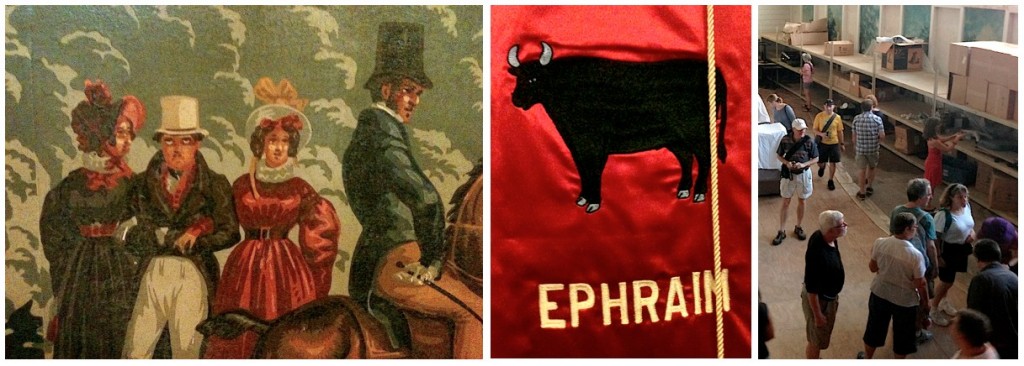
Left & Center: Patrick Steffes Right: Jacob Kaplan
The overlooked and the very forgotten was the focus of Forgotten Chicago’s first tour of Evanston on Sunday, August 18, 2013 and held in conjunction with Downtown Evanston. A near-capacity crowd enjoyed two exclusive interior visits, including a tour of Evanston’s monumental Masonic Temple and the Hilton Orrington Hotel’s long-closed indoor swimming pool. Above left is a portion of the Masonic Lodge’s hand-painted English wallpaper dating from the building’s completion in 1926. Above center is one of the Lodge’s ceremonial flags inside this opulent building that has many of its furnishings intact from its completion. Seen above right, guests were able to examine and photograph the many intact details of the Hilton Orrington’s large indoor pool and intimate bar overlooking the pool, which closed in 1972. The outline of the still-intact pool may be seen on the floor above right.

Left: Architectural Record, 1937 Right: Patrick Steffes
In addition to Evanston’s unique history, thriving downtown, and its 121 years prohibiting the sale of alcohol, our tour examined office buildings, condominiums, churches and long-gone department stores by architects such as Barancik, Conte & Associates, David Hovey, Marion Mahony, Hausner & Macsai, and Shaw, Metz & Dolio. We also closely examined the 1936 former Marshall Field’s parking structure and Firestone service station (above left), still extant today, as well as the crucial role parking has been to downtown Evanston merchants for decades. Additionally, we took a look at how downtown Evanston thoroughly reinvented itself after the opening of Old Orchard Mall in neighboring Skokie 1956, its many intact and forgotten landmarks, and its dramatic transformation in the twenty-first century.
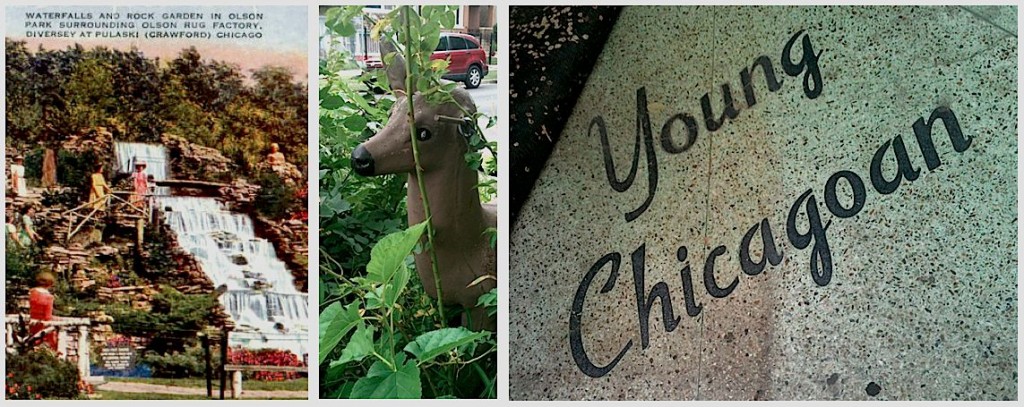

Top left: Chuckman Collection Top center and right: Patrick Steffes Bottom: Chicago Tribune
Forgotten Chicago’s first exploration of the utterly forgotten Pennock industrial village, industrial corridors west of Logan Square, and the area around Kosciuszko Park was held on Sunday, August 11, 2013. Besides the large number of industrial facilities located surprisingly close to residential areas, this tour explored many other overlooked sites in this neighborhood. Top left is the former Olson Rug Park and Waterfall, which delighted generations of young and old Chicagoans from 1935 into the late 1960s. At top center is what may be one of the only remnants of the waterfall, a concrete deer perched in a nearby front yard. Top right is one of the many terrazzo entryways still extant along Milwaukee Avenue for long-vanished retailers. Forgotten Chicago also located and pointed out several of the remaining houses built as part of the doomed Pennock, Illinois, along with architectural oddities and other curiosities in Pennock and the “Land of Koz.”

Patrick Steffes
The inaugural Forgotten Chicago’s tour of Chinatown was conducted in association with the Chicago Chinatown Chamber of Commerce on a sunny afternoon on Sunday, August 10, 2013. This sold-out tour focused on the many overlooked aspects of this fascinating neighborhood, including its history as a large Italian settlement. Above left is a Chinese guardian lion in front of the cornerstone of the 1904 Madonna Incoronata Church, now the St. Terese Chinese Catholic Mission. Above center, guests explore the Lumber Street area, the former home of numerous paint factories, and the site of the company that invented the first electric popcorn popper. Above right is the first of a new series of boathouses along the Chicago River in the new section of Ping Tong Park; this facility opened in June 2013. Following the tour, guests were able to enjoy an optional lunch at Phoenix Restaurant.
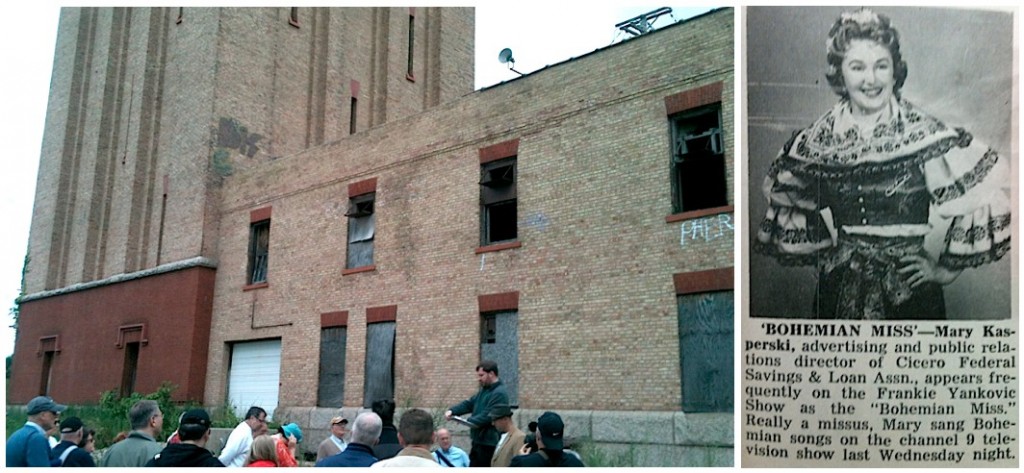
Left: Patrick Steffes Right: Realty and Building, 1956
Forgotten Chicago’s first walking tour exploring the fascinating communities of Cicero and Berwyn was presented to a sold-out group on Sunday, July 28, 2013. Above left, the group pays a visit to one of the only remnants of the vast former Western Electric / AT&T Hawthorne Works, which once produced every Bell System telephone in the U.S. This staggering 110-acre complex contained nearly 6,000,000 square feet of space, 50% more than the Merchandise Mart, and at its peak employed 43,000 people. At right, the tour also explored the long legacy of locally owned financial institutions along Cermak Road, long known as “Bohemian Wall Street.”
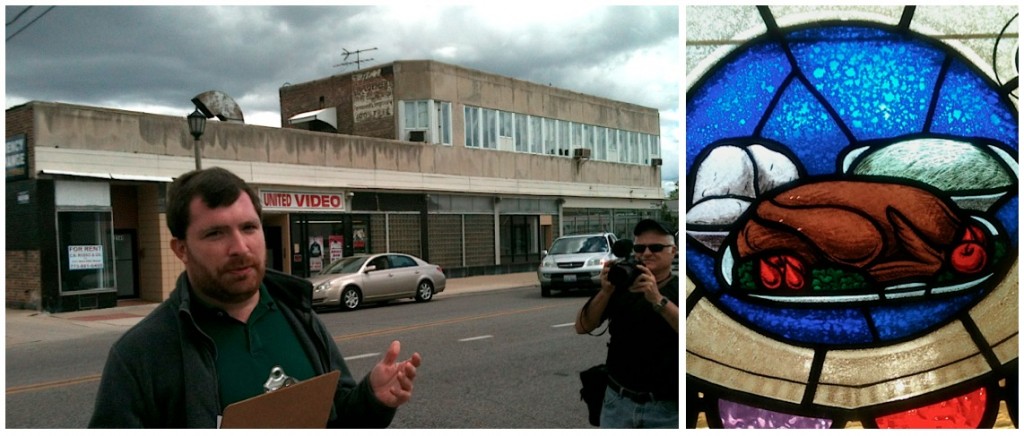
Patrick Steffes
Forgotten Chicago Editor and Co-Founder Jacob Kaplan shows the group one of the most intact and little-known art deco gems in the region – the 1931 Medical Arts Building by Walter Conley and D. W. Carlson. Barely visible above center is a curious ghost ad that states in part, “Employment for Working Girls Permanent & Temporary 100% Free.” At right, guests also enjoyed an exclusive interior tour of Klas, an old-school Czech restaurant serving delicious Bohemian food on Cermak Road for more than 90 years.
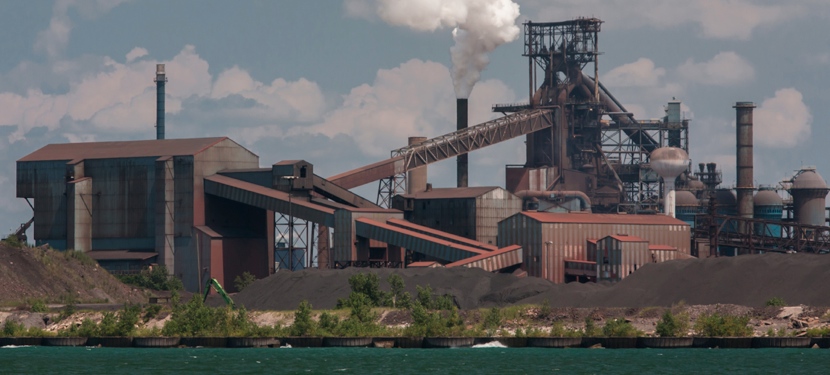
Matthew Kaplan
On Sunday, July 21, 2013 a sold-out group enjoyed what may have been the first public tour of the Indiana Harbor Canal in East Chicago in decades. Although virtually unknown, the Indiana Harbor Canal is a vital component of the billions of dollars in annual economic output in the Chicago area, and home to the largest steelmaking complex in North America.
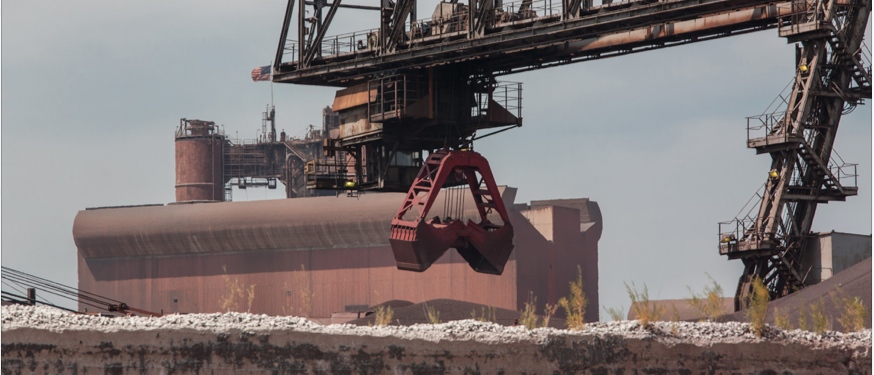
Matthew Kaplan
Our five-hour boat tour set sail at noon under sunny skies from Burnham Harbor. Besides the Indiana Harbor Canal, we took a look at Graham Anderson Probst & White’s 1929 State Line Generating Station, which featured the world’s largest turbine generator when built, and has been closed and threatened with demolition since early 2012; the U. S. Steel Company’s massive former South Works, slated to be redeveloped as a residential and commercial district; and BP’s expansive Whiting Refinery, previously explored in a sold-out FC Calumet Region bus tour in April 2013.
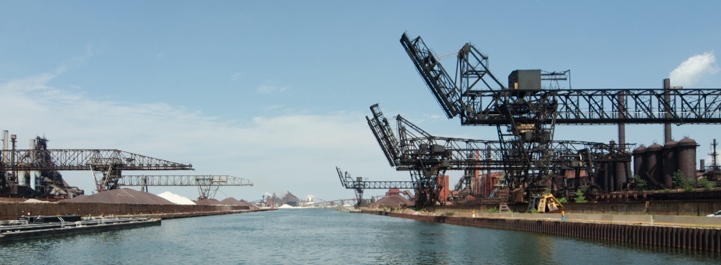
Serhii Chrucky
Besides an extensive lunch buffet and unlimited beer and wine, guests enjoyed an exhaustively researched tour and a souvenir 10-page guide featuring images from the archives of Indiana University Northwest in Gary. Once home to some of the largest employers in the Chicago area – Inland Steel, LTV Steel, Youngstown Sheet and Tube, and Standard Oil (Indiana), the area on and around the canal is now home to global companies ArcelorMittal, BP, and others. Some of the sights visible from the boat included blast furnaces, rolling mills, rows of bascule bridges, and a stunning panorama of enormous ore unloaders (above).
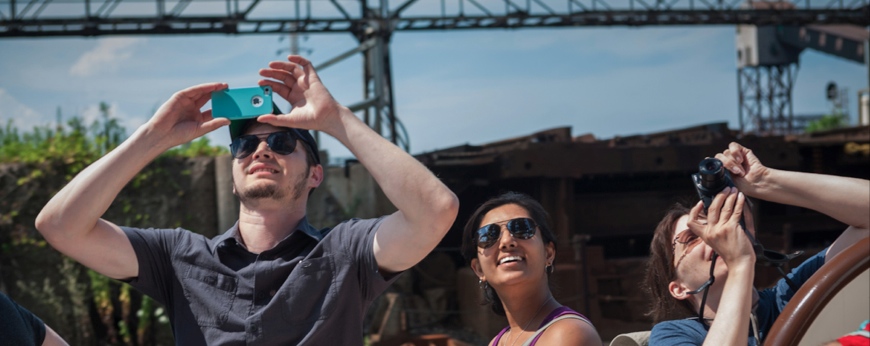
Matthew Kaplan
After six seasons of Forgotten Chicago tours, the Indiana Harbor Canal is by far the most forgotten location we’ve explored to date. Nearly all of the 120 guests on this tour, many of them avid Chicago-area explorers for decades (including the captain of our charter boat) had never been on this waterway prior to our cruise. Due to high demand, we are planning to visit this incredible area again in the future. Many thanks to everyone who joined us on this tour!
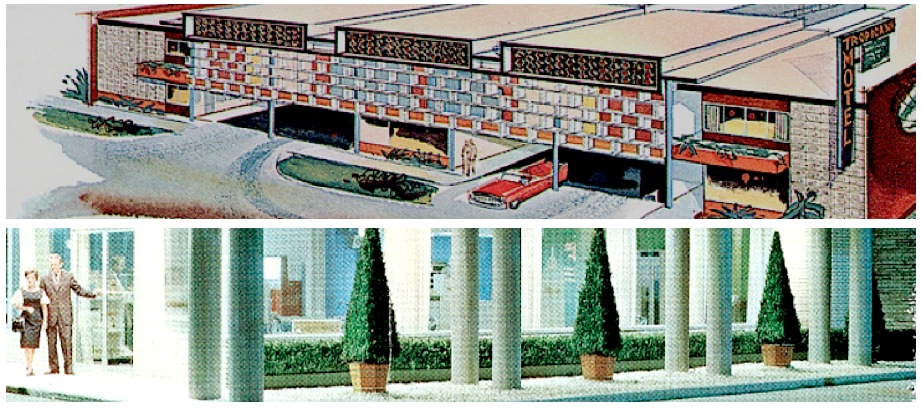
Top: Chuckman Collection Bottom: Courtesy Edgewater Historical Society
A standing-room-only crowd of 85 people enjoyed an encore presentation of the little-known history of Chicago’s Shoreline Motels on Saturday, July 20, 2013 on behalf of the Edgewater Historical Society. Held in the newly rebuilt Edgewater Public Library, we covered motels from the far north side in Rogers Park to the South Shore community, with a particular focus on the four properties built in Edgewater. This presentation looked closely at why this type of accommodations flourished so briefly on or near Chicago’s lakefront, and what remains of these forgotten motels in 2013.
Utilizing some recent discoveries, including a rare brochure recently acquired by the Edgewater Historical Society of the short-lived Tides Motel, this presentation included dozens of non-digitized images, articles, and ephemera related to this curious category of accommodation. Guests also learned more about Forgotten Chicago’s exclusive 2013 season, upcoming events, and the vast array of research information and links available on our web site.
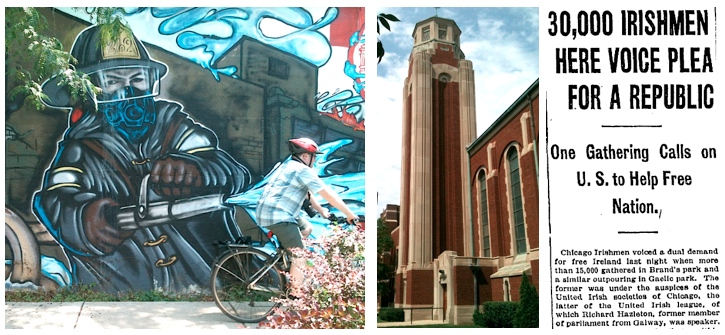
Left and Center: Patrick Steffes Right: Chicago Tribune
Forgotten Chicago conducted our first biking tour of the dynamic Avondale neighborhood under sunny skies on Sunday, June 23, 2013. Conducted by Jacob Kaplan and Dan Pogorzelski, two of the authors of the forthcoming book Images of America: Avondale and Chicago’s Polish Village, guests enjoyed a wide variety of Avondale’s fascinating and often-overlooked sights, including early factories, historic political landmarks, former movie theatres, and a sampling of Avondale’s many iconic religious buildings.
Above left, a tour participant rides past a recent addition to Avondale – a mural dedicated to Chicago Fire Department Company 106 painted on an extant retaining wall of the former electric railroad built by Commonwealth Edison more than 100 years ago. Above center is St. Wenceslaus Church, a rare Chicago Art Deco-inspired church completed during World War II. At right is a 1917 newspaper article about one of many utterly forgotten political rallies held at Brands Park, a vast former beer garden built by the owner of the recently demolished Brand Brewery complex.

Left: Dave Gudewicz Center and Right: Patrick Steffes
Forgotten Chicago returned to the fascinating and little-explored Jefferson Park neighborhood on Sunday, June 9, 2013 in a sold-out walking tour in association with the Northwest Chicago Historical Society, examining nearly 40 local landmarks, many very forgotten. Seen above left: although the Jefferson Nickelodeon only operated on North Milwaukee Avenue from 1914 to 1917, its one-time name is still prominently spelled out in brick more than 95 years after this early movie theatre closed.
Above center, Forgotten Chicago co-founder and editor Jacob Kaplan points out the nearly intact former 1941 art moderne Charles Bruning factory on West Montrose Avenue, designed by prolific local architect Victor L. Charn and first explored by Forgotten Chicago in 2009. Above right, tour participants view the dramatic cut made by the Northwest (now Kennedy) Expressway, forever changing Jefferson Park prior to and after its opening in 1960. This tour examined many other aspects of the neighborhood, including local institutions, the area’s large and influential ethnic communities, real estate booms, curious housing stock, and other forgotten oddities. Also examined in depth was the role that public transit, including streetcars, commuter rail, and CTA rail after 1970 all played in the development of the unique community of Jefferson Park.

Left: Charles Cushman Archive, 1949 Center: Realty and Building, 1966 Right: Chuckman Collection, no date
On Sunday, June 2, 2013 Forgotten Chicago conducted a private bus tour of Chicago’s Jewish West Side for the Decalogue Society of Lawyers. This thoroughly researched tour included many known, along with many forgotten, current and past landmarks of this area. Using Forgotten Chicago’s vast database of more than 12,000 mostly non-digitized and non-catalogued articles, images and city plans, this tour delved deeply in the area’s extensive Jewish history of settlement, commerce and religious and social institutions. We also visited other aspects rarely discussed during Chicago tours, including urban renewal, construction of the area expressway system, public housing, municipal parking garages, overlooked modernist landmarks, and former local retailers.
Also explored was the University of Illinois and their aggressive expansion and urban dislocation, especially related to the controversial removal of Maxwell Street. Seen above center is a slum clearance scheme published in 1966 showing the planned removal of this legendary street from Blue Island to the Dan Ryan Expressway; the buildings on Maxwell Street east of Halsted would not be cleared for another 30 years. At left is one of the many color Charles Cushman images from the 1940s shared during the tour; this 1901 synagogue was located near the intersection of Maxwell and Halsted. At right is what remains of the still remarkably intact commercial shopping district at Madison and Crawford (now Pulaski); successful and long-gone local retailers, many Jewish owned, were also discussed during this tour.

Left: Patrick Steffes Center: Jerzy “George” Skwarek Right: Google Maps
On Thursday, May 23, 2013 a standing-room only crowd of over 50 guests enjoyed an exclusive Forgotten Chicago presentation on the history of Chicago’s dynamic and ever-changing Avondale neighborhood. Held at the Logan Square branch of the Chicago Public Library, the presentation was given by Jacob Kaplan and Dan Pogorzelski, two of the authors of the book Images of America: Avondale and Chicago’s Polish Village, published in July 2014.
Delving deeply in the past and present of this fascinating and often-overlooked community, this presentation covered Avondale’s ethnic communities (including the large and influential Polish population, once commemorated in long-vanished street signs above center), industry past and present, political powerbrokers, and the nearly forgotten nightclubs and music venues once filled with “holidaymakers” who would work in Avondale for a short time and then return to the Eastern Europe. Also examined was the demolition and disruption the Northwest (now Kennedy) Expressway caused in Avondale, including to its namesake park, seen above right.
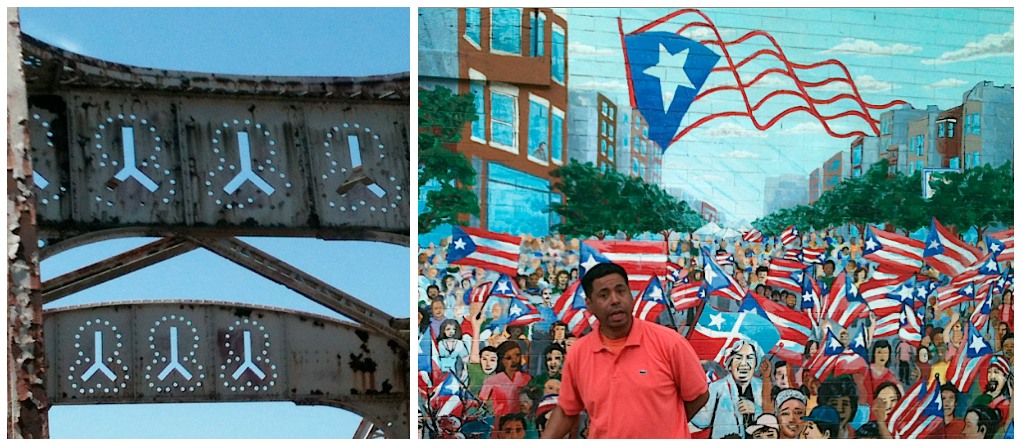
Patrick Steffes
Many thanks to participants of our first-ever walking tour to focus on a single thoroughfare, Chicago’s fabled and ever-changing Division Street. Our sold-out tour was held on Sunday, May 19, 2013 in conjunction with Paul Durica and Pocket Guide to Hell, exploring this seminal thoroughfare in-depth, with its myriad identities from Paseo Boricua to “Polish Broadway.”
One of the many highlights of our Division Street tour was the unique 109-year old Studs Terkel Memorial Bridge just west of Halsted Street, which would be demolished in July 2014. Above right, Eduardo Arocho, Executive Director of the Division Street Business Development Association gave the group an in-depth overview of the significant contributions of the Puerto Rican community to Division Street and Chicago. Other highlights included the former site of Cabrini-Green high-rise apartments, industrial remnants, an interior tour of the Chopin Theatre, the lively Polonia Triangle, a pre-1909 street address marker, and a former Schlitz tied house tavern.

Dave Gudewicz
Forgotten Chicago’s inaugural out-of-state tour took place on Sunday, April 21, 2013 with a sold-out group traveling through the Calumet Region and exploring overlooked industrial, architectural and retail landmarks in Indiana and Illinois. The Industrial Might and Architectural Surprises bus tour shared some of our favorite sites, including the Universal Portland Cement building in Gary (above left), as well as the enormous and partially abandoned 1948 Standard Oil (Indiana) Research Laboratory in Hammond, one of the least-known works in the Chicago area by prolific local firm Holabird & Root & Burgee, seen above right.
In addition to highlighting the region’s vast industrial infrastructure past and present, this tour also visited the remarkable and endangered 1917 Marktown community in East Chicago, remnants of the mostly demolished Woodmar Mall in Hammond, and lesser-known works by Chicago-based firms Skidmore, Owings & Merrill, Helmut Jahn and Graham, Anderson, Probst & White. This tour concluded with a look at the recently closed State Line Generating Plant on the Illinois-Indiana border, and a drive past the sites of the two southernmost Shoreline Motels.


Top: Courtesy of Jacob Kaplan Bottom: Chuckman Collection
On Saturday, April 6th, 2013 Forgotten Chicago presented a free lecture to a standing-room only crowd at the Edgewater Historical Society on the history of Chicago’s Shoreline Motels. Examining this short-lived and all-but-forgotten chapter of Chicago’s hospitality industry, this presentation gave an overview of the 13 Shoreline Motels built on or near Lake Michigan, including the four built in the Edgewater community.
This presentation also gave a sneak peak to the fourth and final article in this Forgotten Chicago series, which explore these motels in the Hyde Park and South Shore communities. Because more than two-dozen people had to be turned away due to space constraints, we conducted an encore presentation on Shoreline Motels for an additional 85 guests in July.

Left: Realty and Building Right: American Terra Cotta and Ceramic Company Records (N 5), Northwest Architectural Archives, University of Minnesota Libraries, Minneapolis
Thirty-five guests had to be turned away when the presentation room in the Chicago Cultural Center reached its capacity of 125 for Forgotten Chicago’s lecture on The Overlooked Loop, given on behalf of Friends of Downtown on Thursday, February 7, 2013. Utilizing Forgotten Chicago’s vast archive of thousands of non-digitized articles and images, we enjoyed presenting a small sample of our many discoveries relating to central Chicago.
Top left, we revealed the forgotten 1955 plans by Carson Pirie Scott to abandon their Louis Sullivan-designed landmark and build a new store complex nearby; Carson’s would stay put at State and Madison until 2007. Below left, we discussed the 60-year old and dramatically cantilevered parking garage across from the Auditorium Theatre that is remarkably intact today, part of an enormous network of little-known parking garages built in central Chicago in the last 100 years. Above right, Alfred S. Alschuler’s 1937 Benson-Rixon store on South State Street remains standing today, though now altered.
Other highlights of this presentation included still-extant remnants of the early Loop, retail relics, early industry, overlooked (and sometimes abandoned) office buildings, building modernizations, and the “taxpayer blocks”, buildings meant to be temporary revenue-producing placeholders before a more substantial building can be built on the site in the future. Due to strong interest, Forgotten Chicago repeated this presentation in conjunction with Friends of Downtown in September 2013.
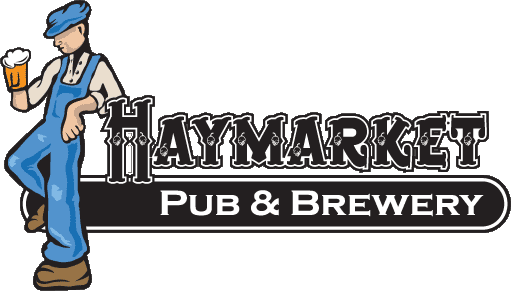
|
A lively crowd of 45 people joined Forgotten Chicago to celebrate our fifth anniversary on Tuesday, January 15, 2013. We reserved a private room at Haymarket Pub & Brewery at the corner of Randolph and Halsted in the West Loop.
Featuring complimentary appetizers, this free event offered a sneak peak at out 2013 season, and conducted a trivia contest based on our previous events, research and Chicago history. One question was “name three of the eleven breweries identified by Forgotten Chicago that built tied houses in Chicago before 1920” as seen in a popular 2009 FC article.
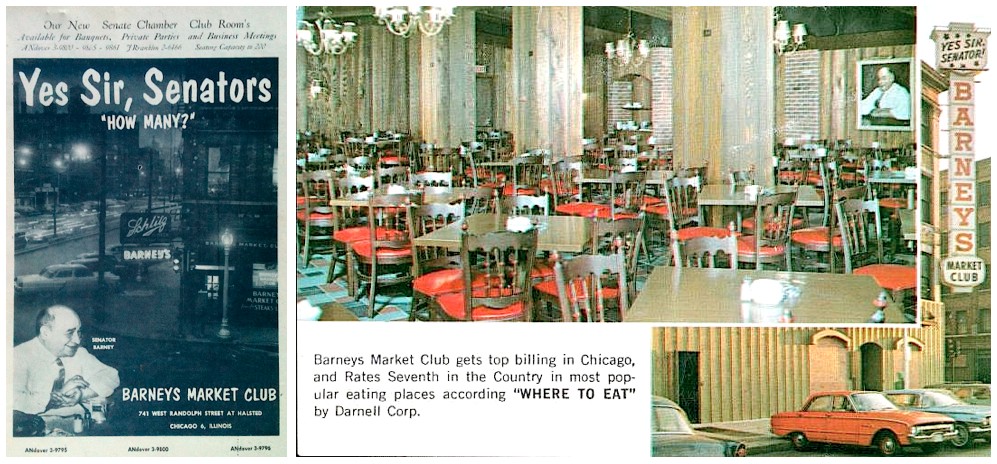
Left: Haymarket Pub & Brewery Right: Chuckman Collection
Legendary local journalist Rick Kogan, in a January 24, 2011 Chicago Tribune article, describes the colorful history of the long-term occupant of the current Haymarket Pub & Brewery, Barney’s Market Club. The full article excerpted below may be read here:
It was long assumed that its familiar slogan was born of the patronage of politicians. Though many elected officials (as well as mobsters, businessmen, cops and others on their way to and from events at the Chicago Stadium) were known to drop in, it was owner Barney Kessel’s inability to remember anybody’s name that gave birth to the slogan that eventually emblazoned menus, matchbooks and the prominent sign that hung high from the building. He called almost everybody “Senator.”
Many thanks to those who helped us celebrate!
- Chaddick Institute Webinar on Thursday, March 31, 2022: Sandbar to Skyscrapers: Cityfront Center and River East
- Westchester Library Webinar on Thursday, November 12, 2020: Presidential and First Lady Sites in Chicagoland
- Forgotten Chicago 2018 Event & Tour Season
- Chaddick Institute Chicago River North and West Walking Tour Sunday, September 25, 2022
- CPL Webinar on Thursday, October 7, 2021 – The Competition for the Harold Washington Library Center: 30th Anniversary Commemoration!

